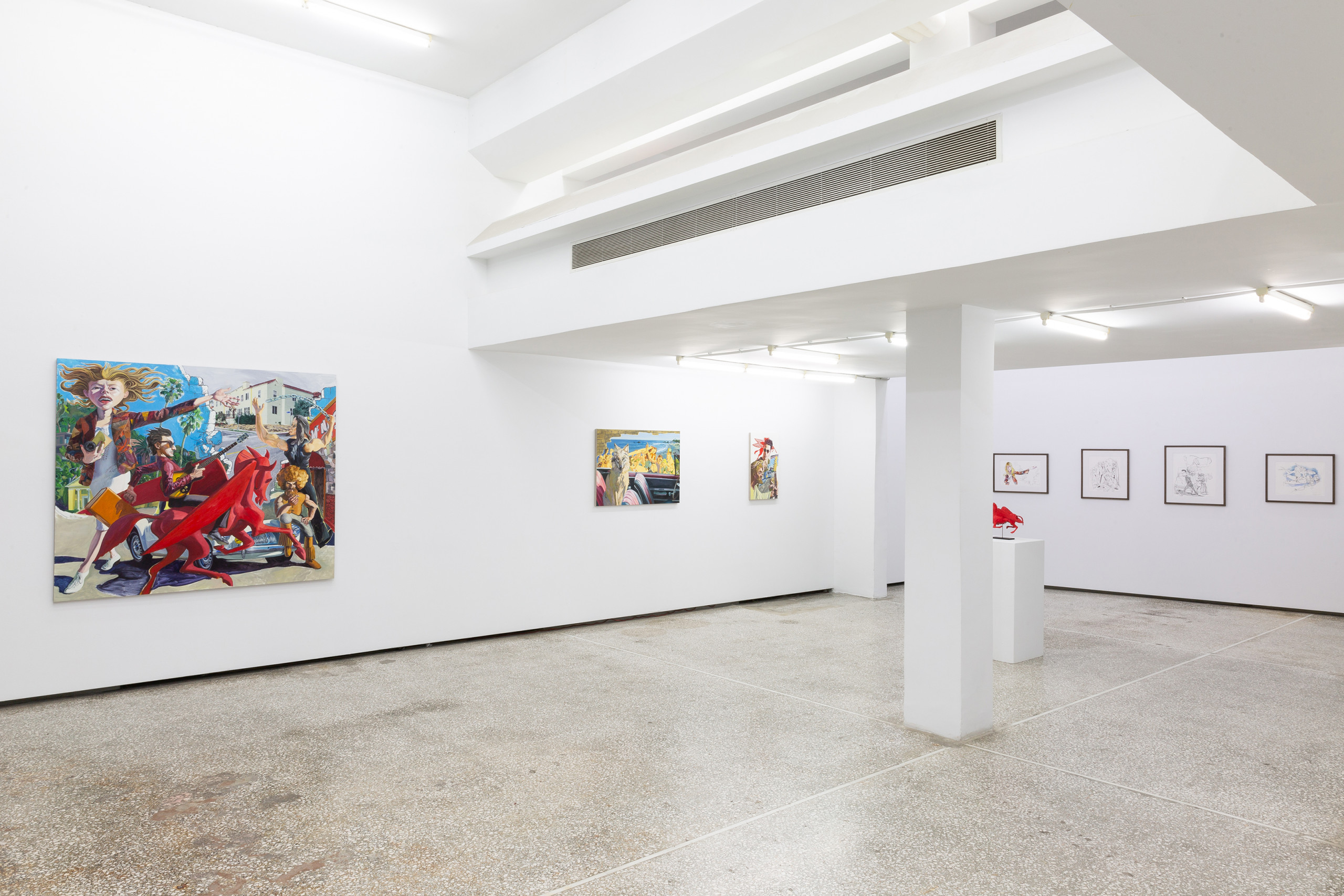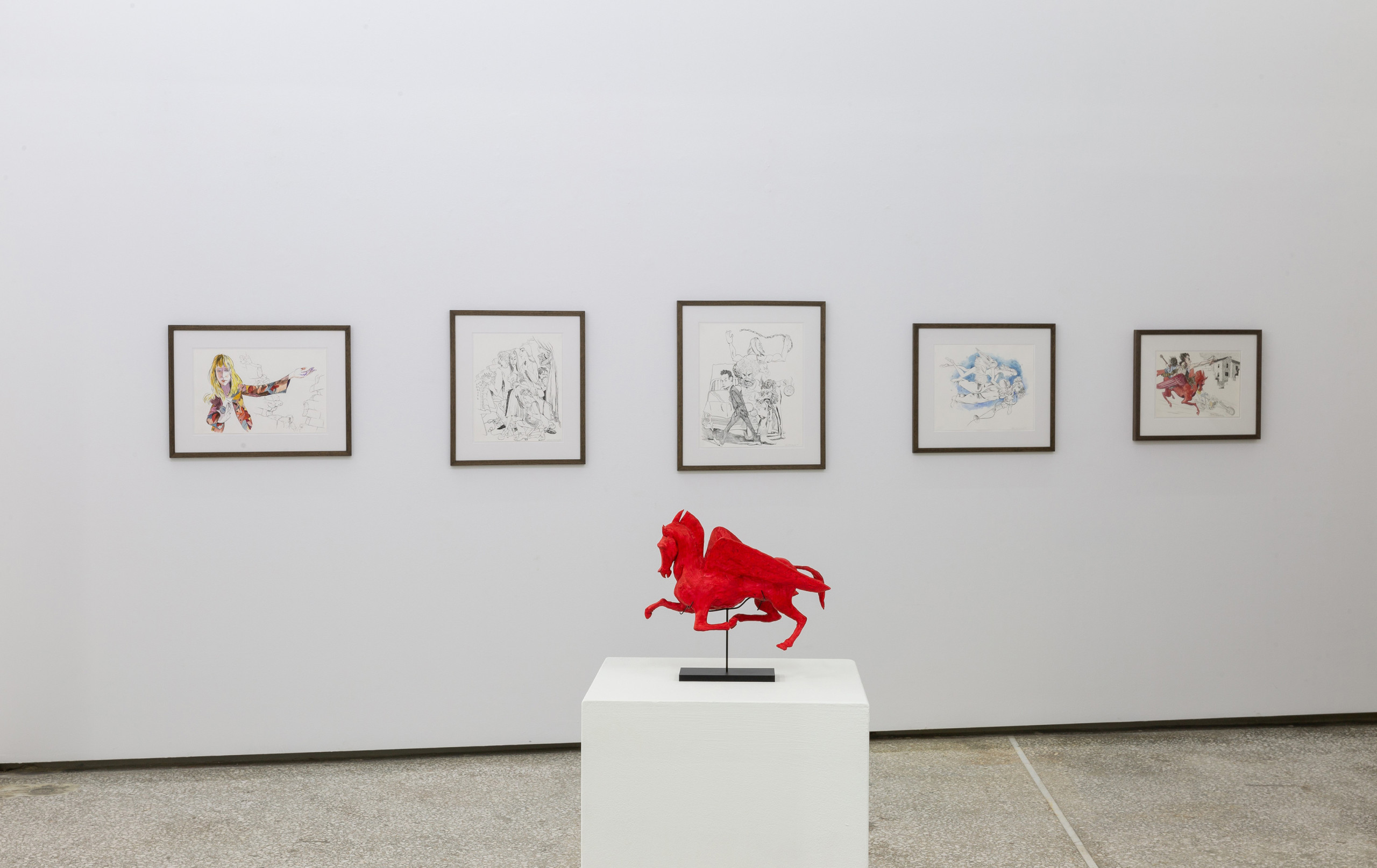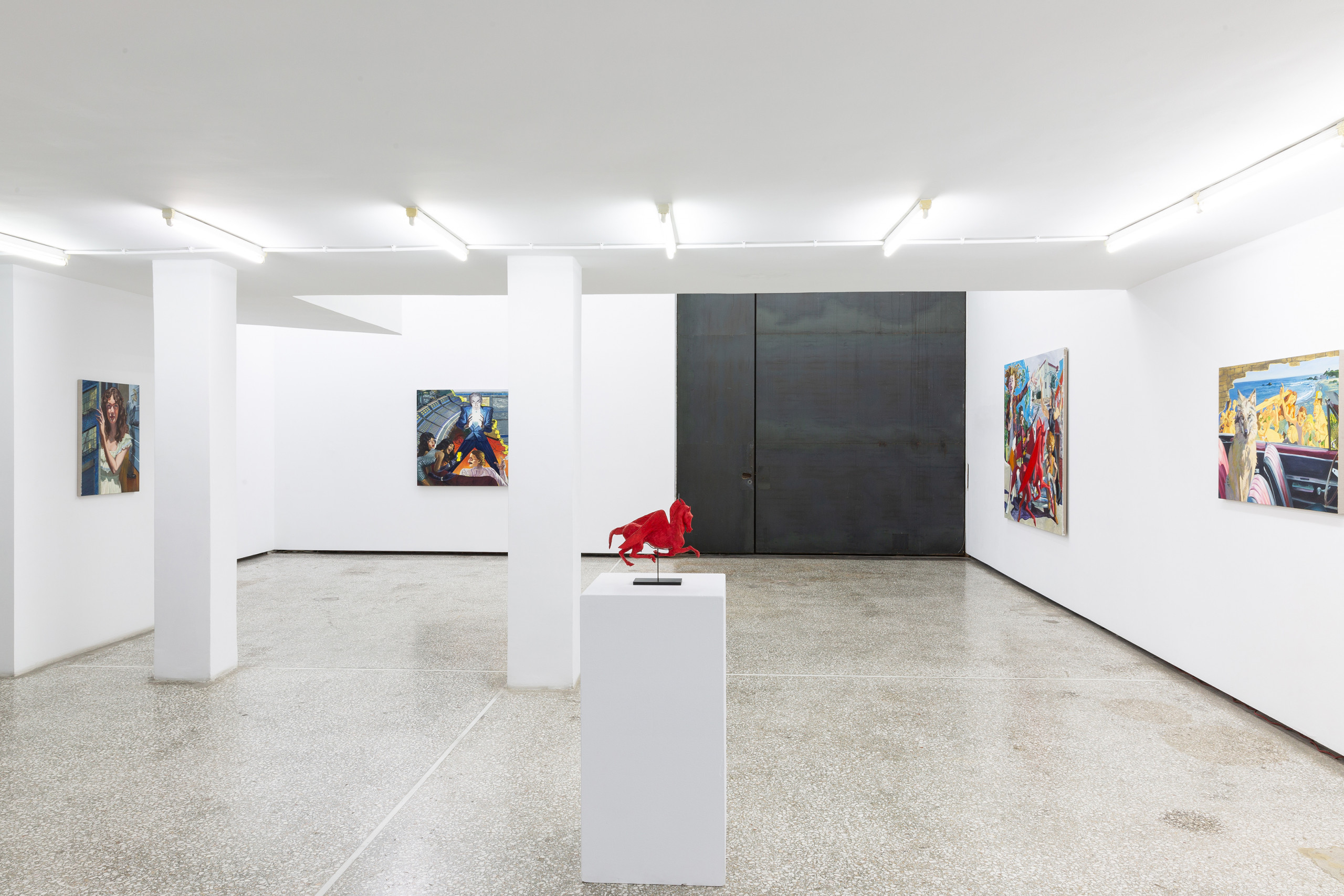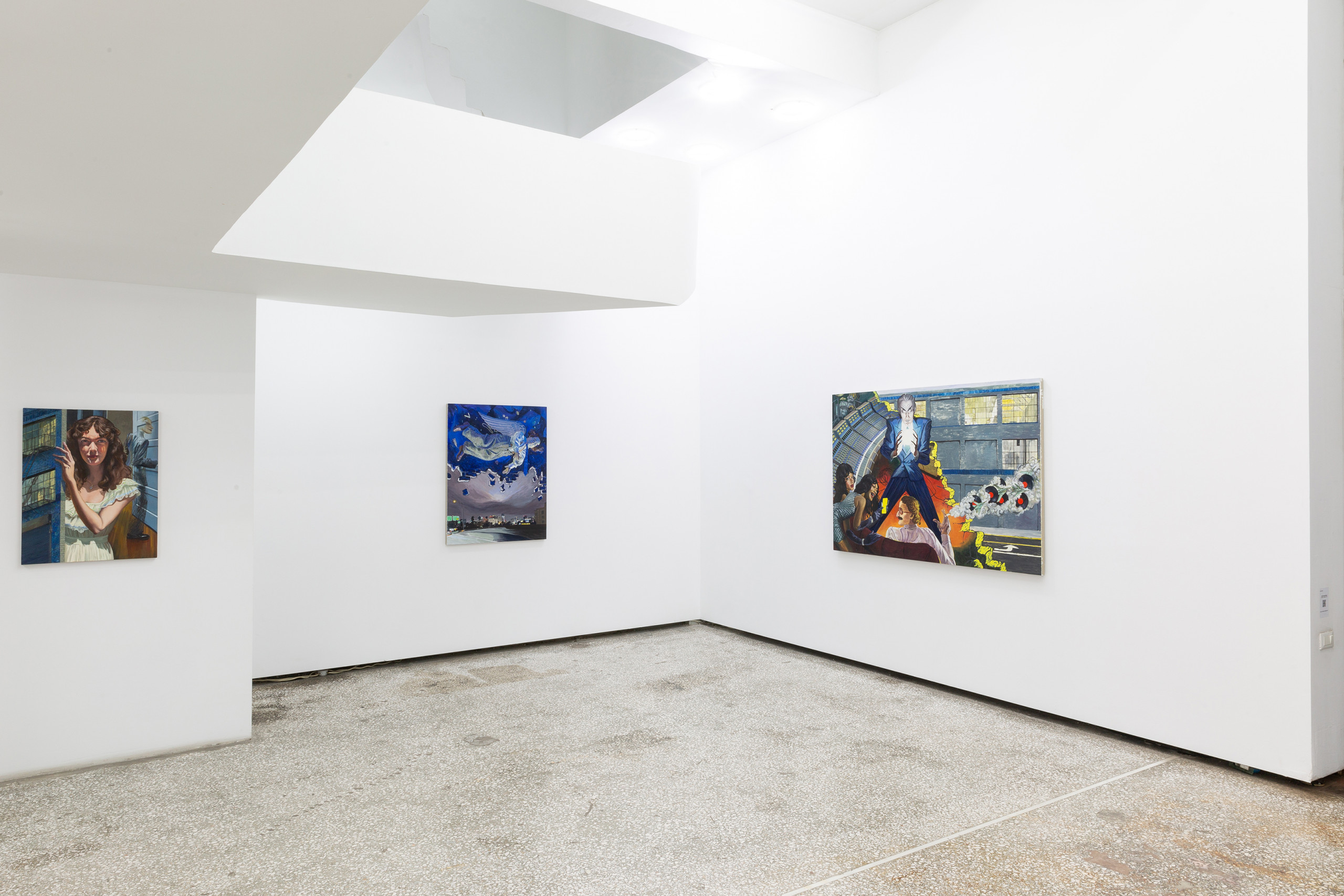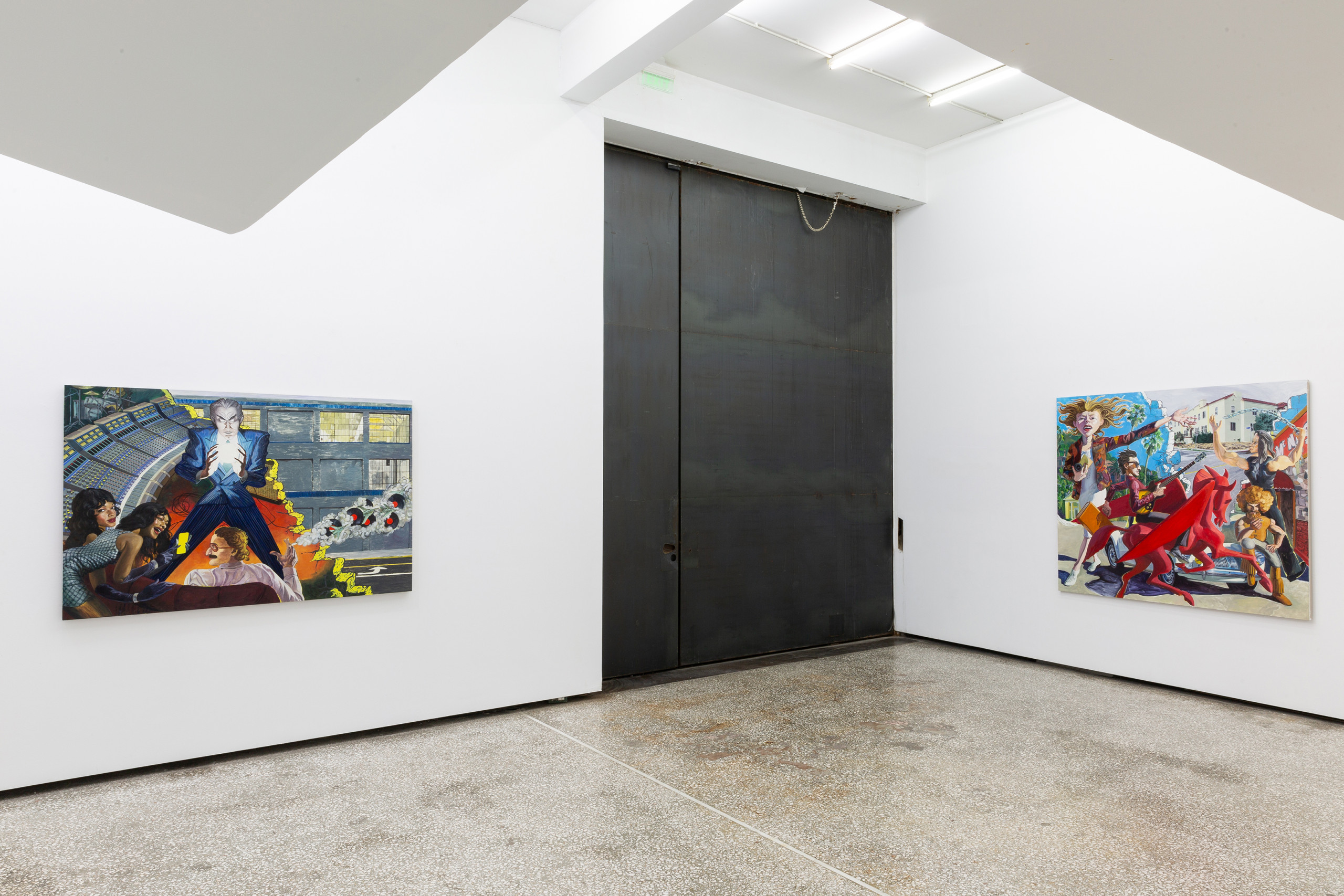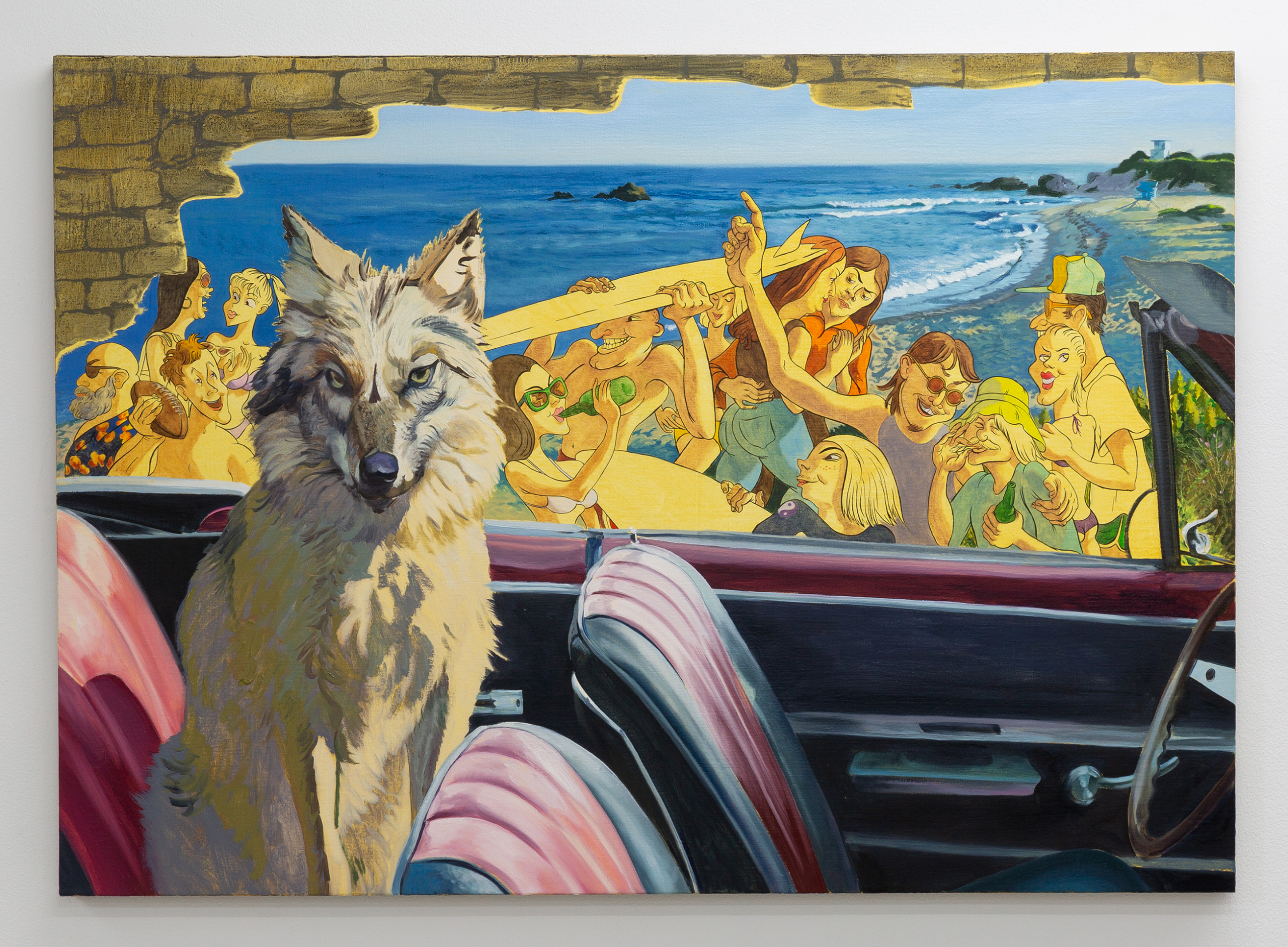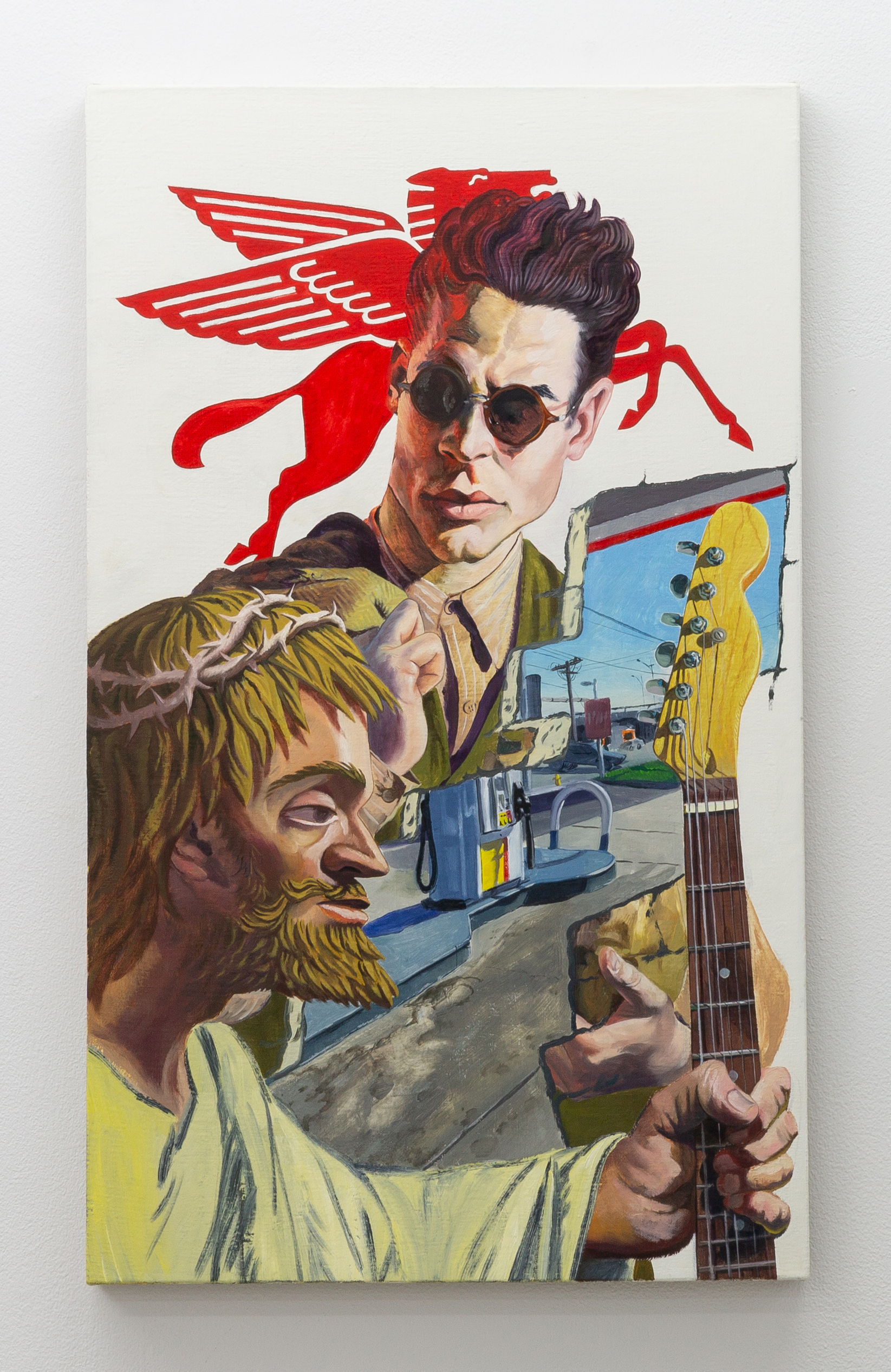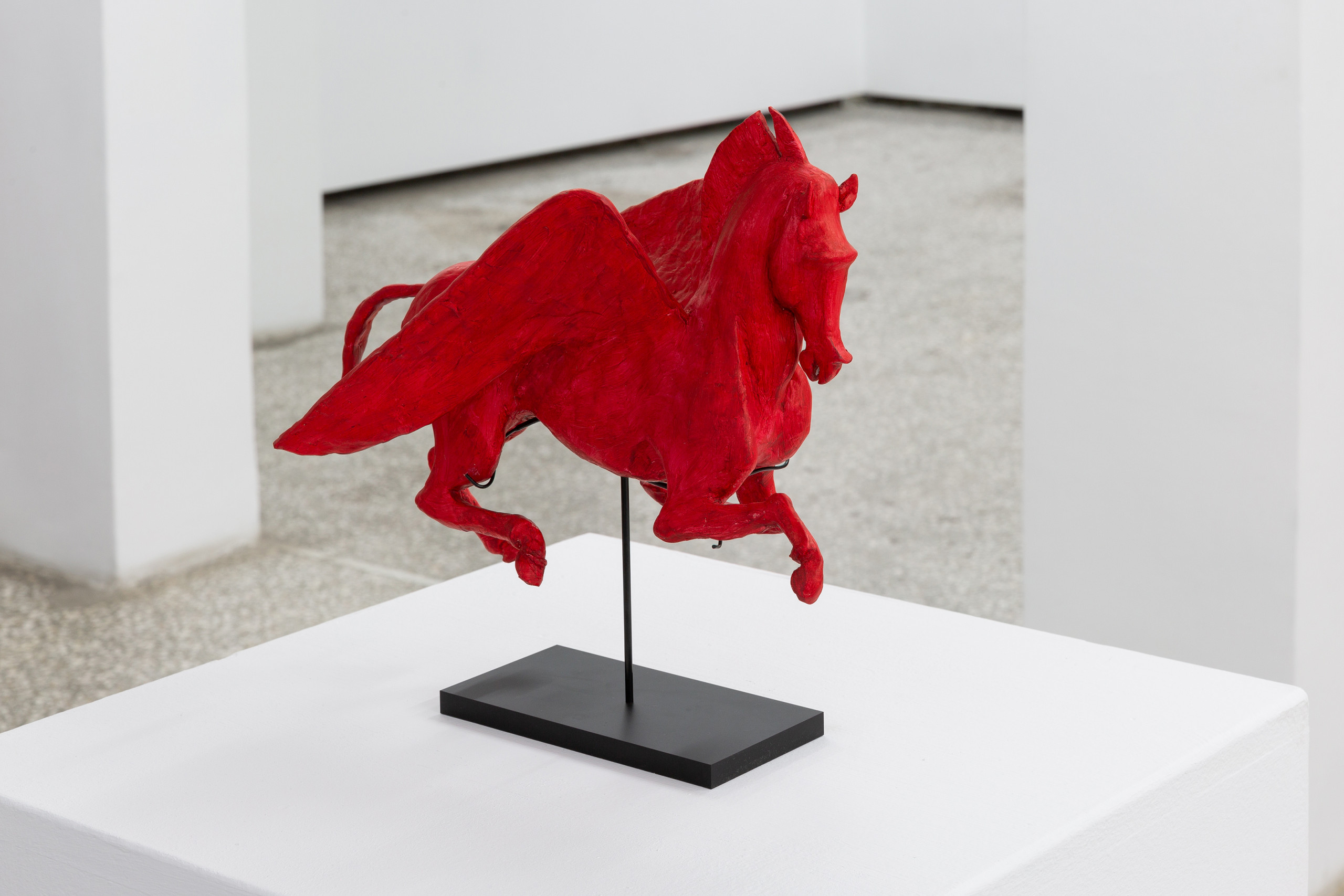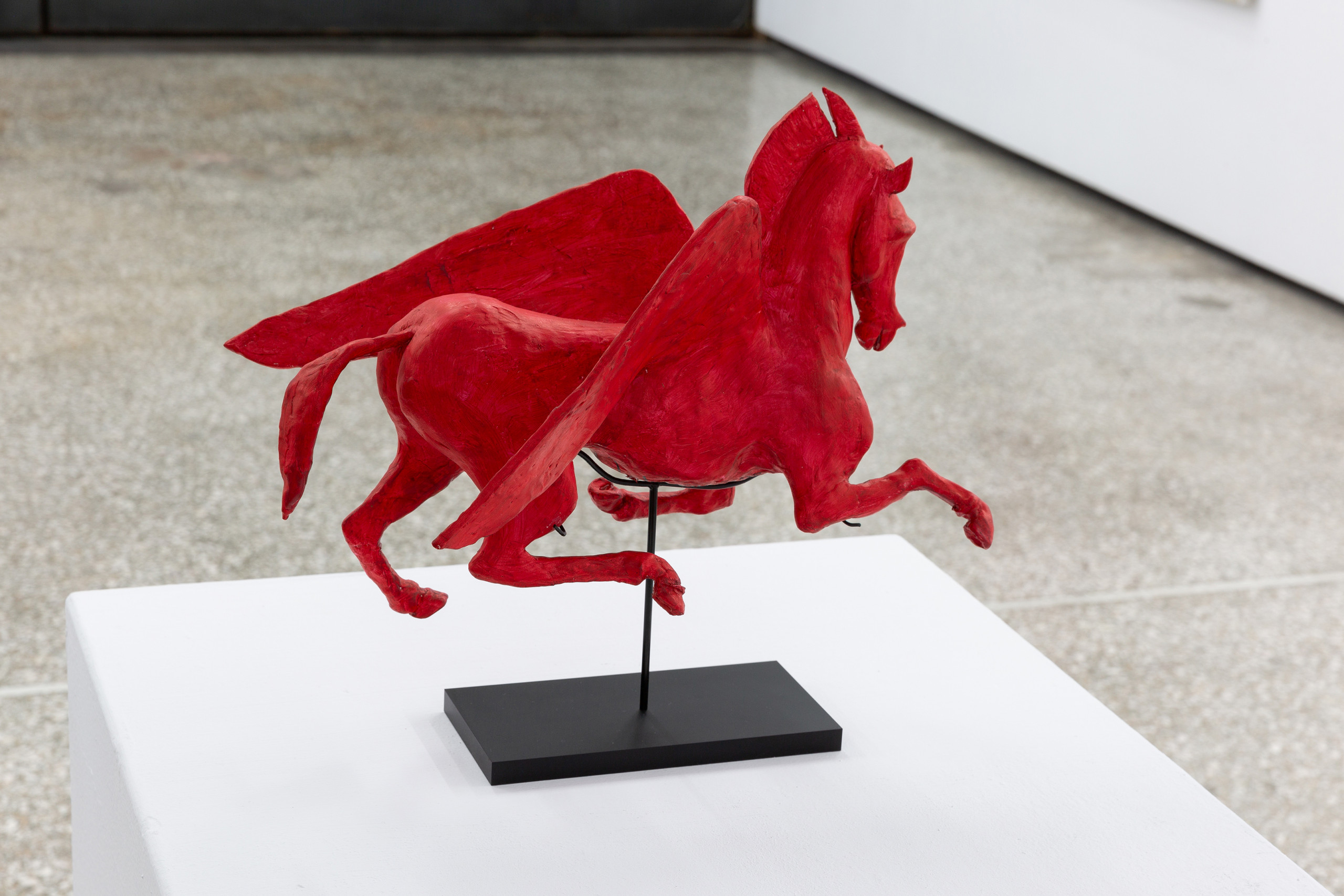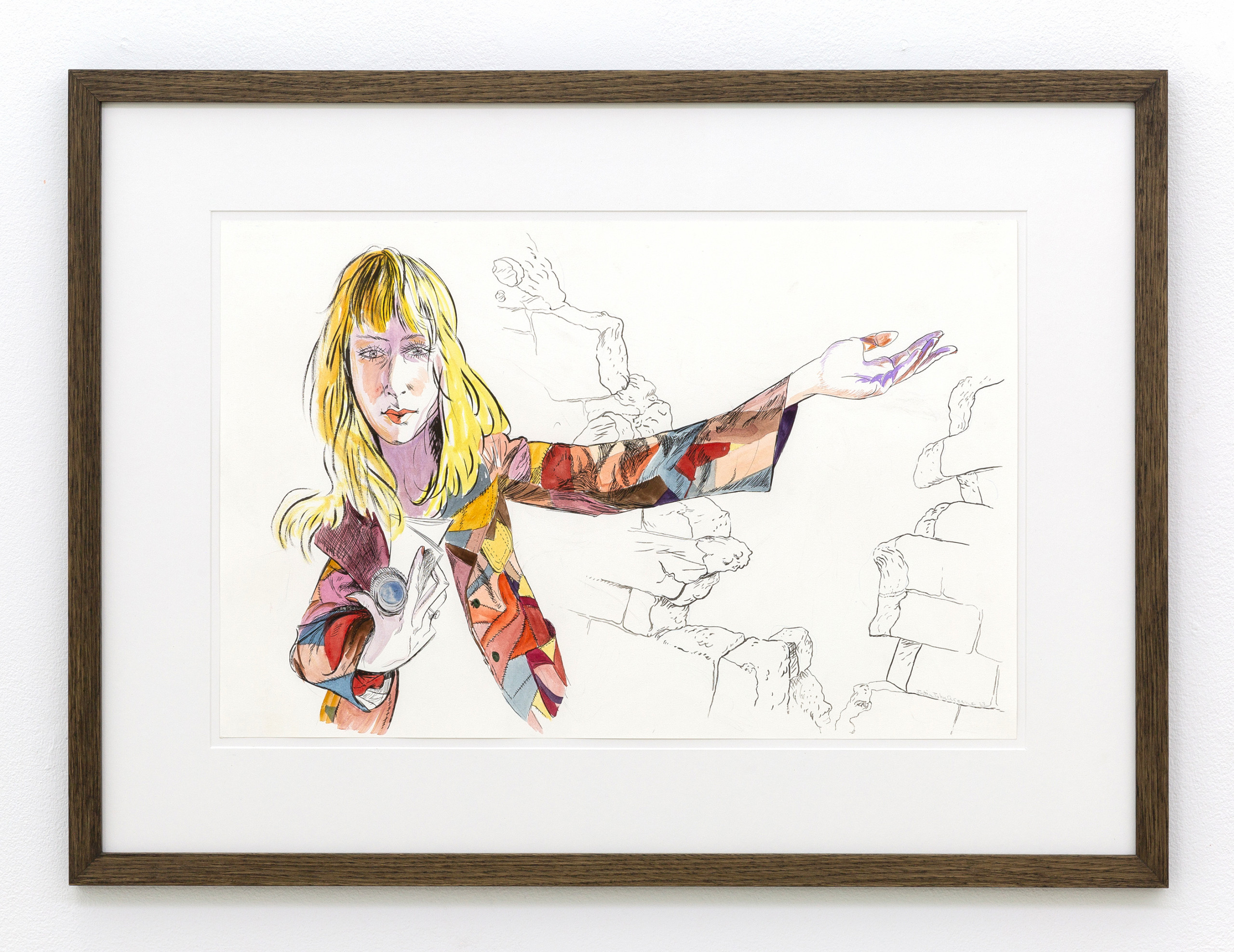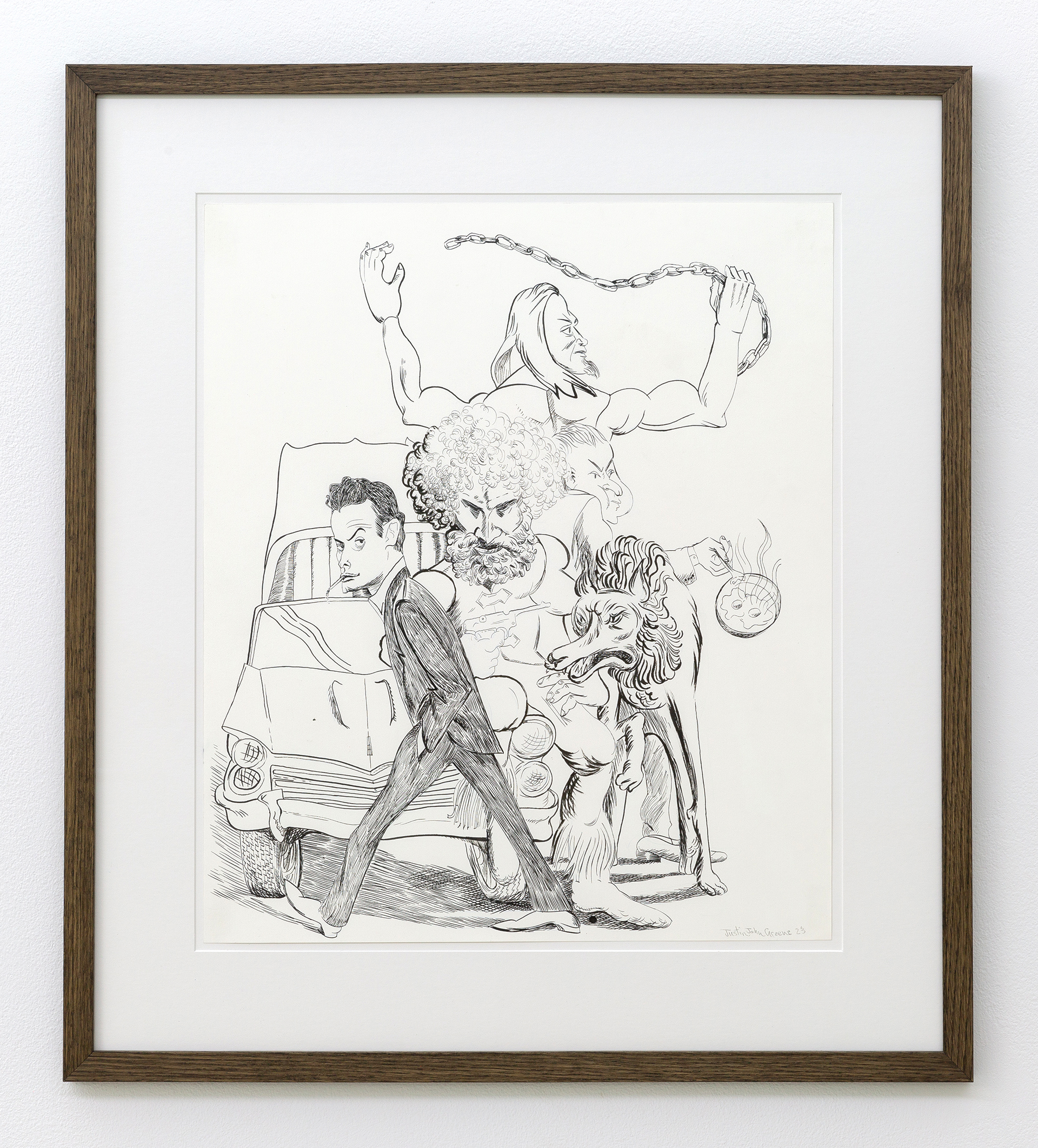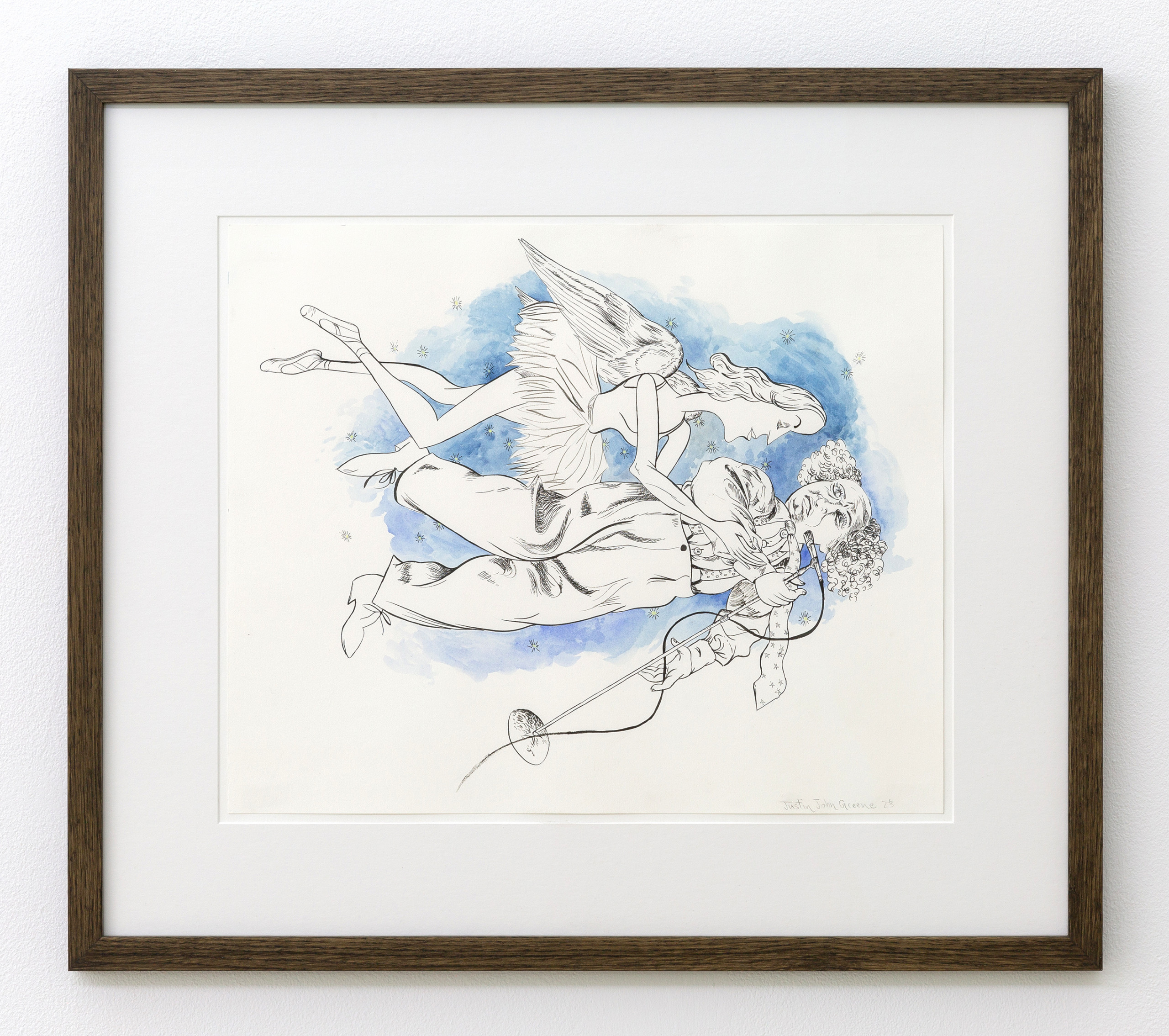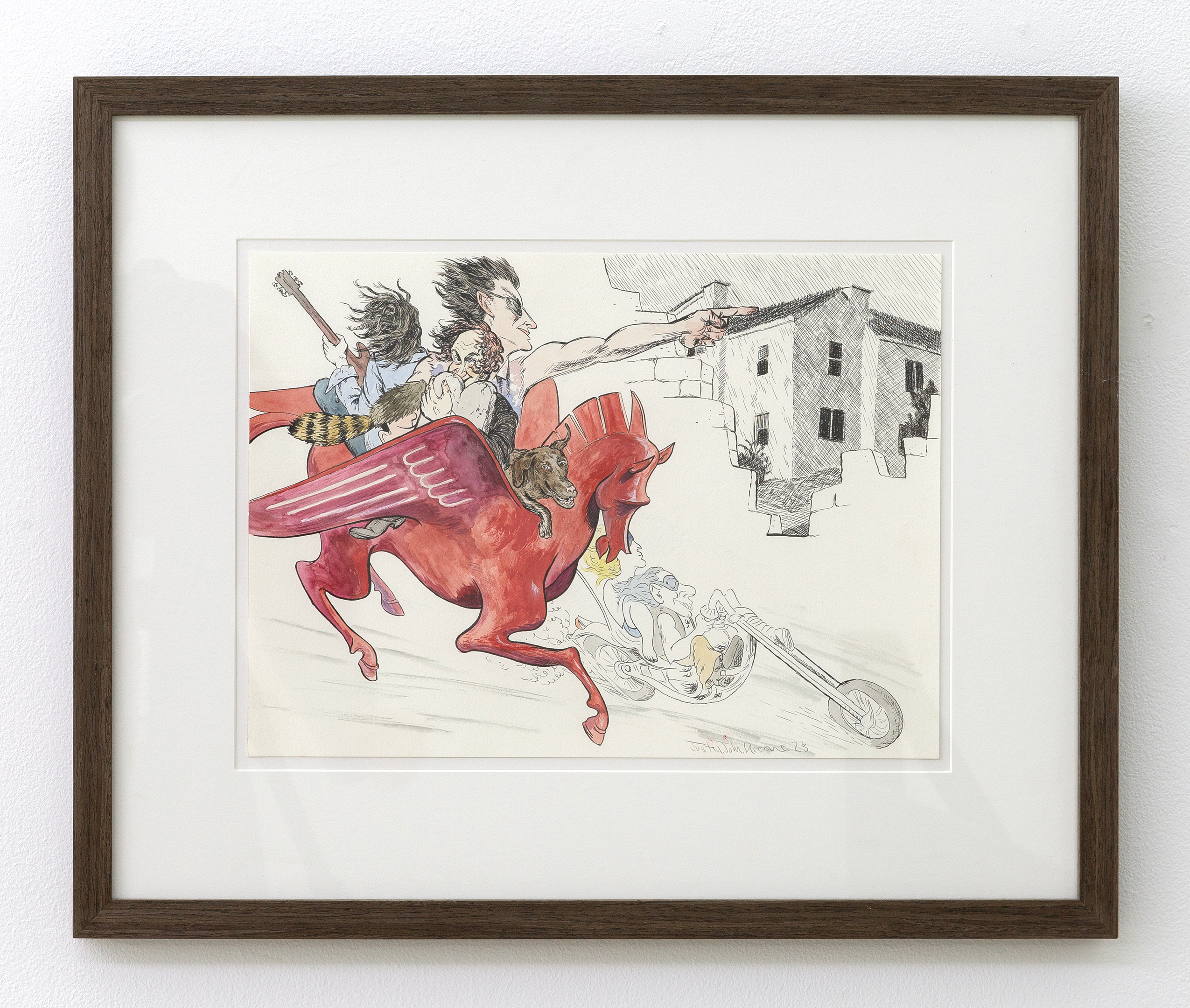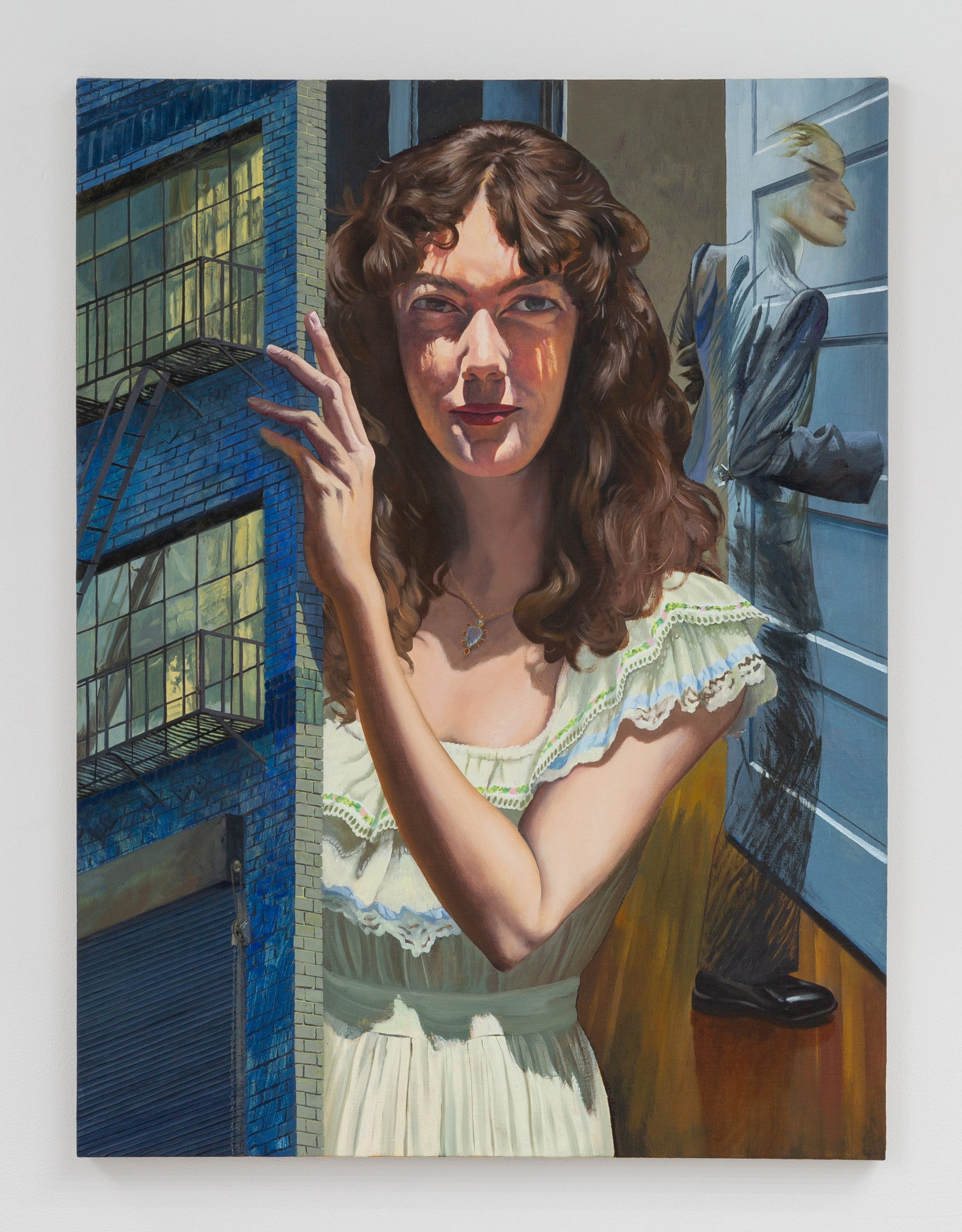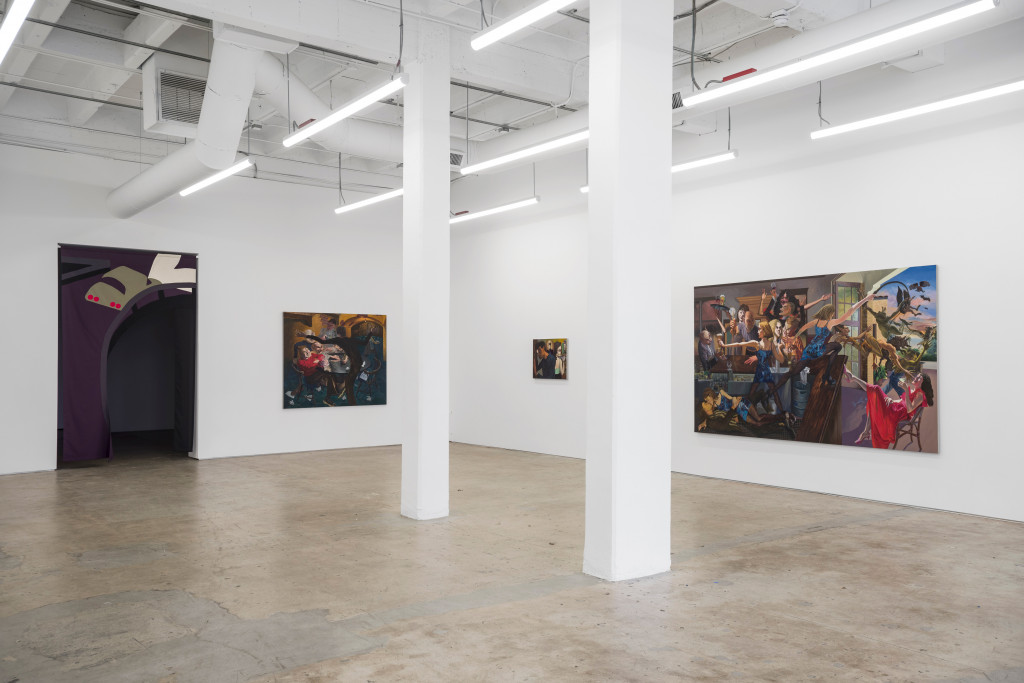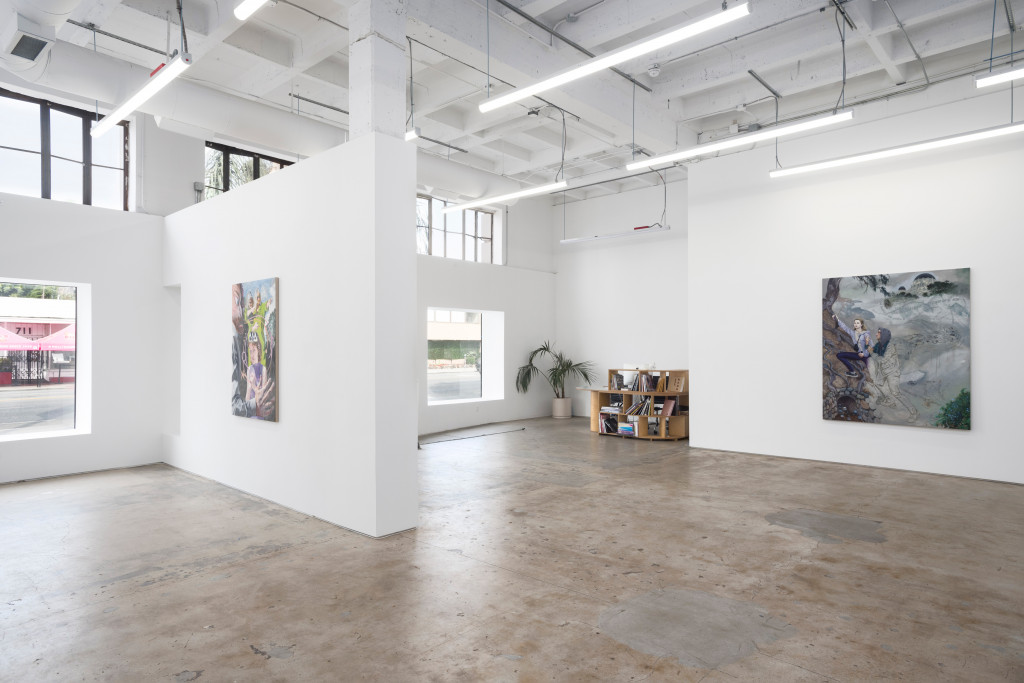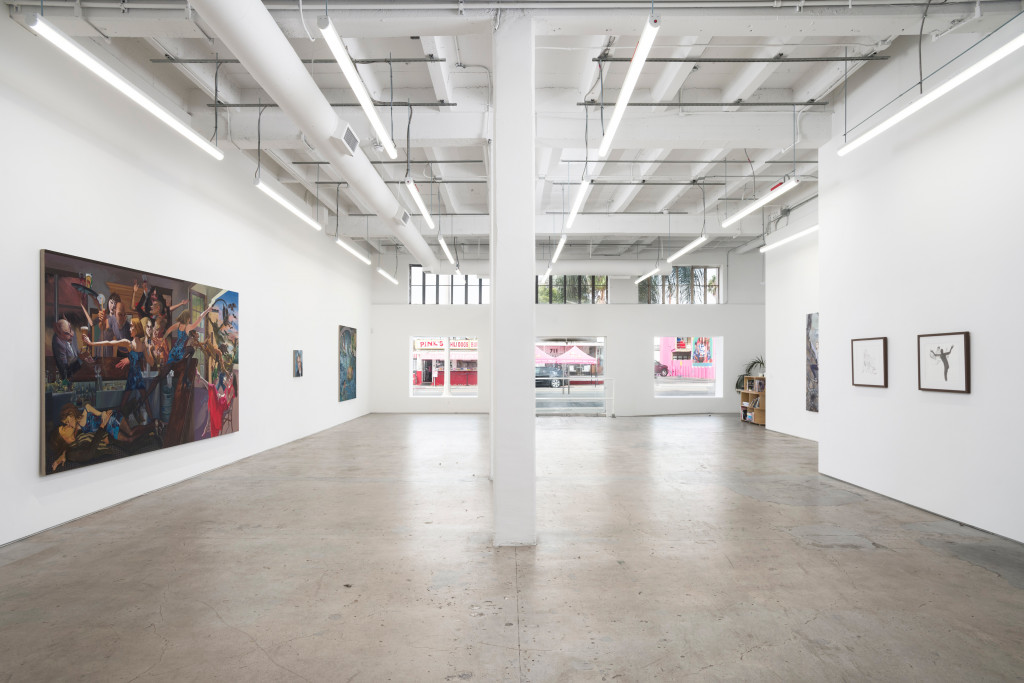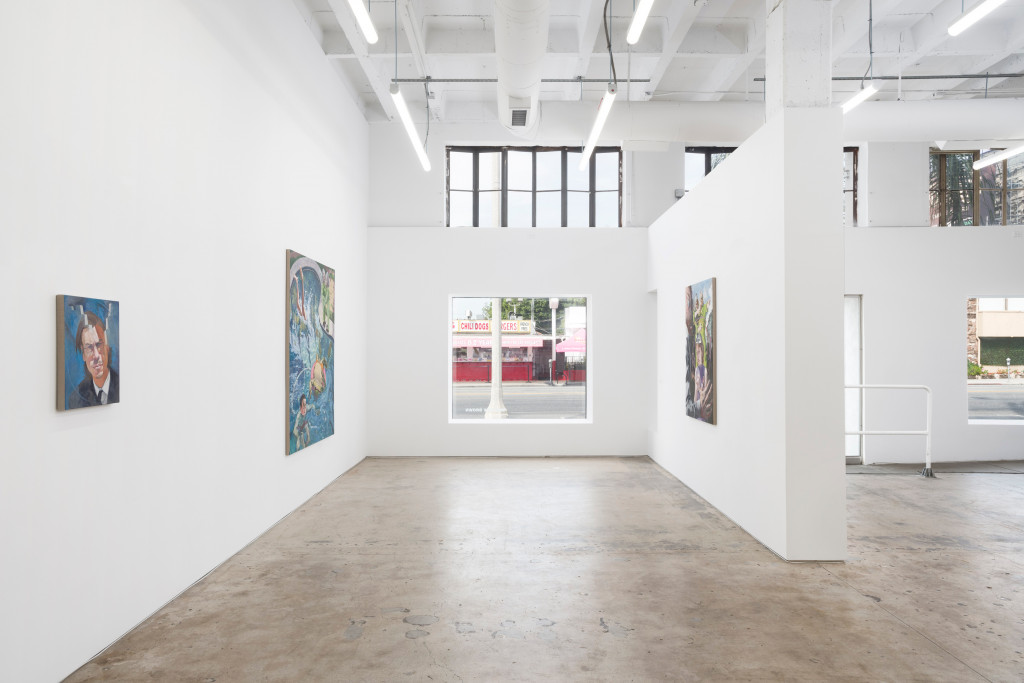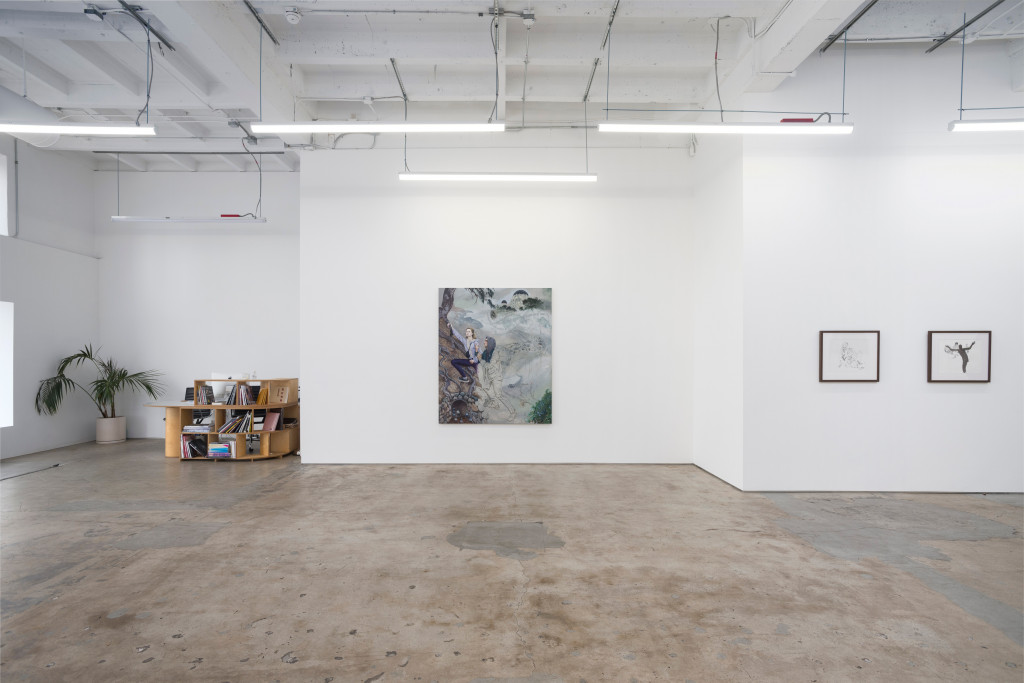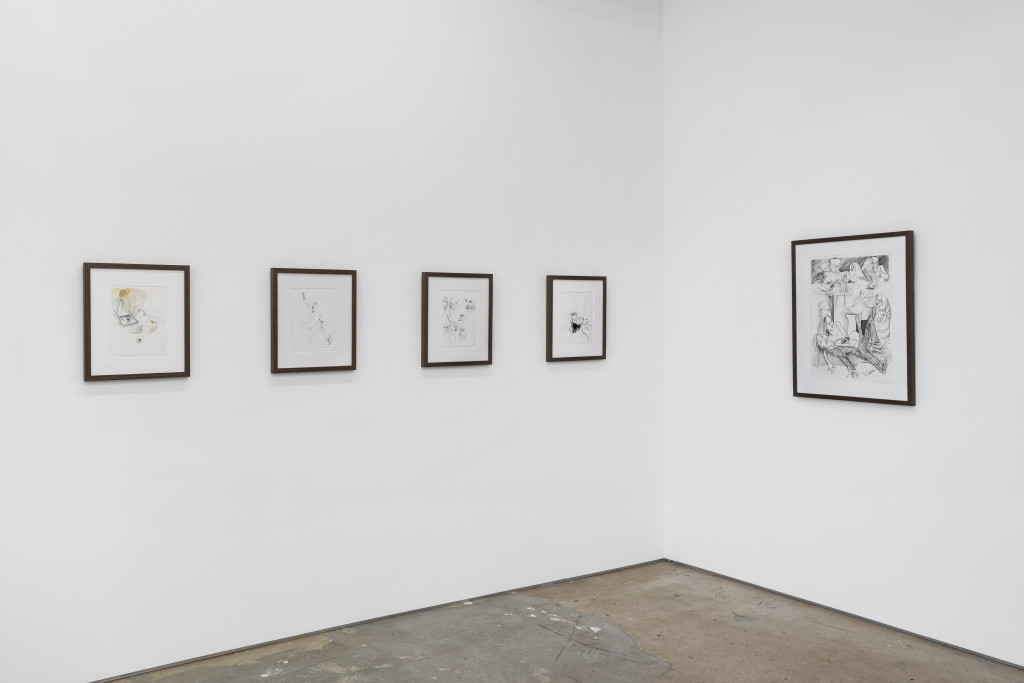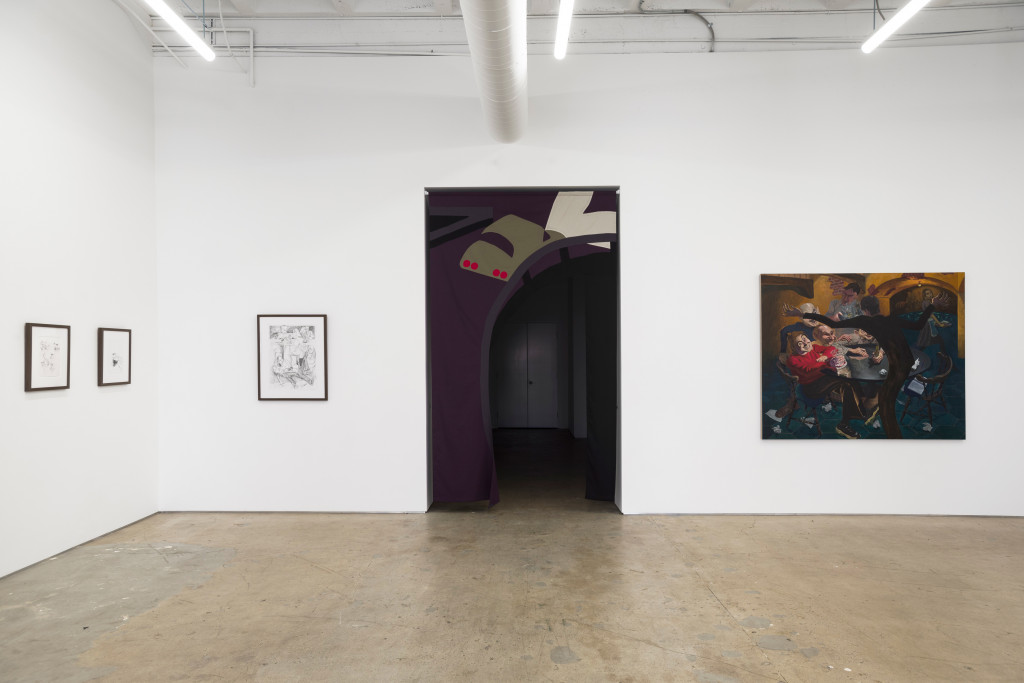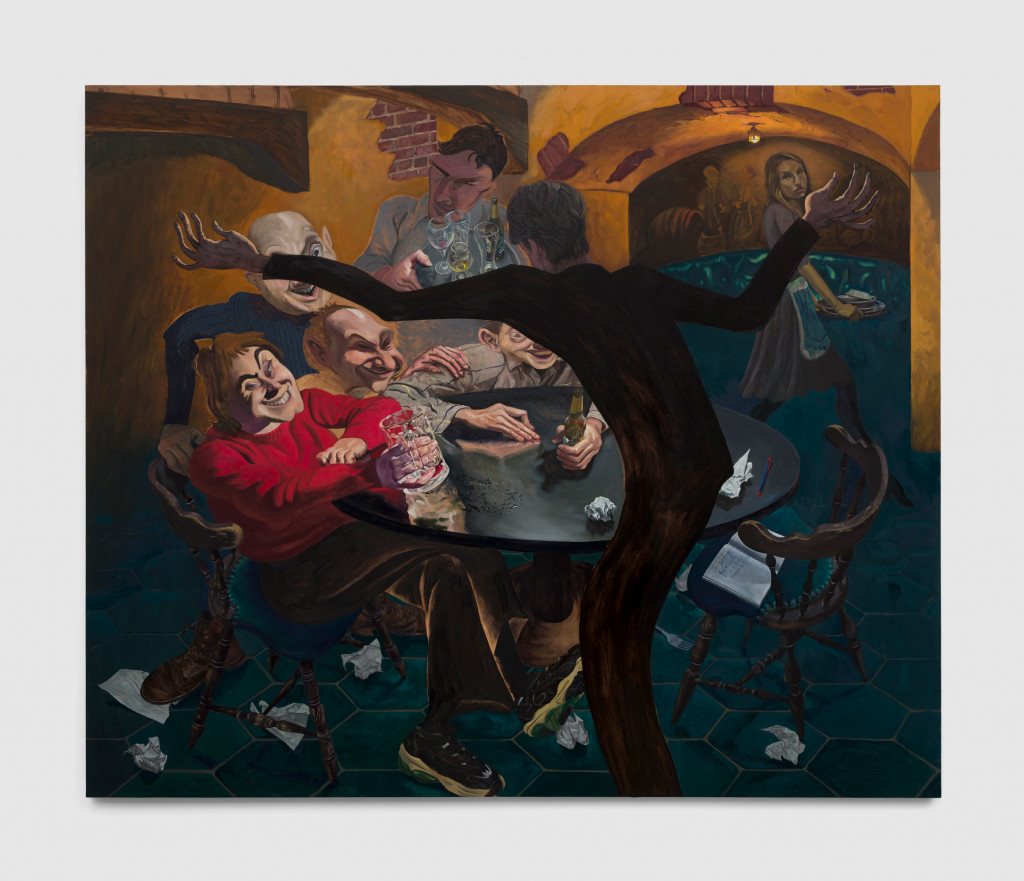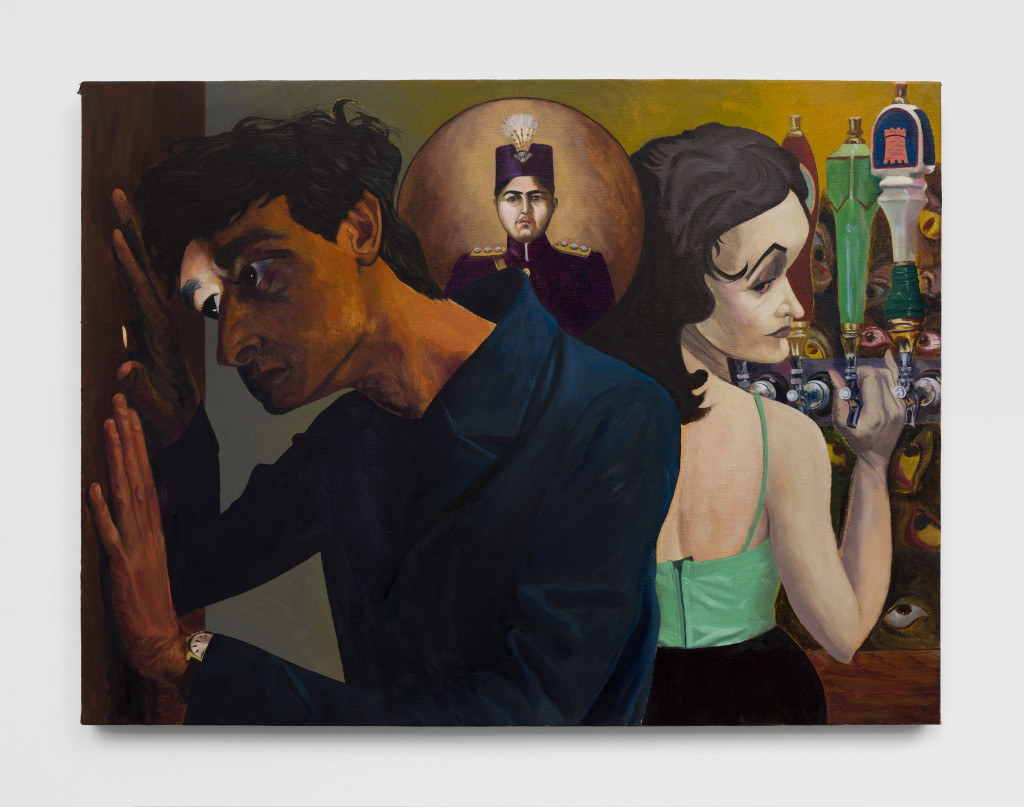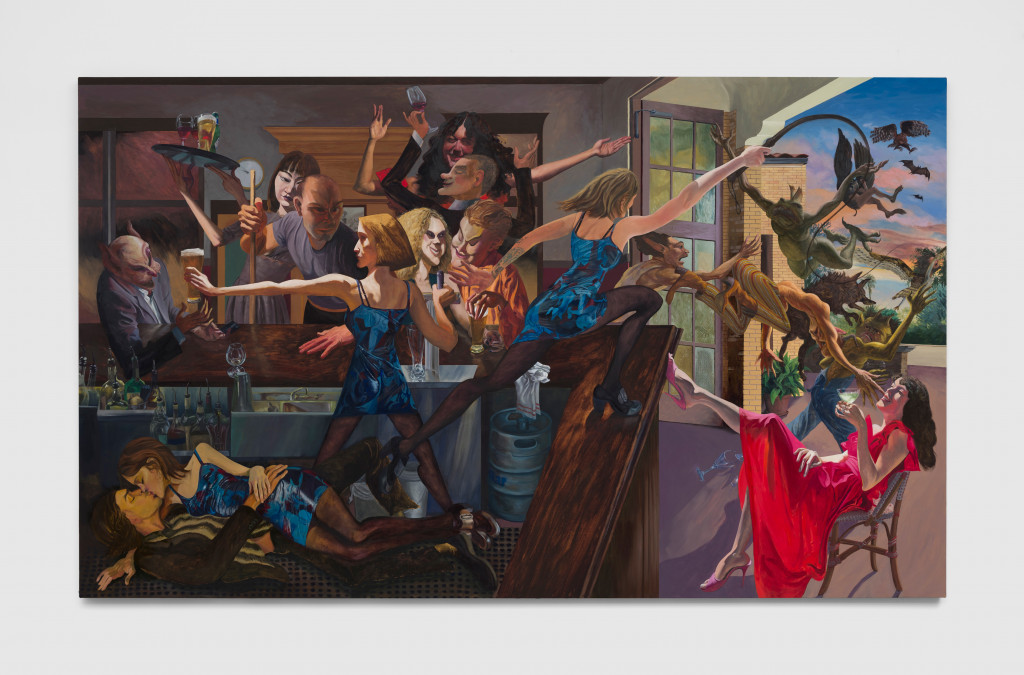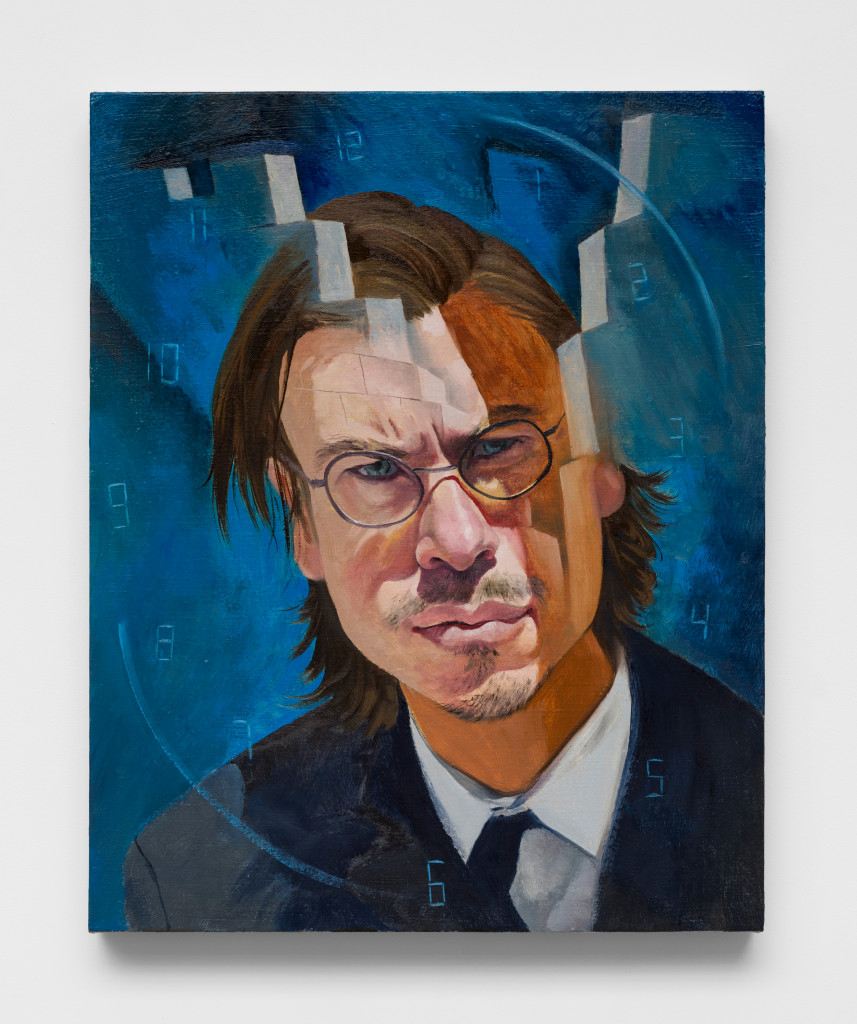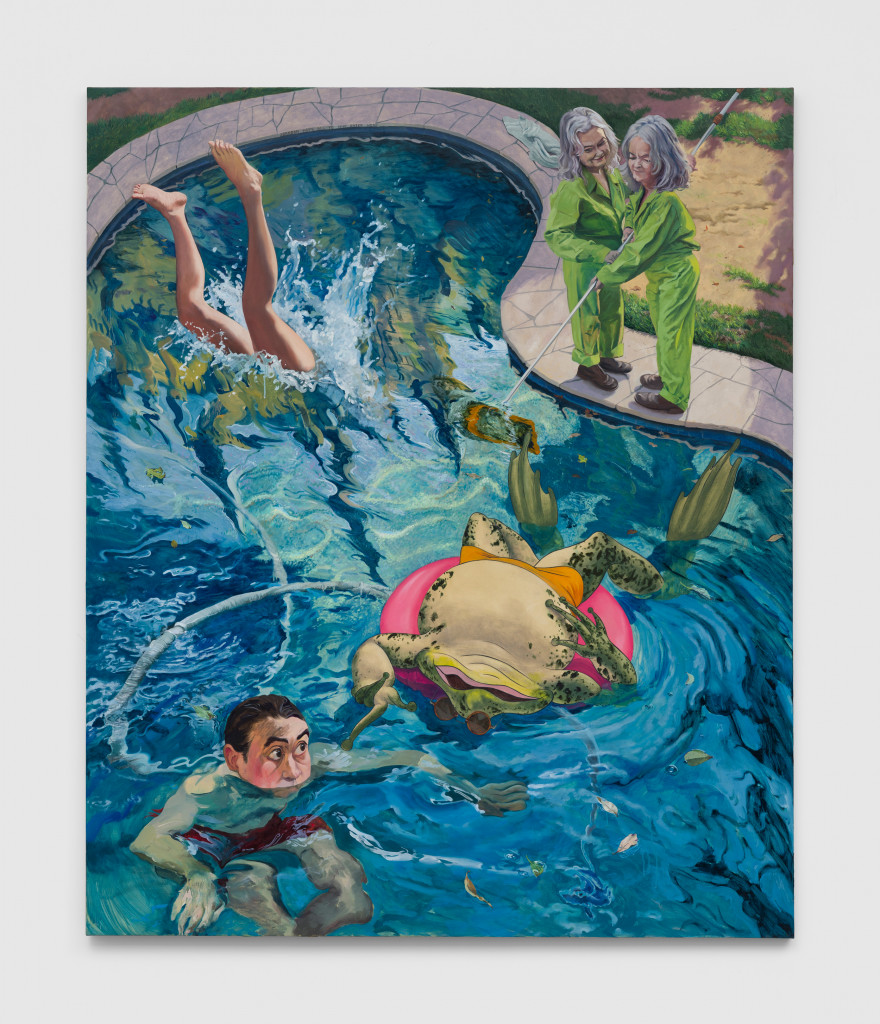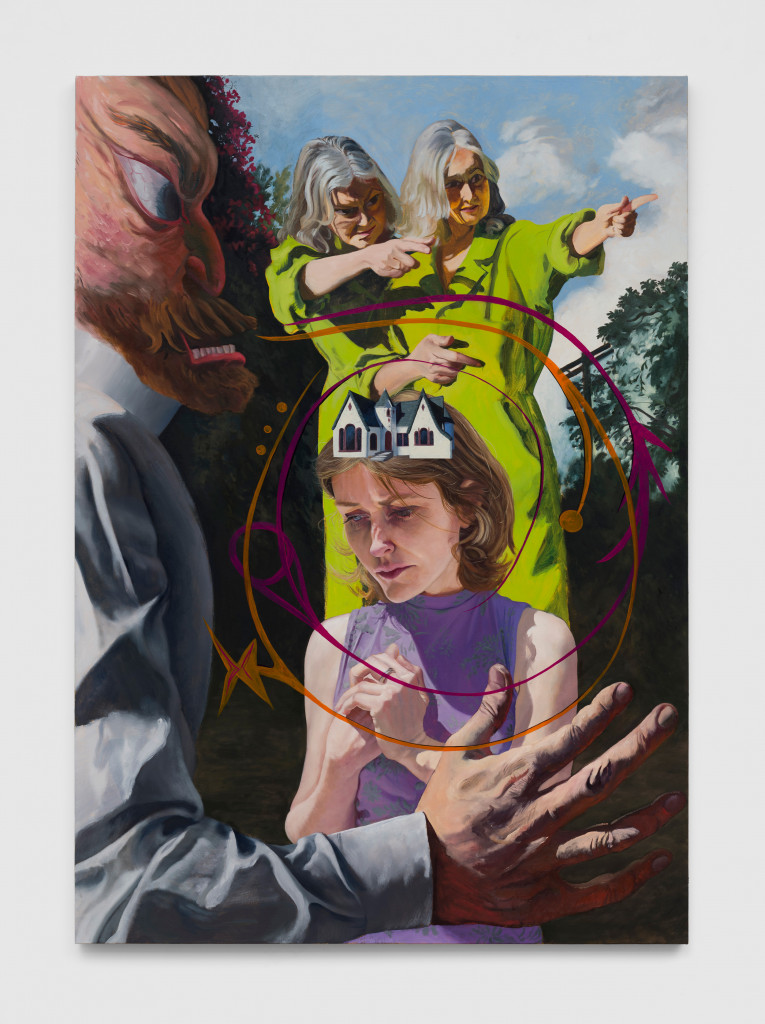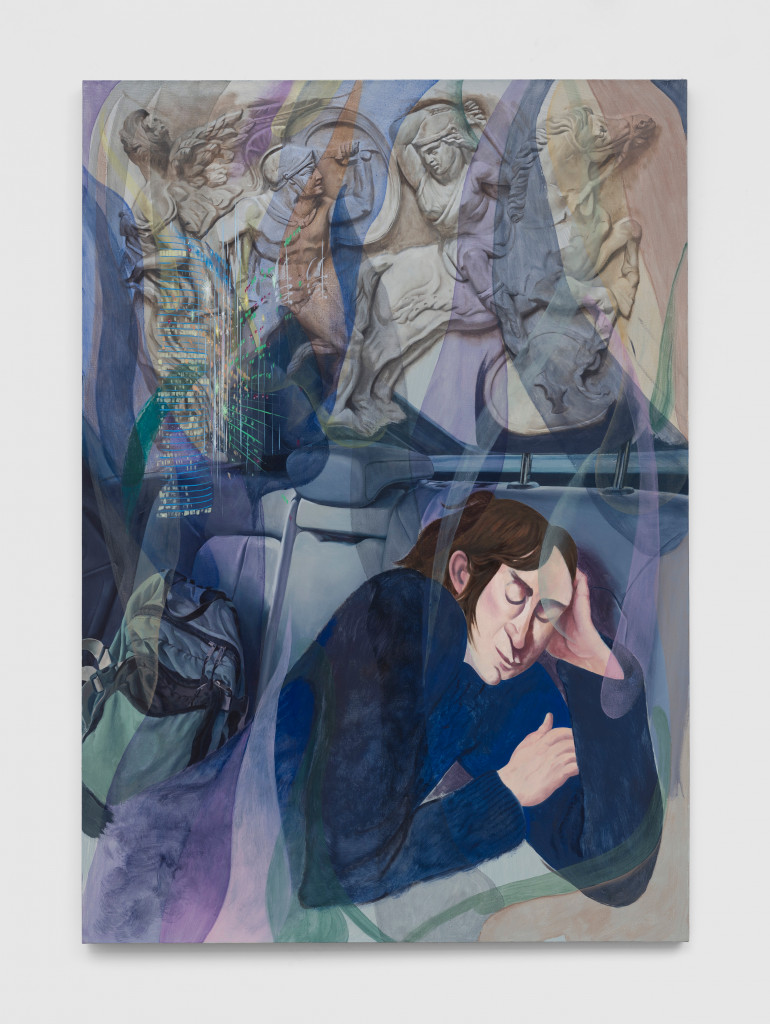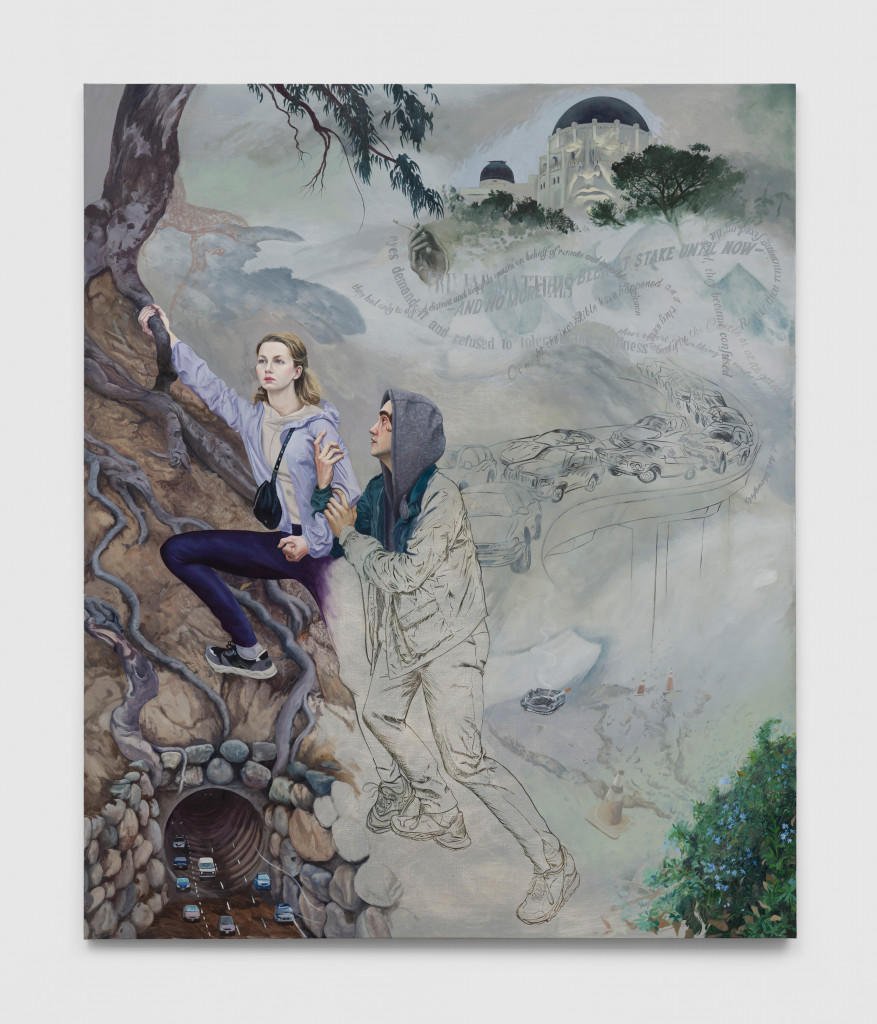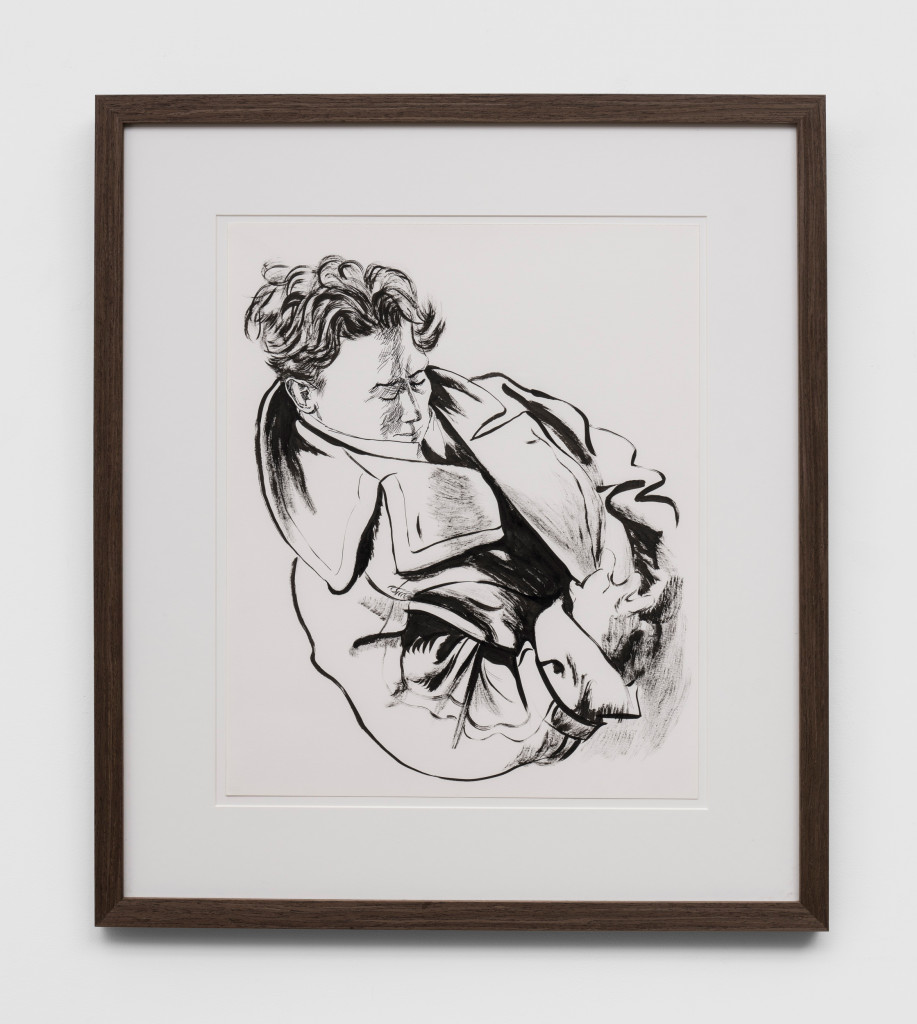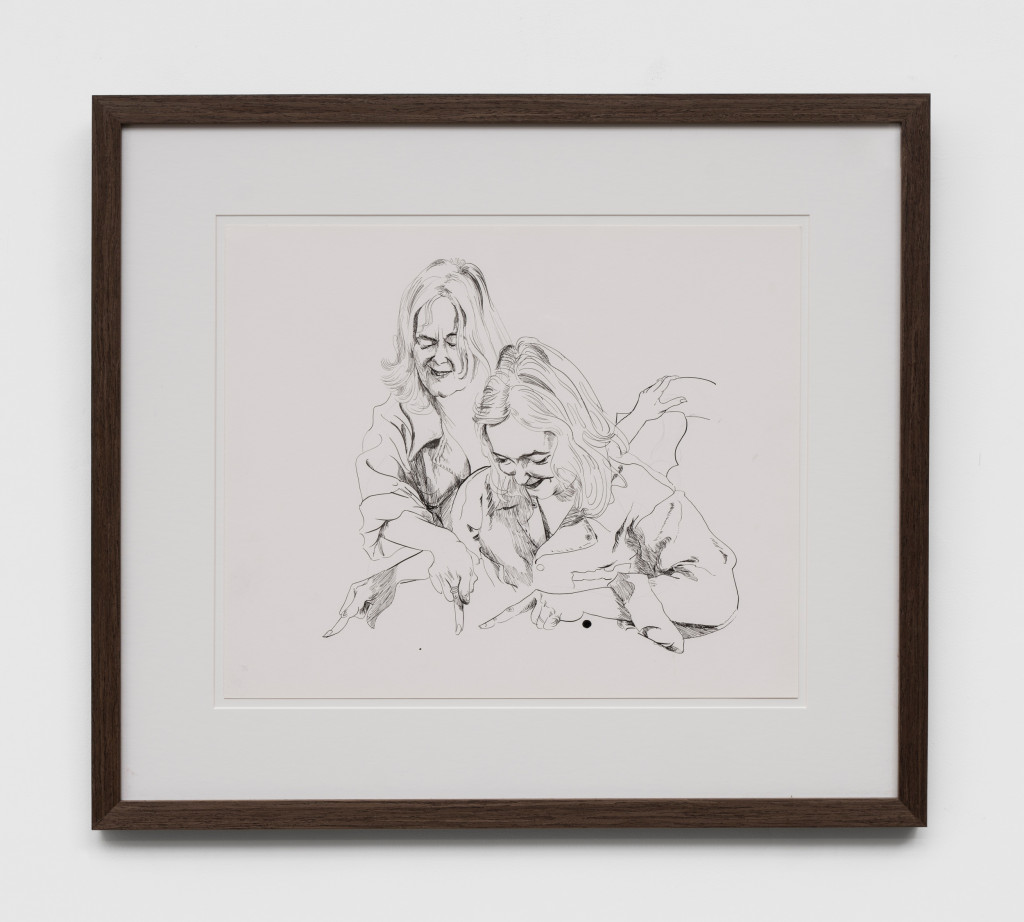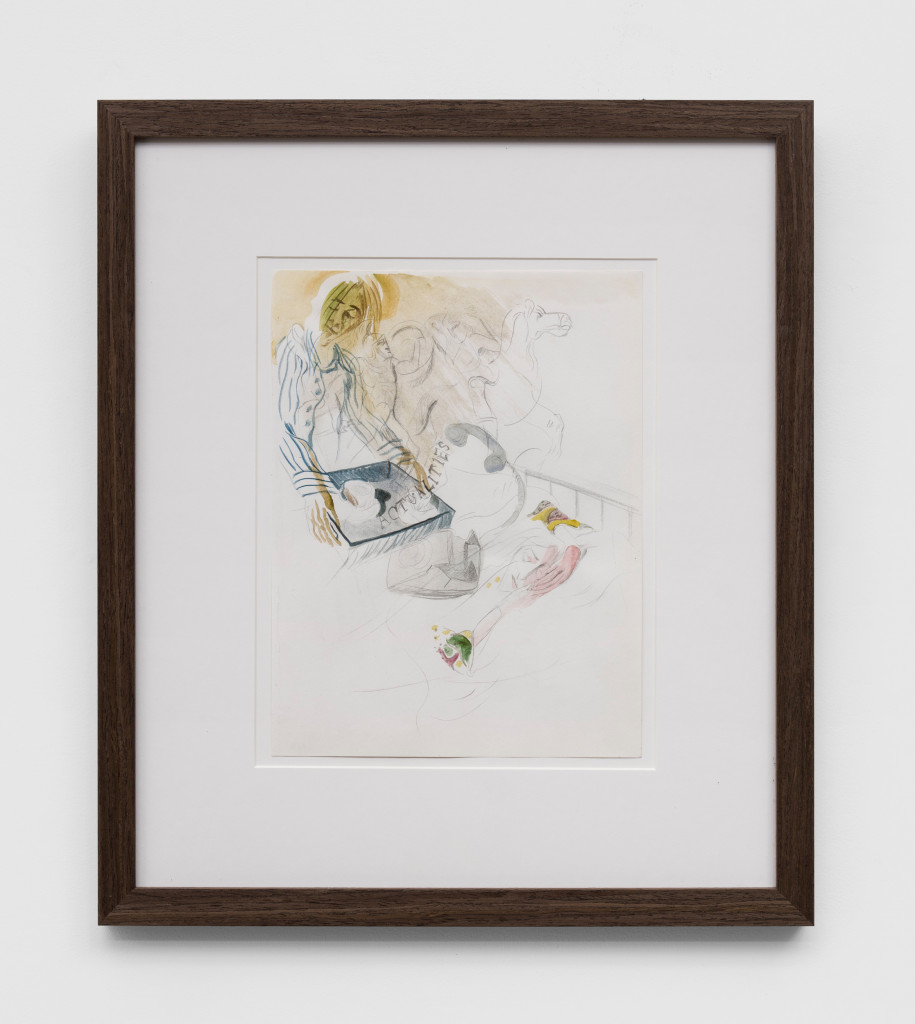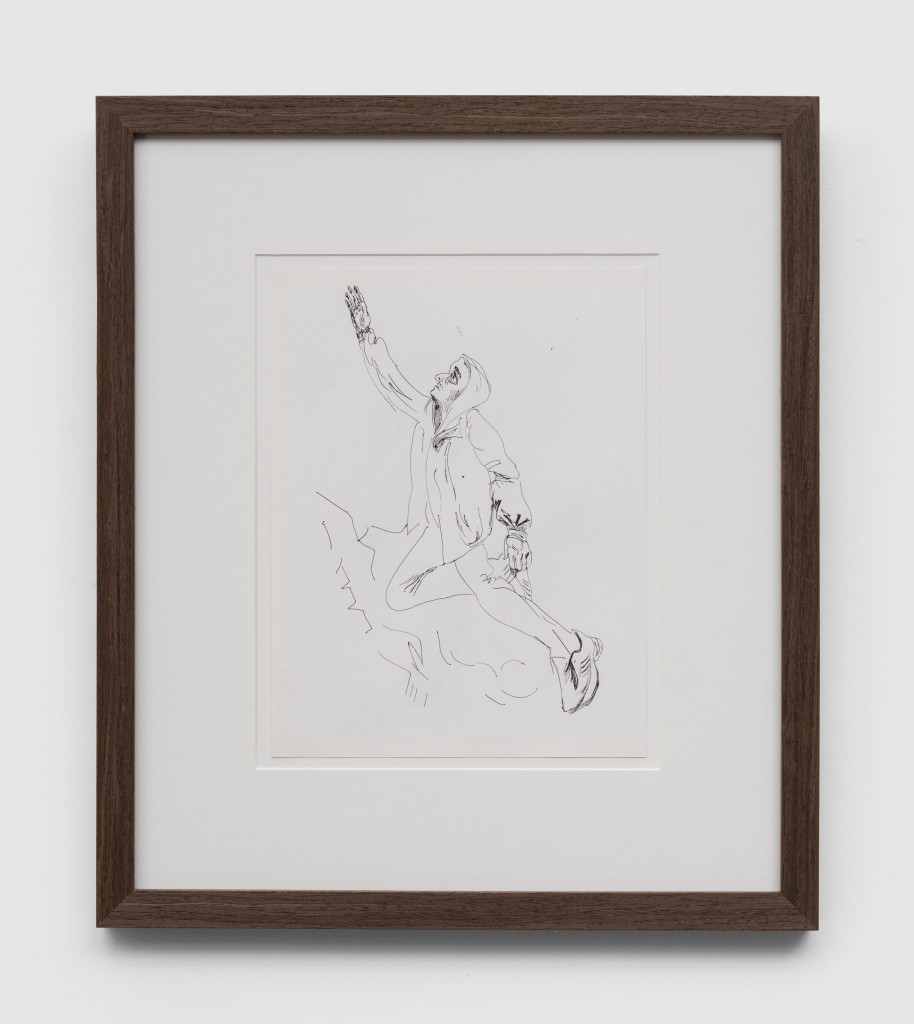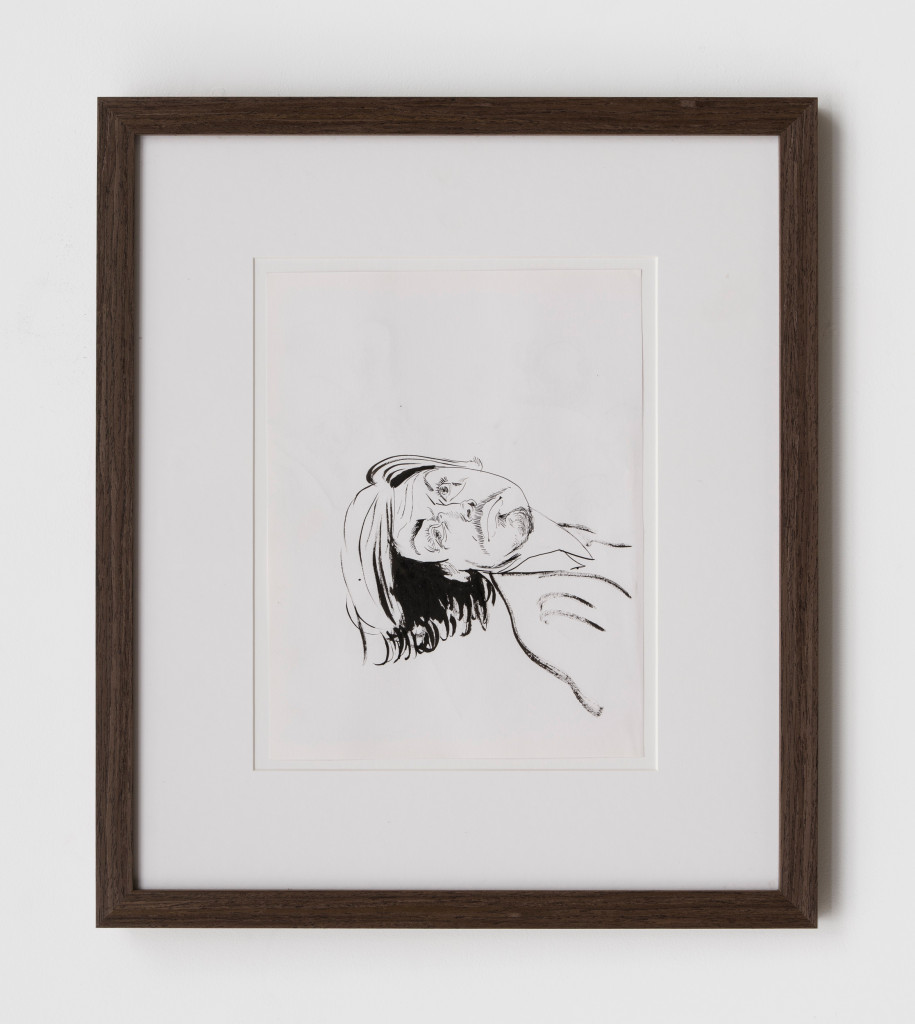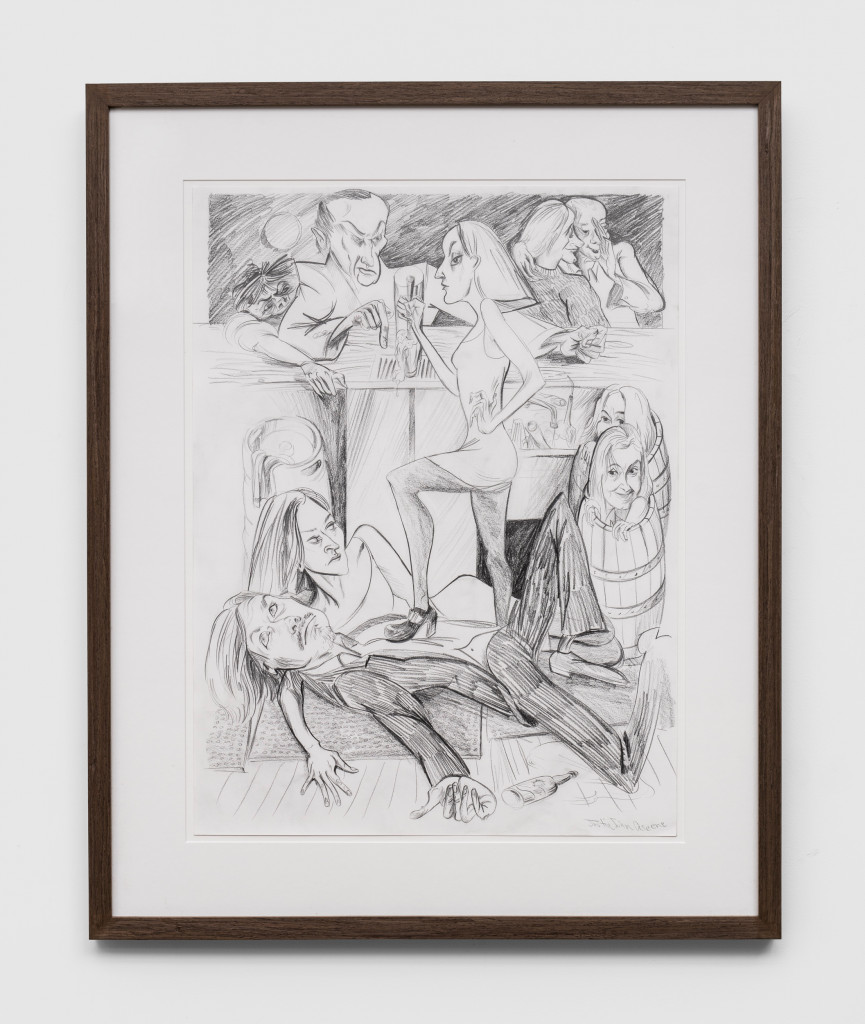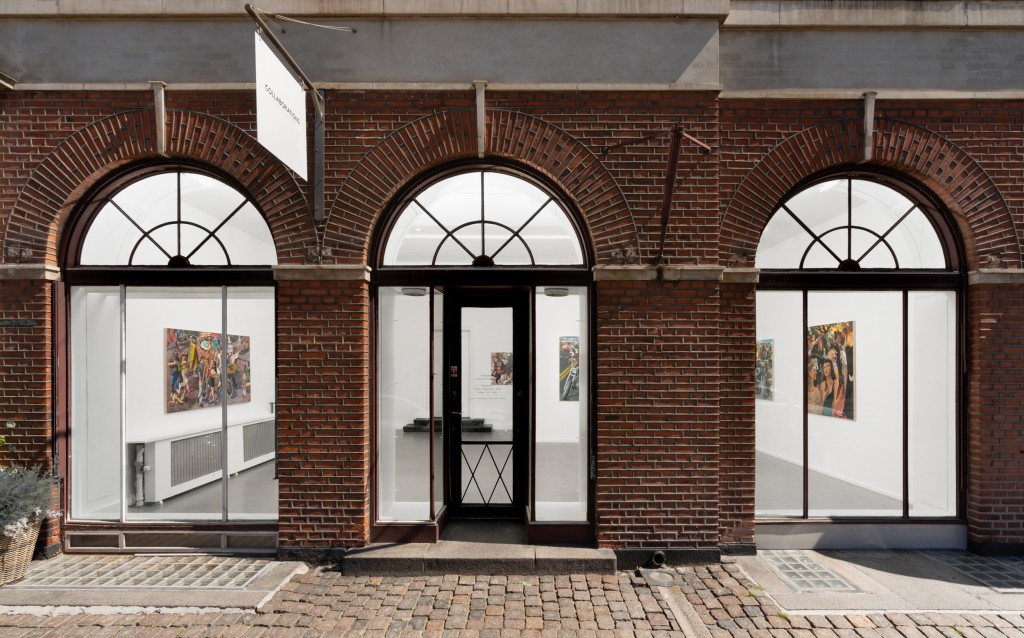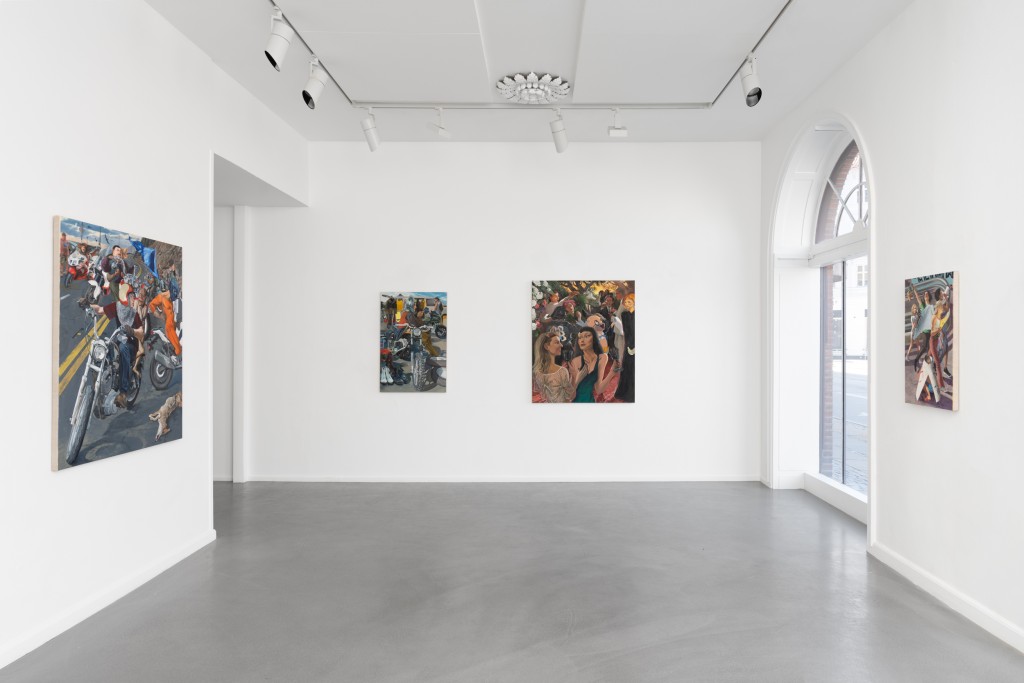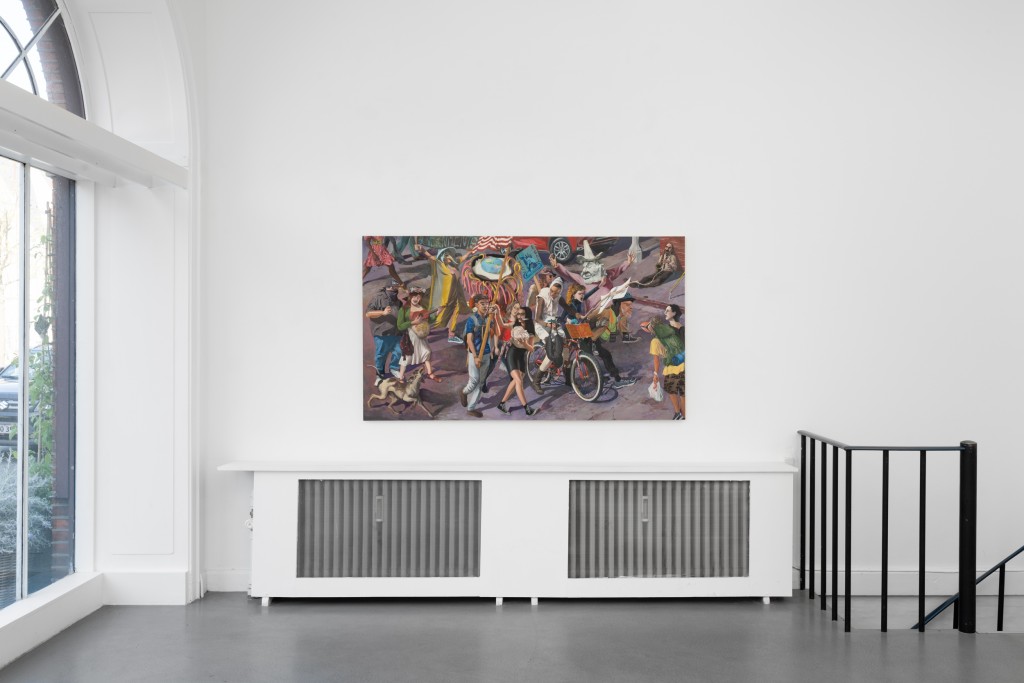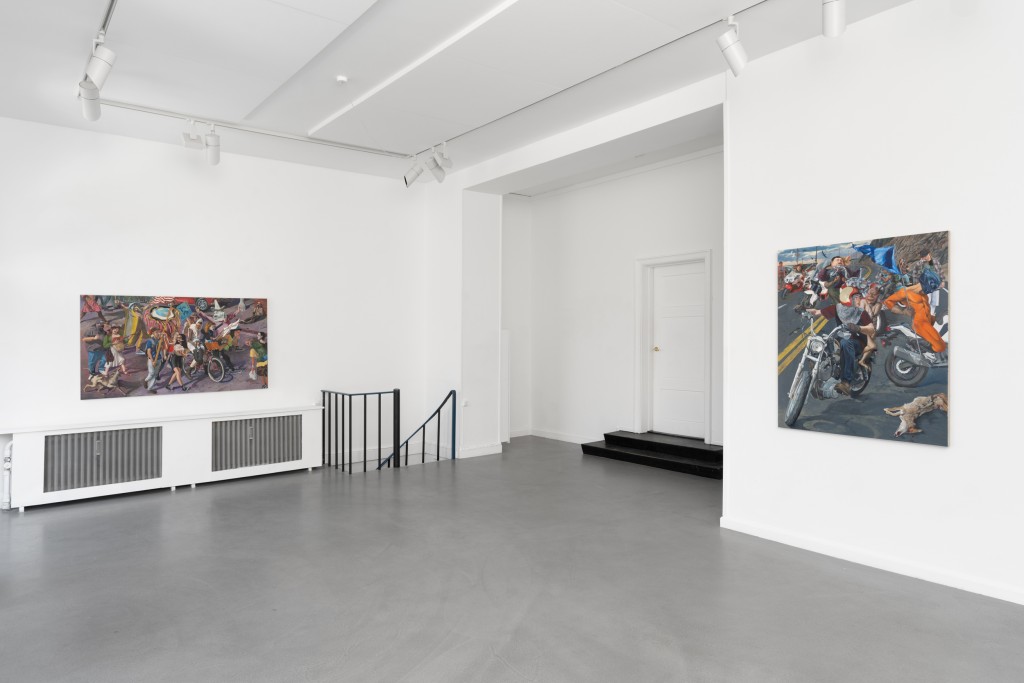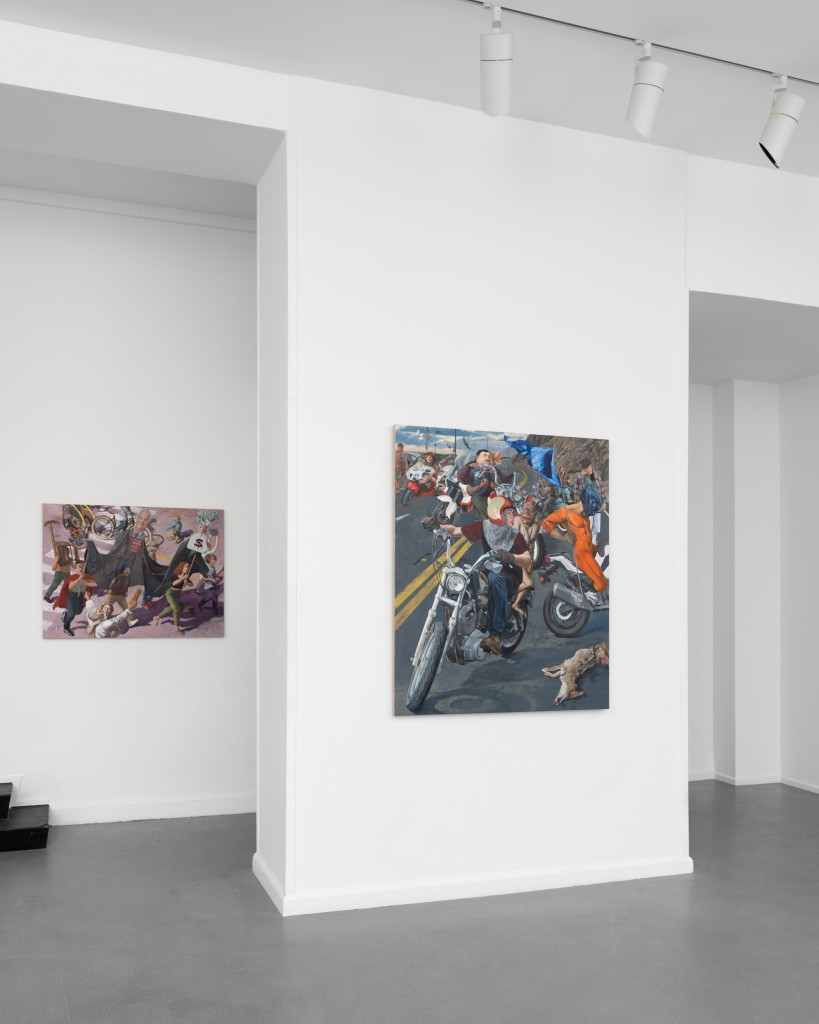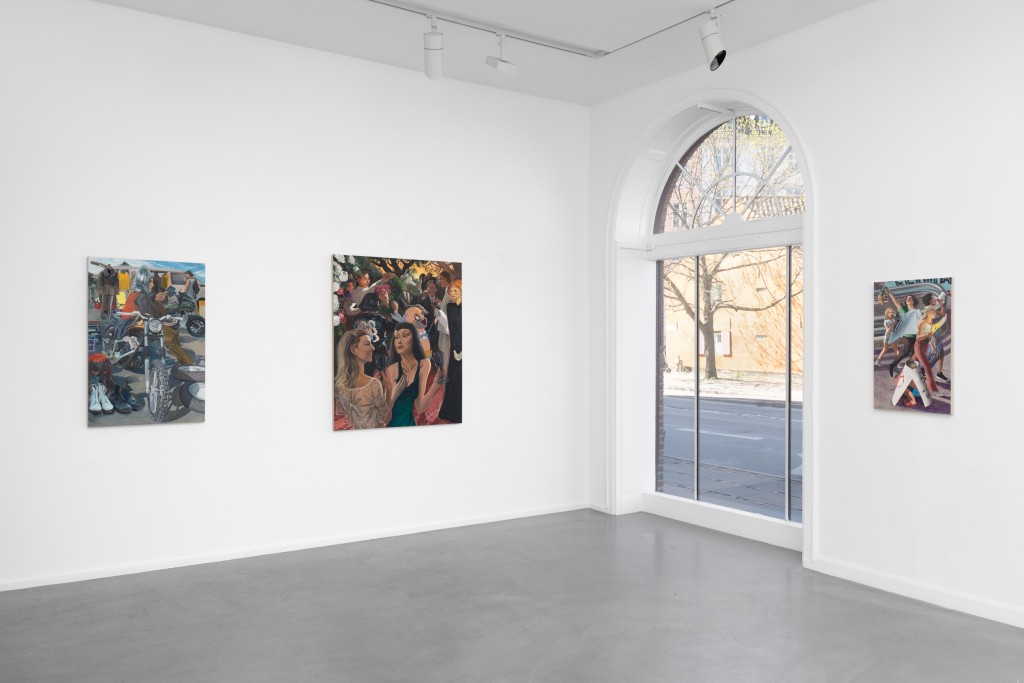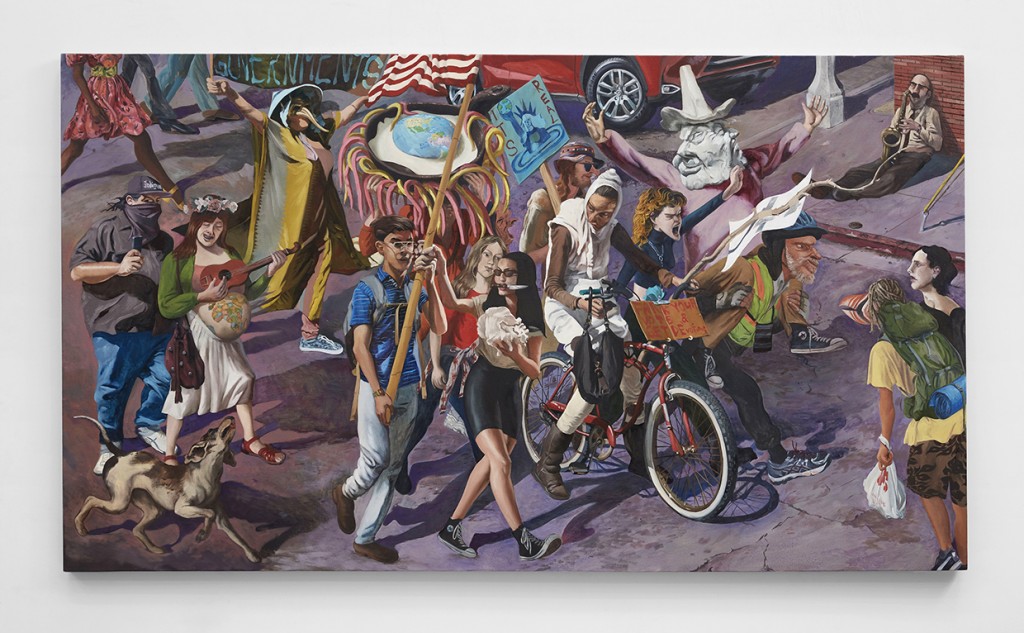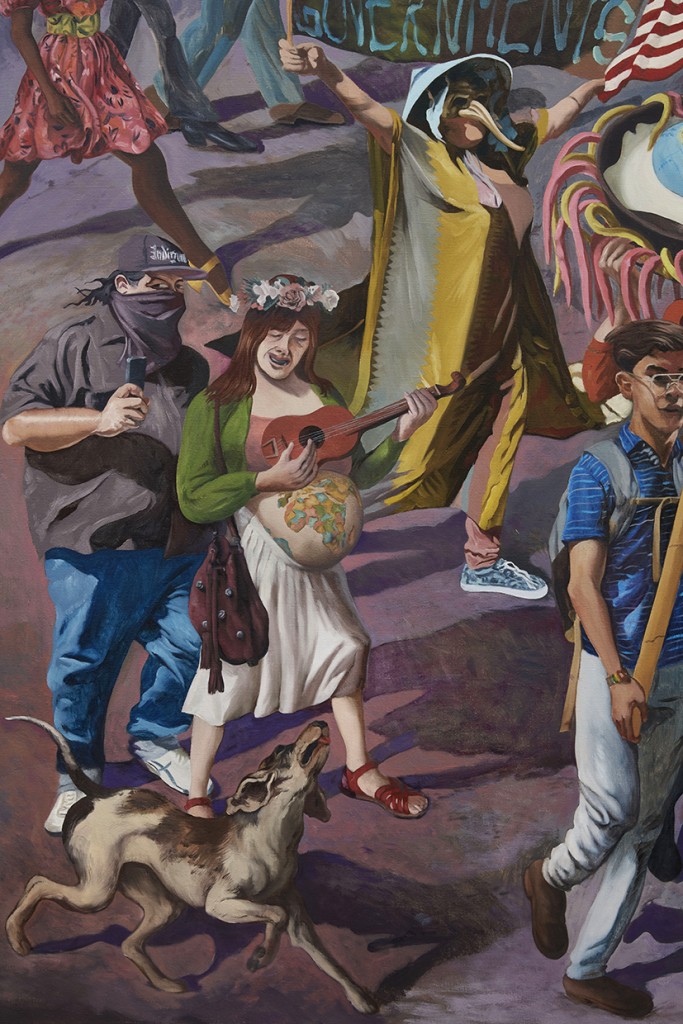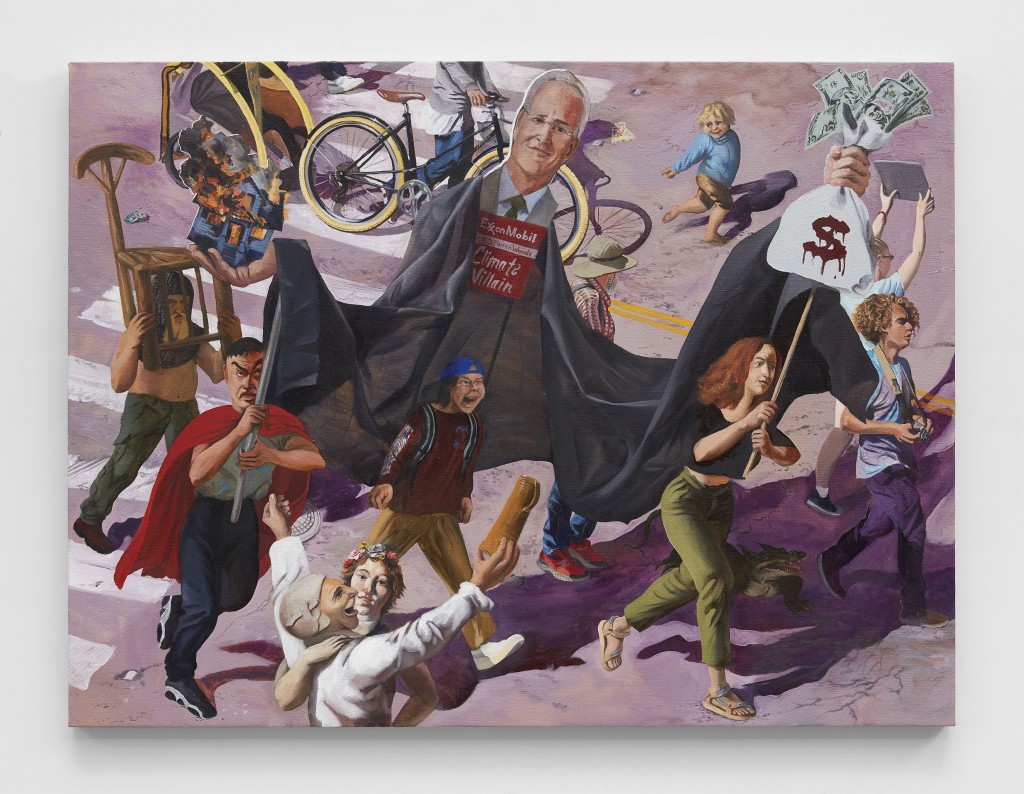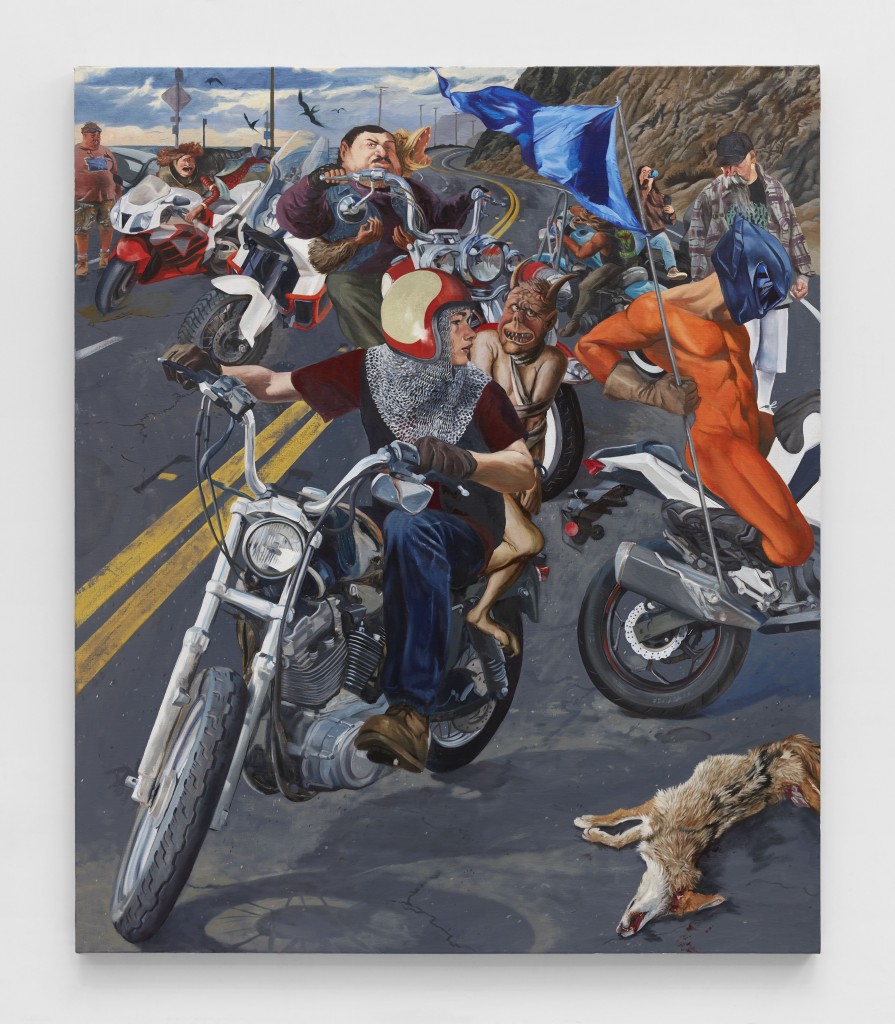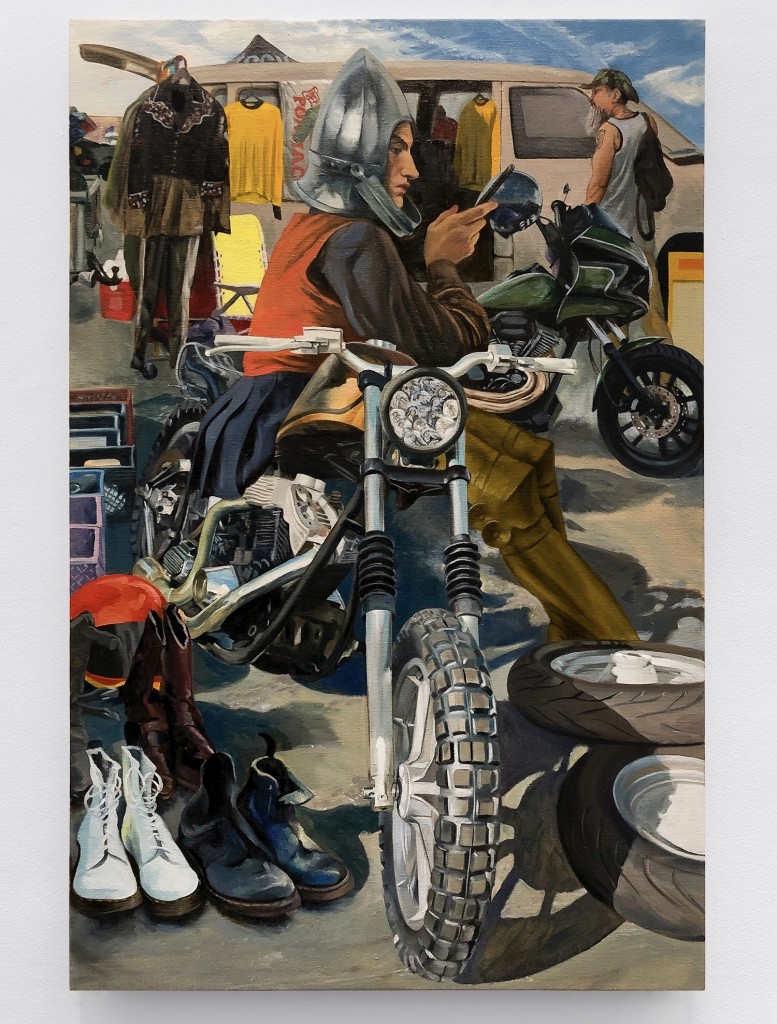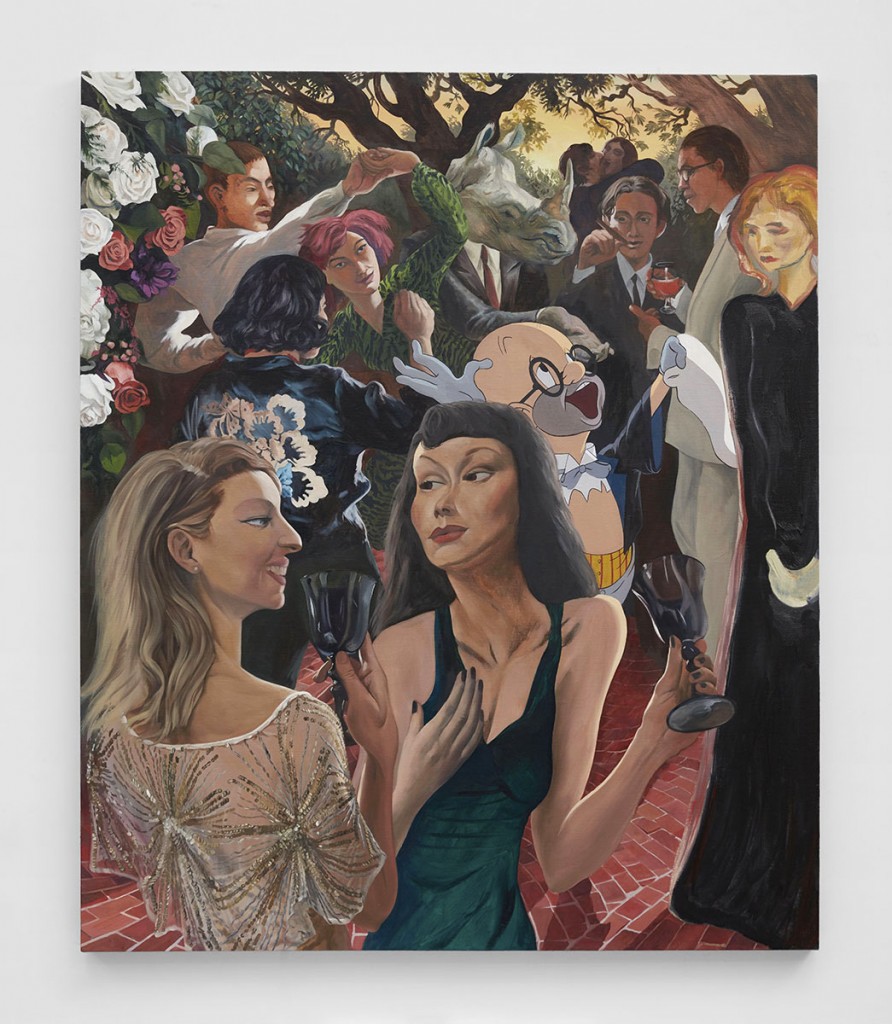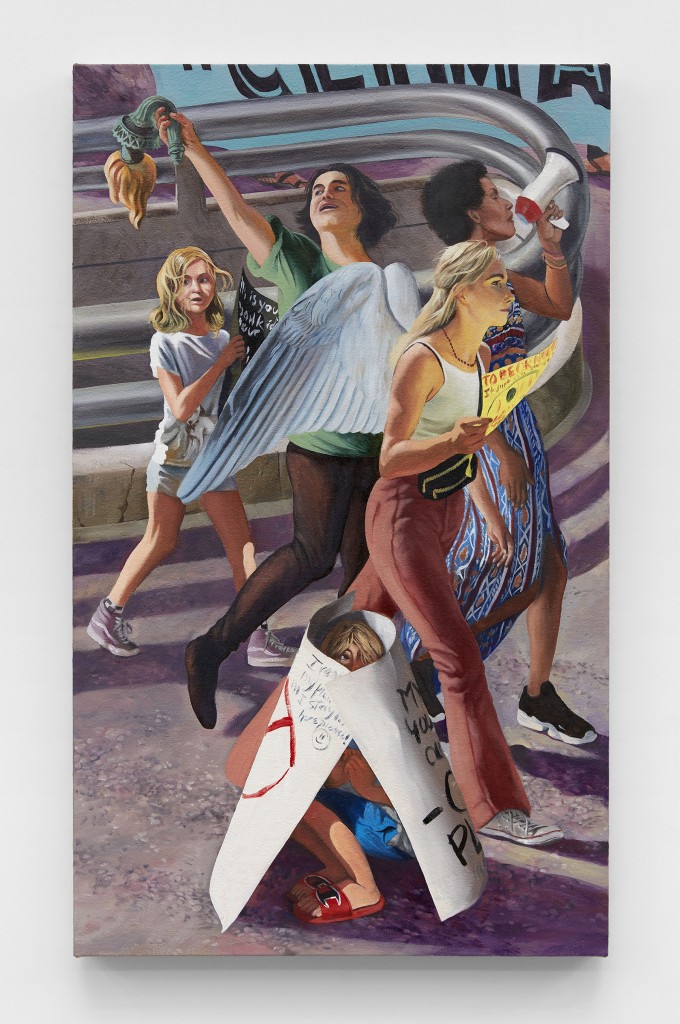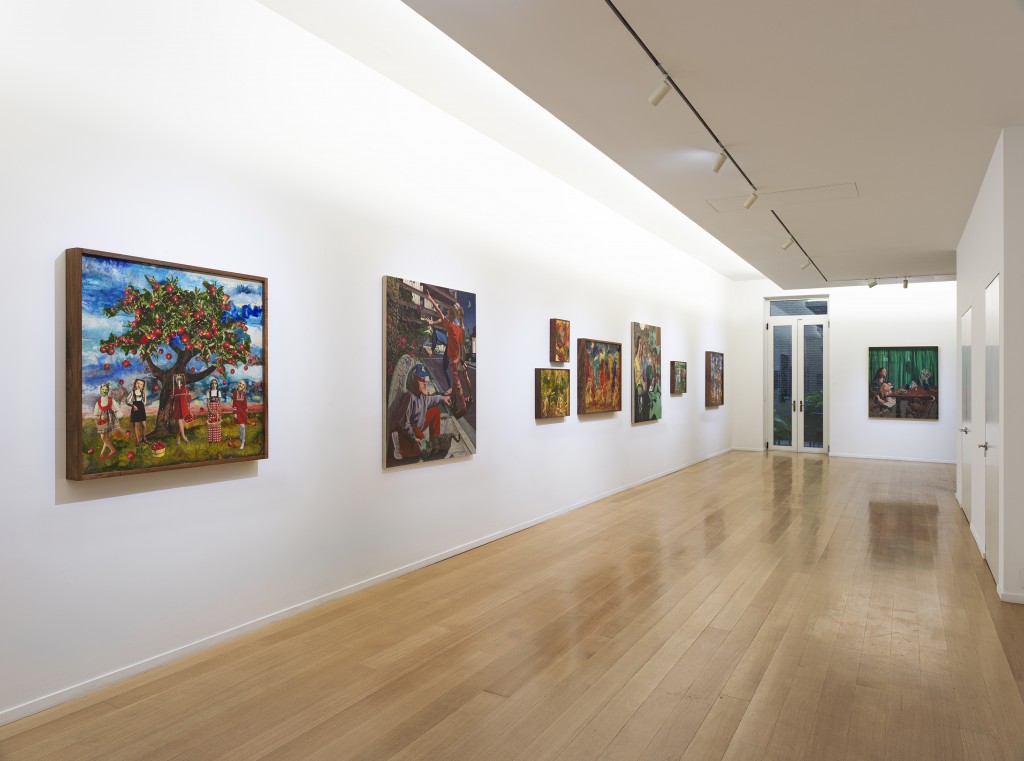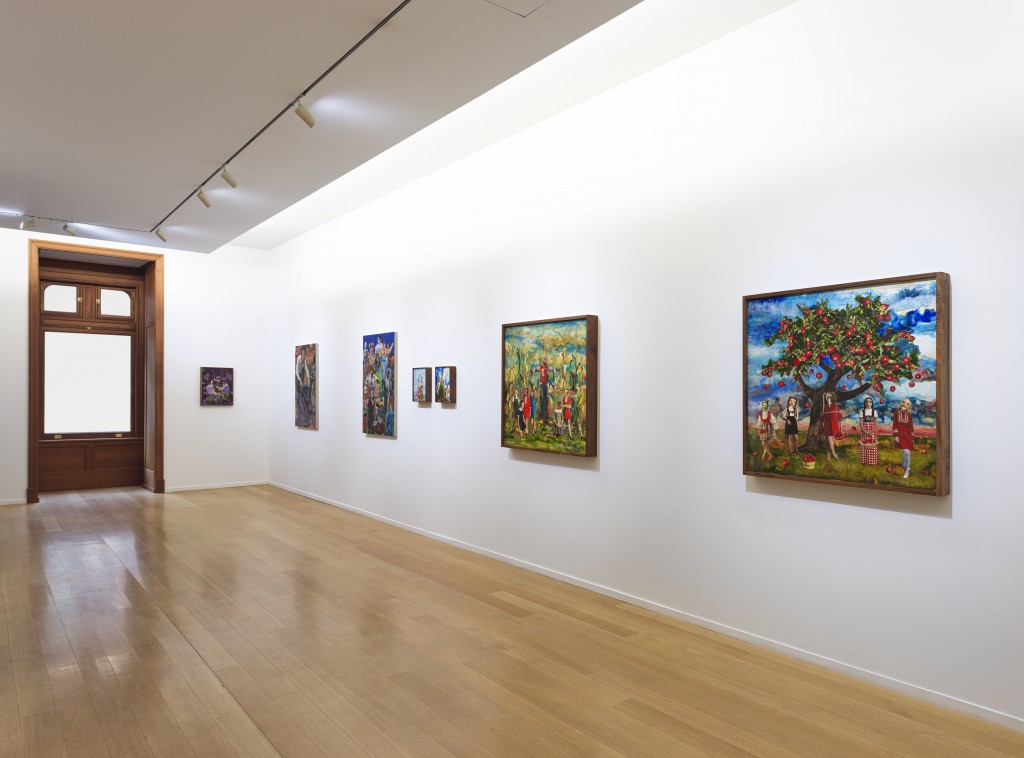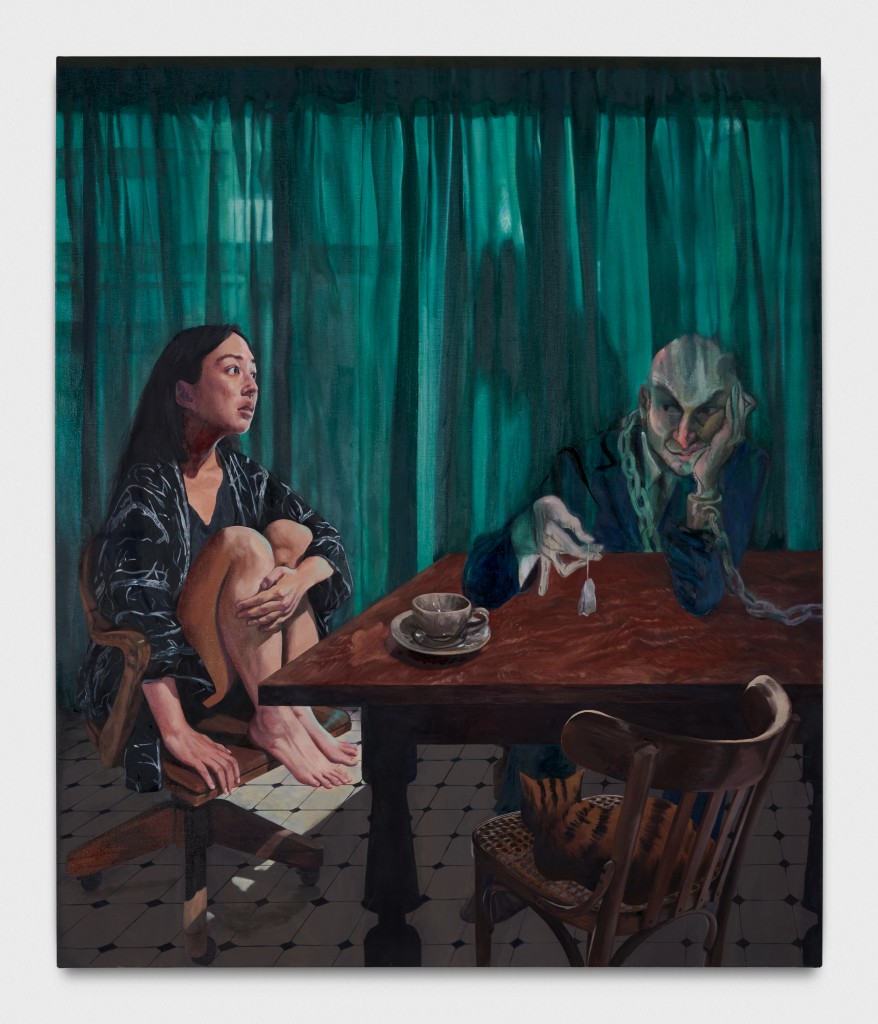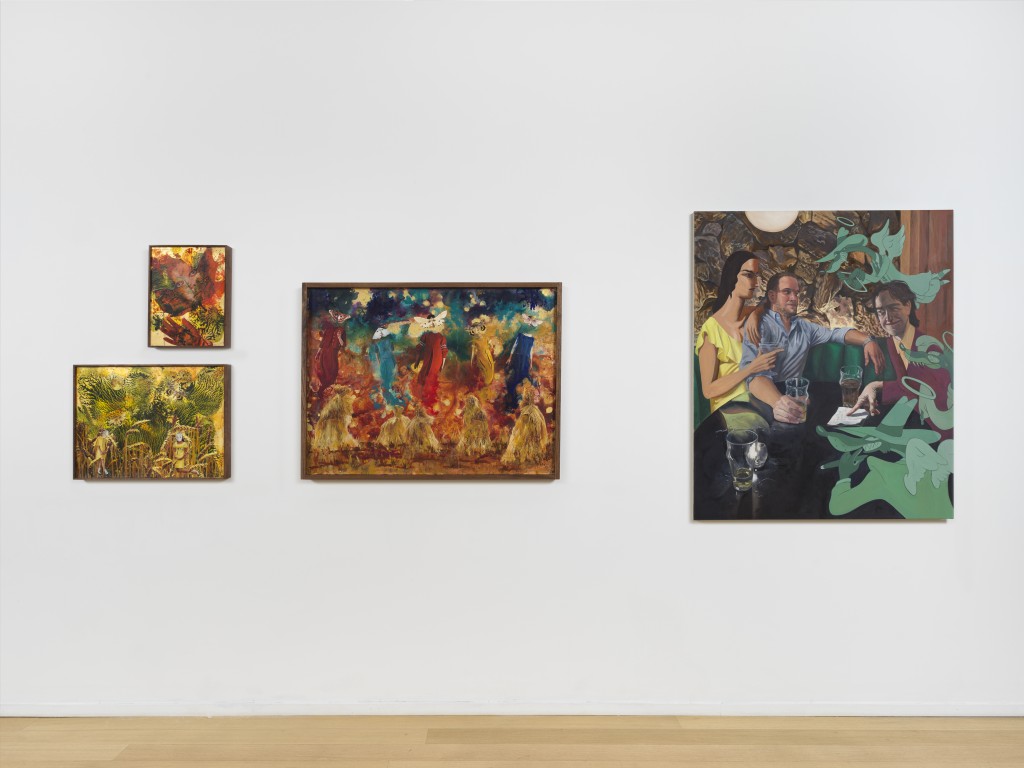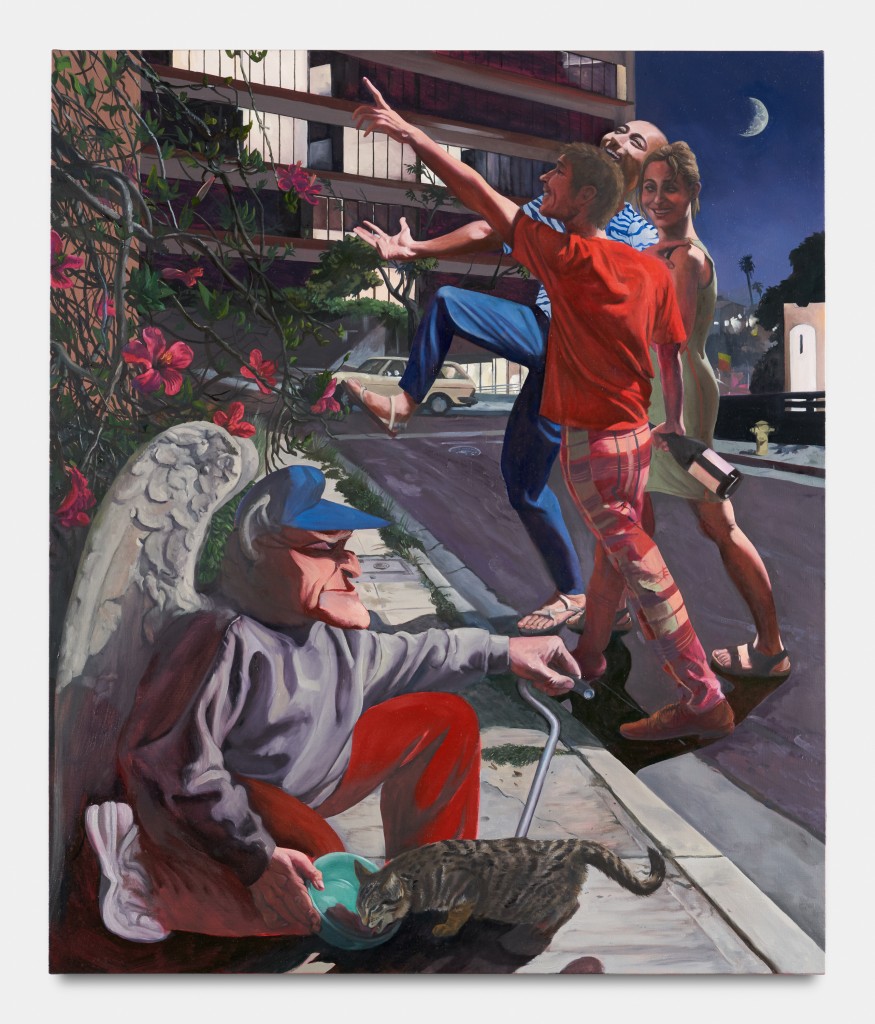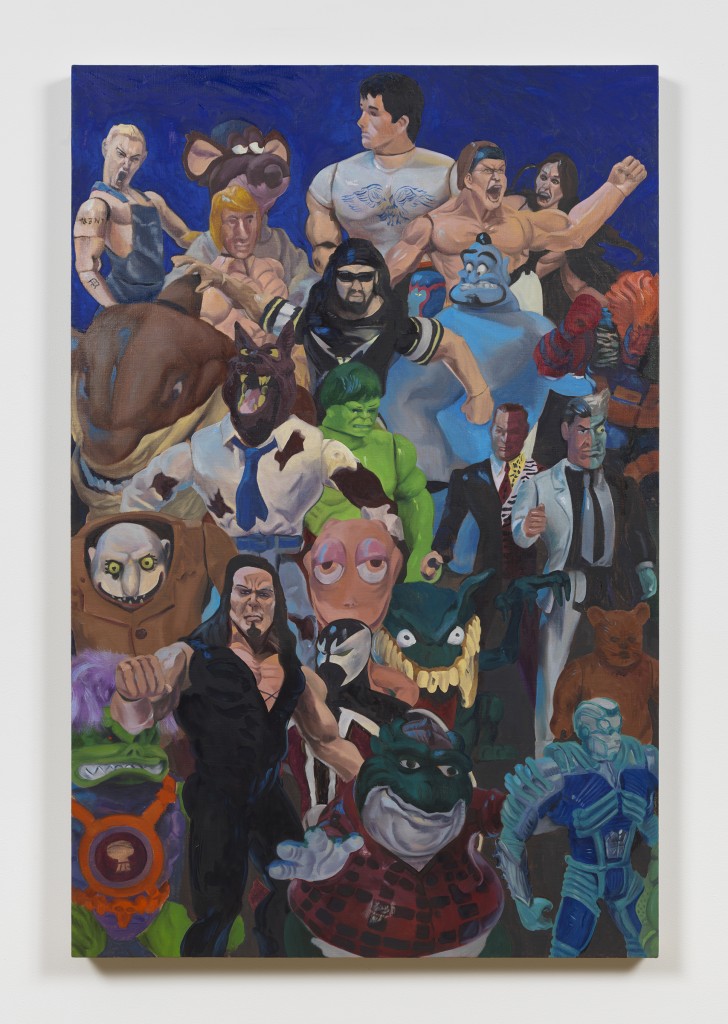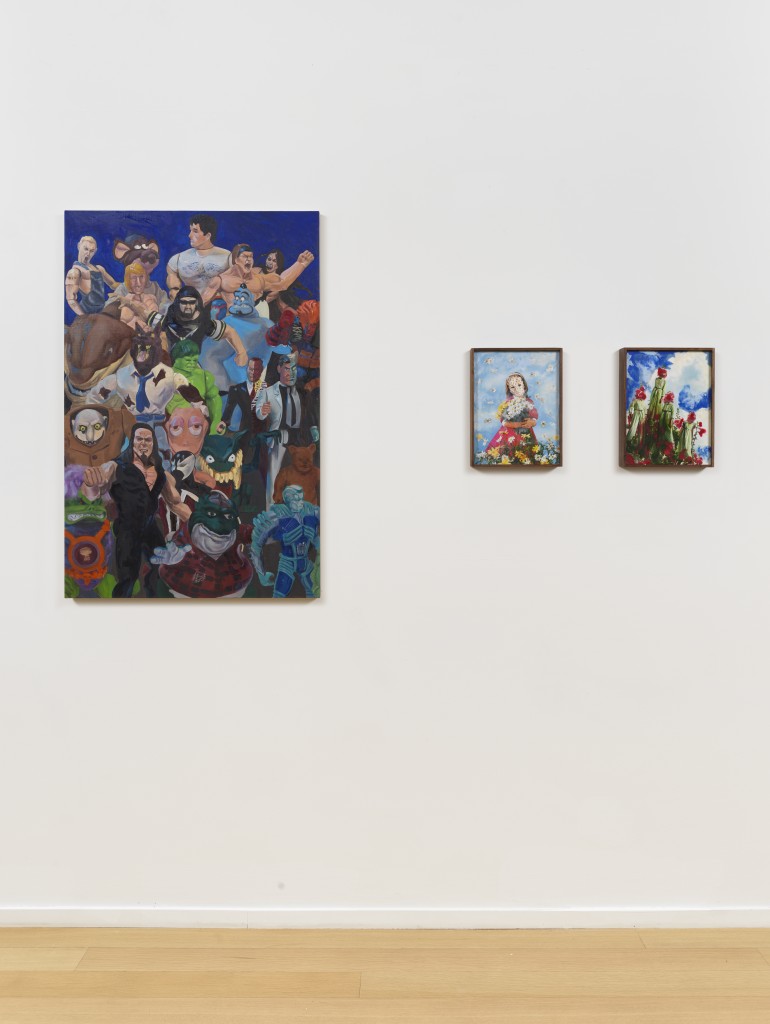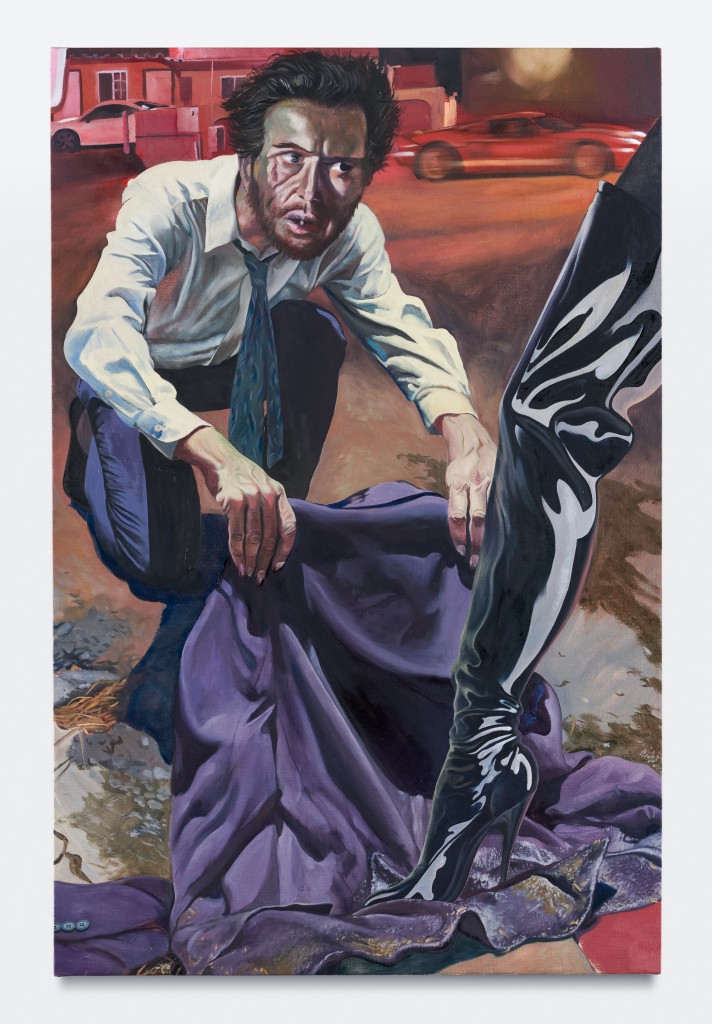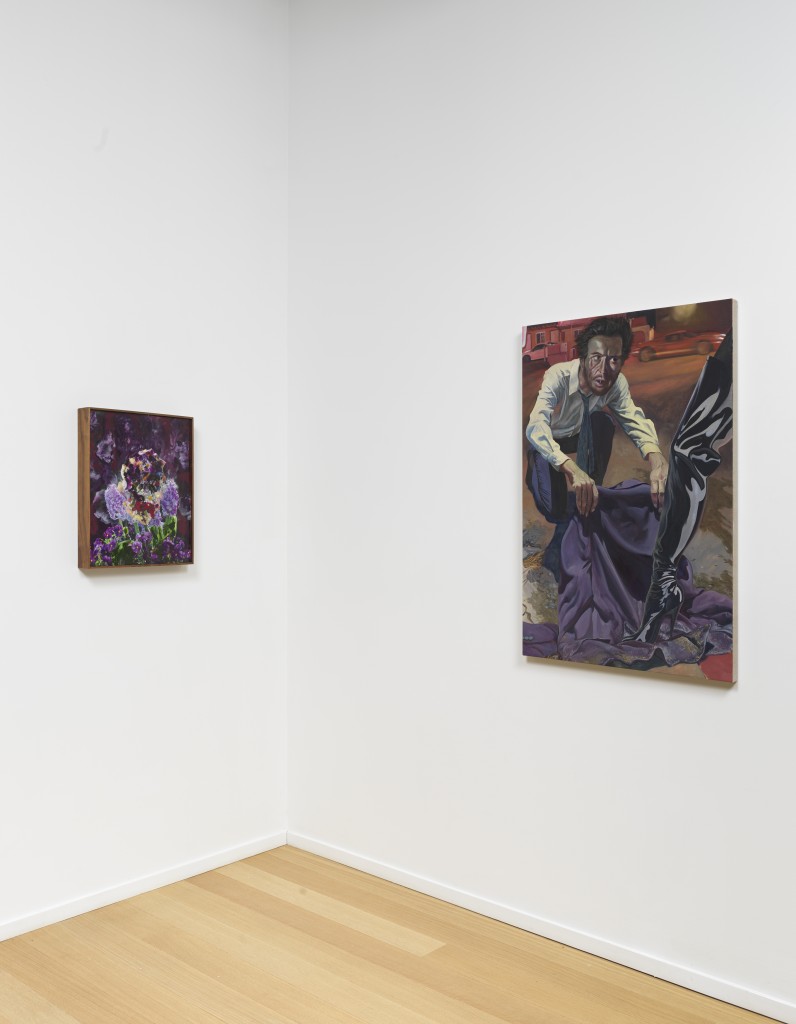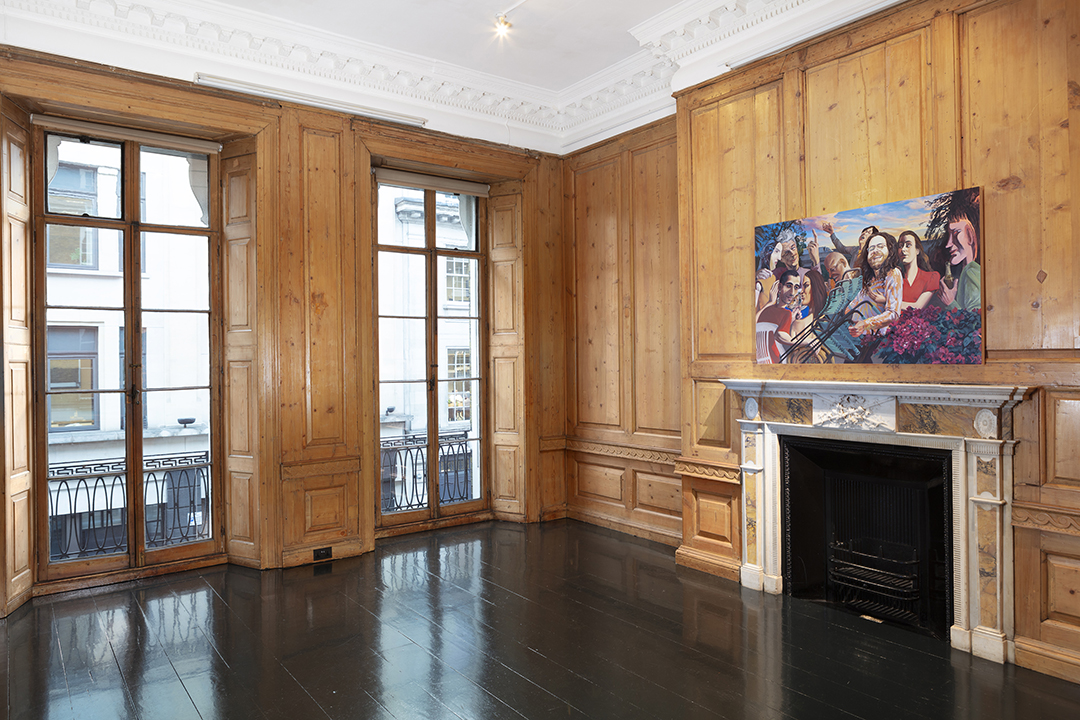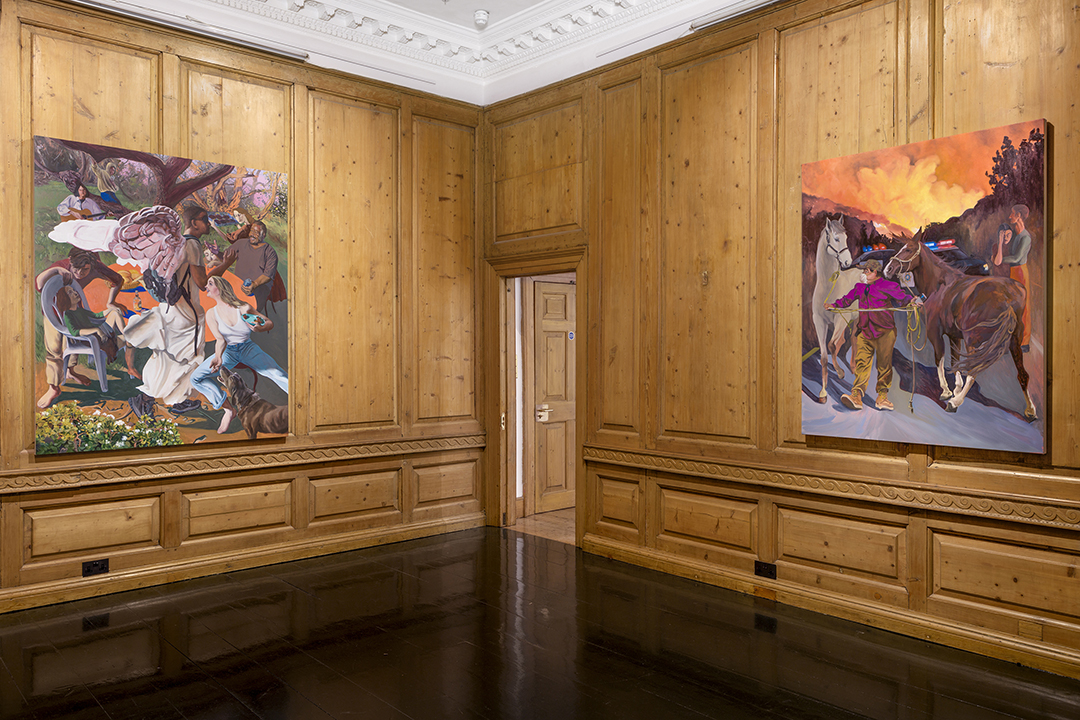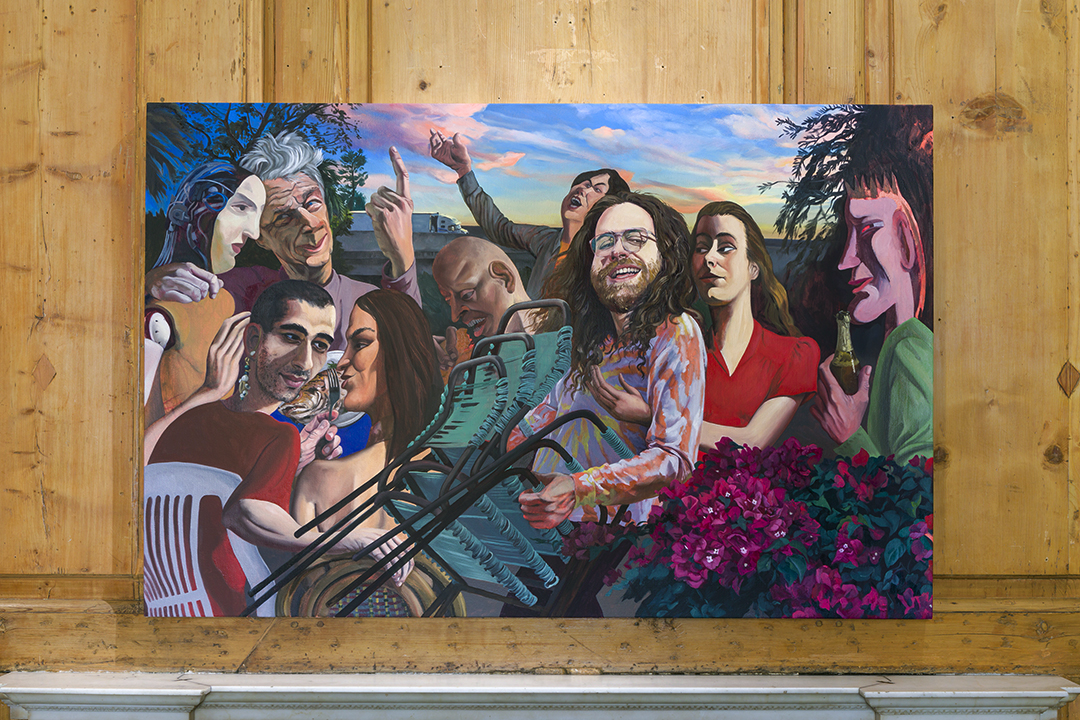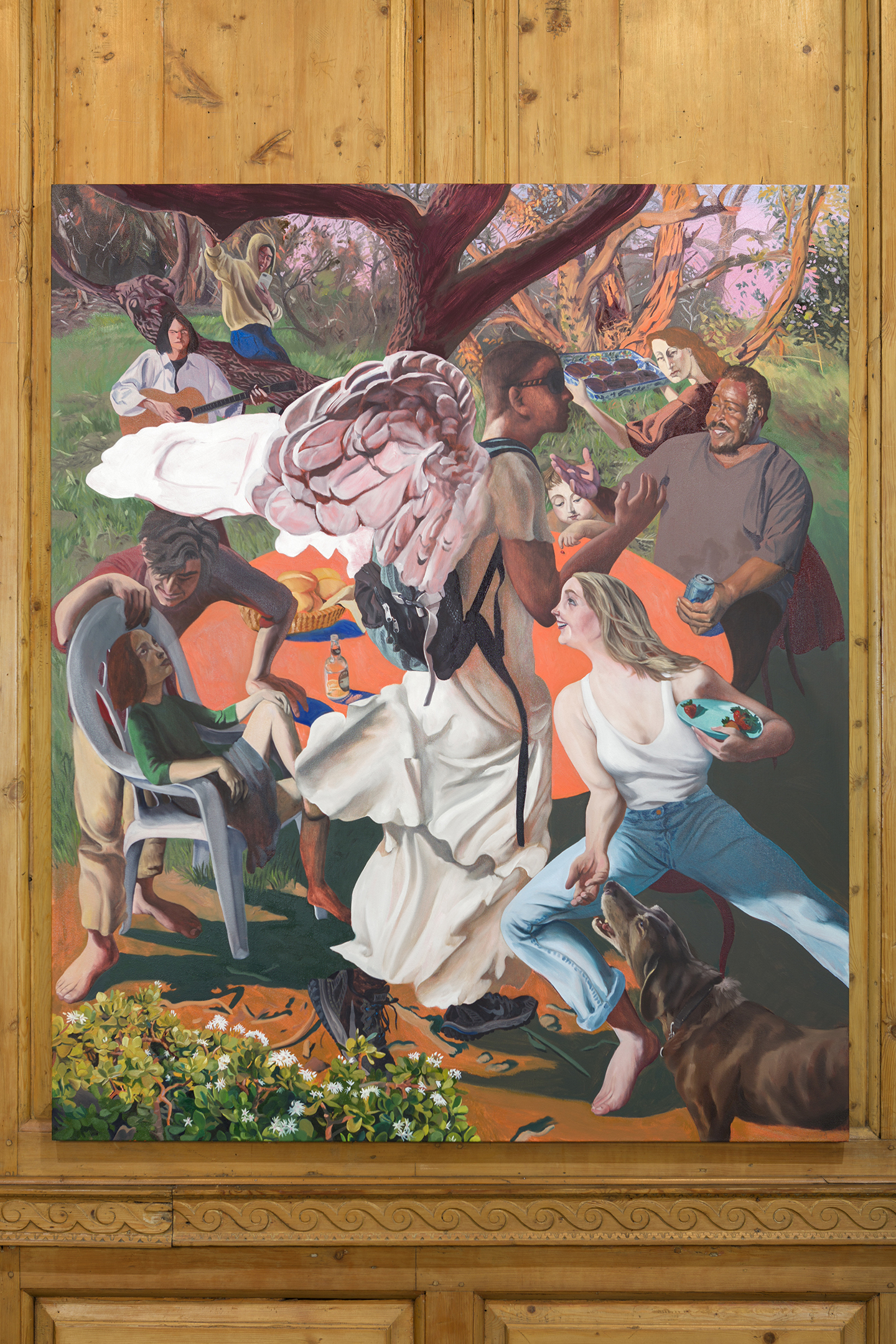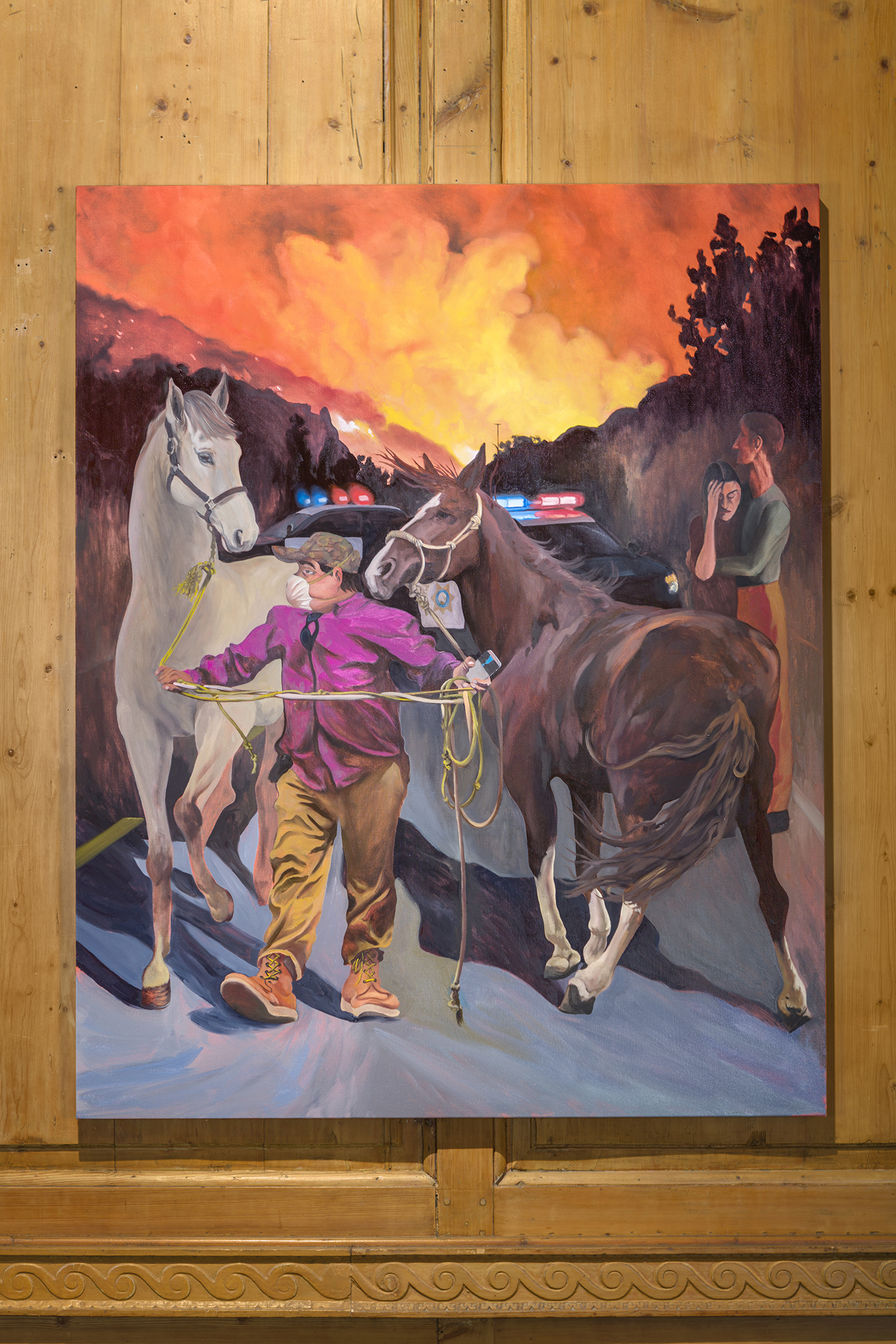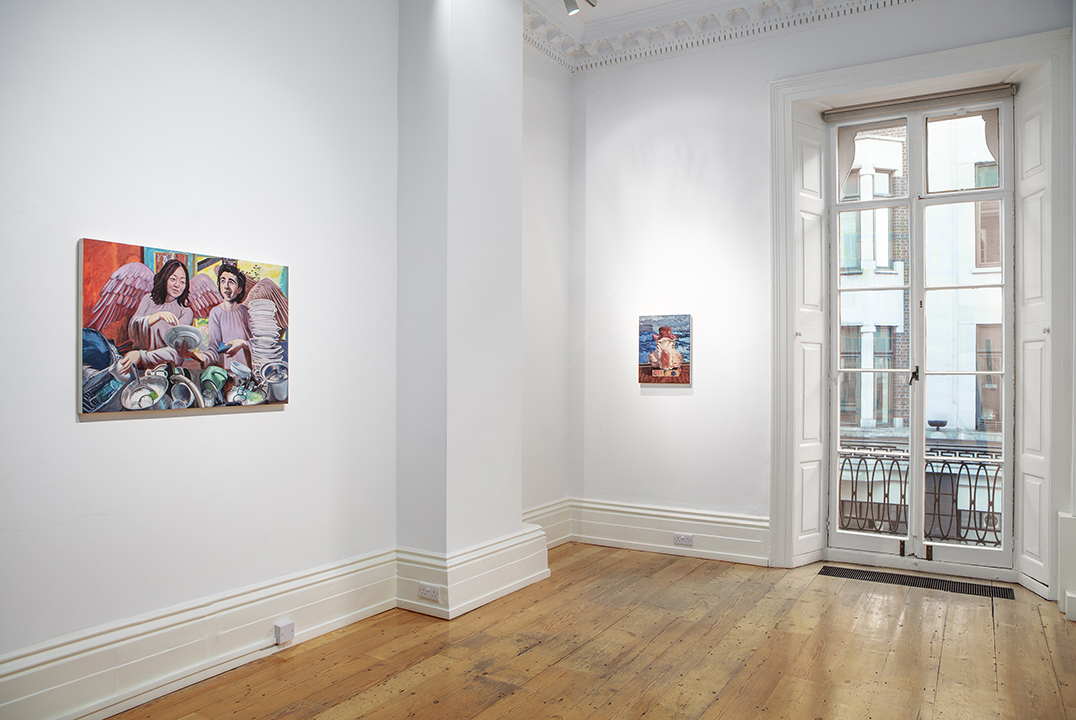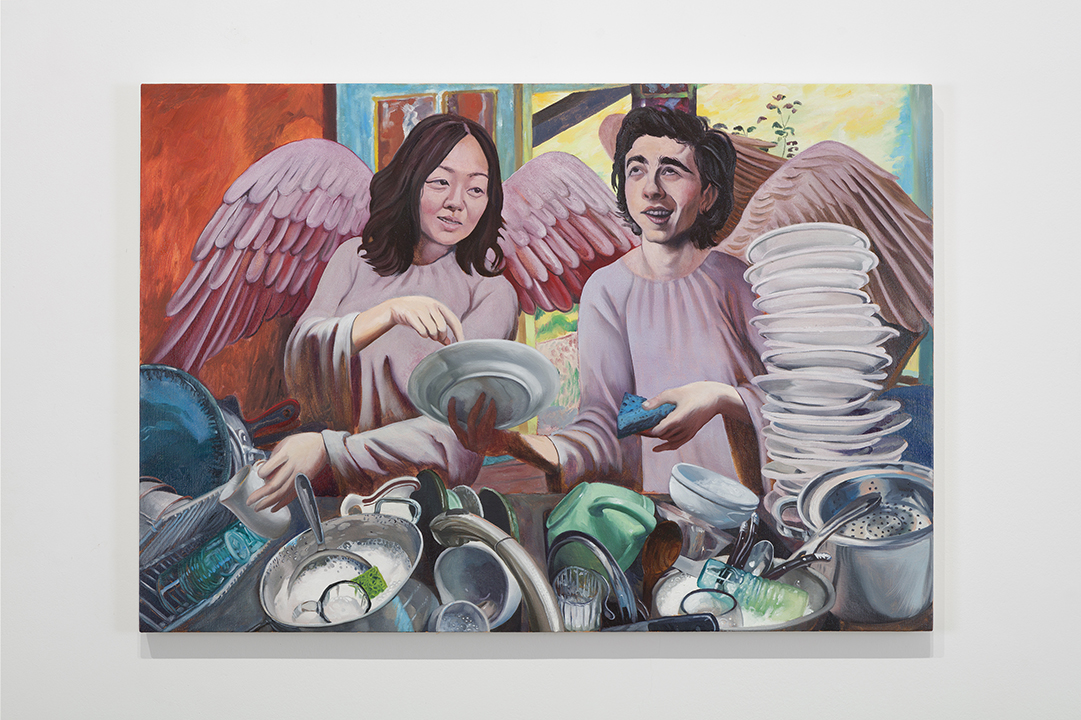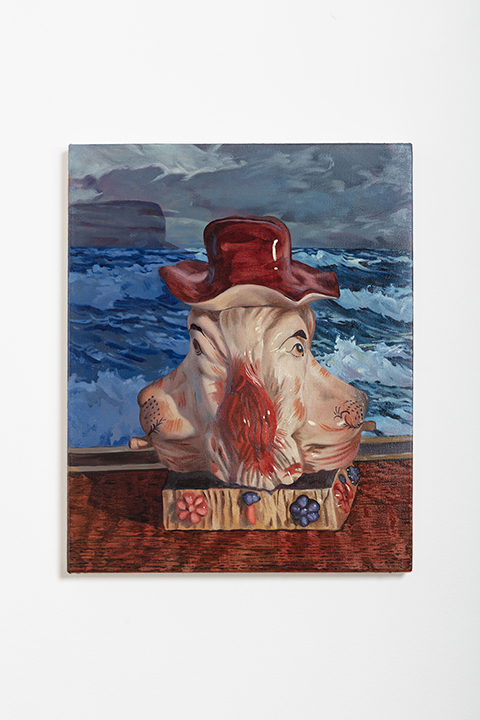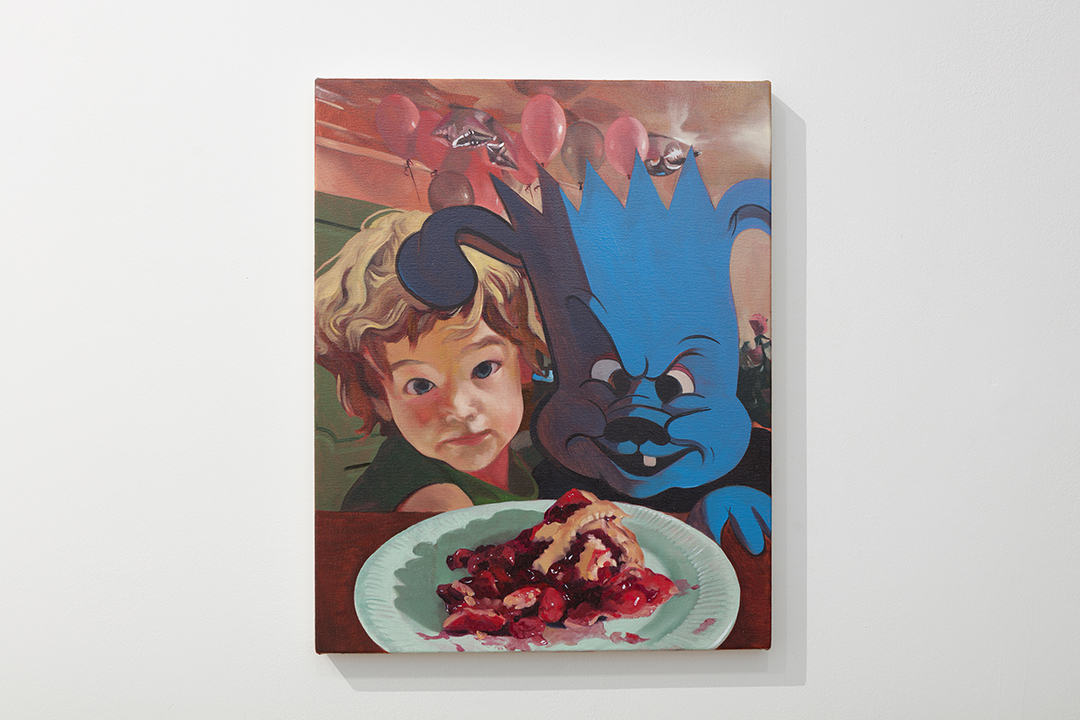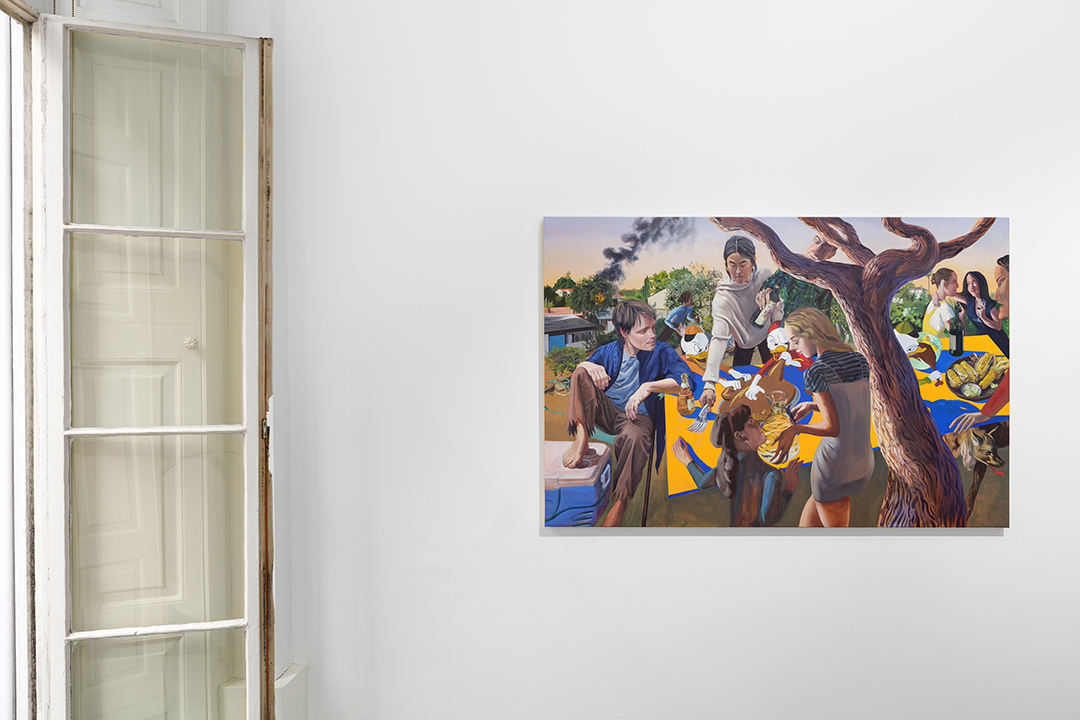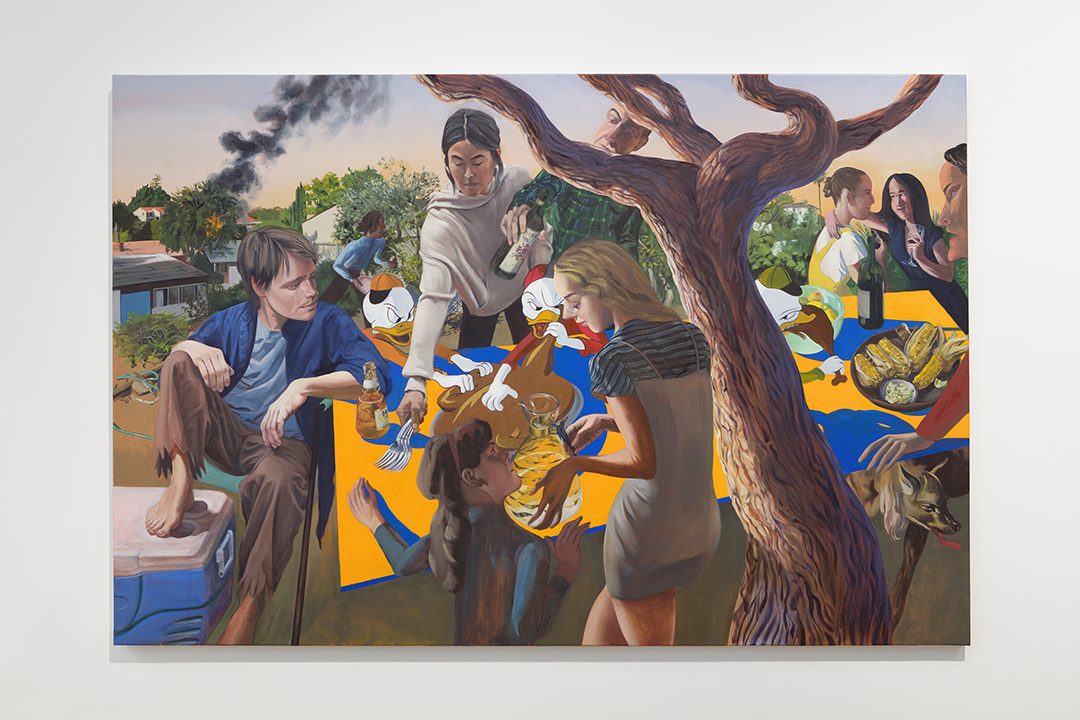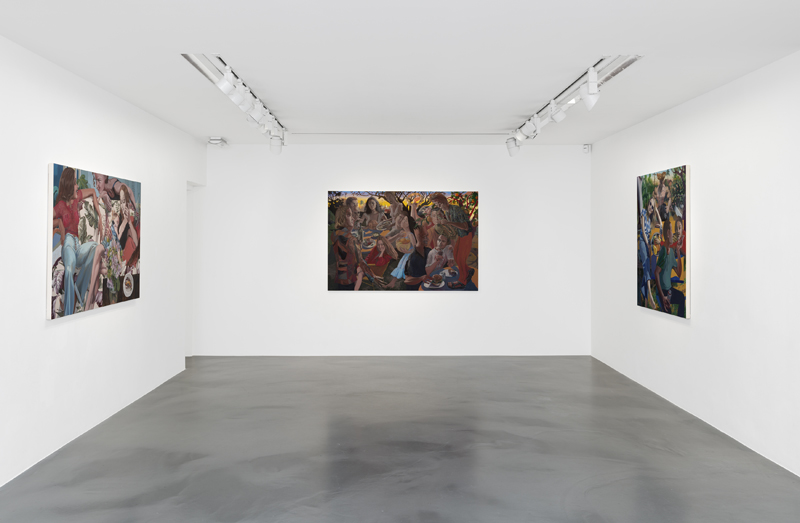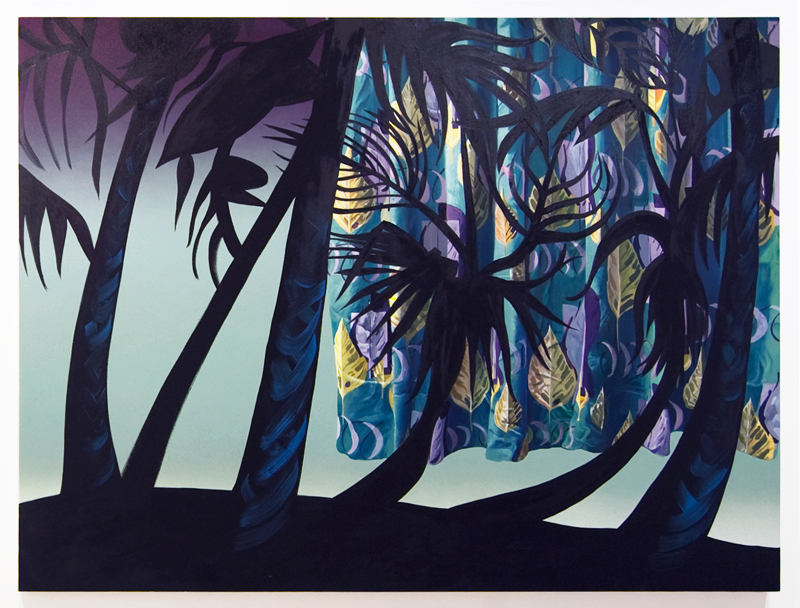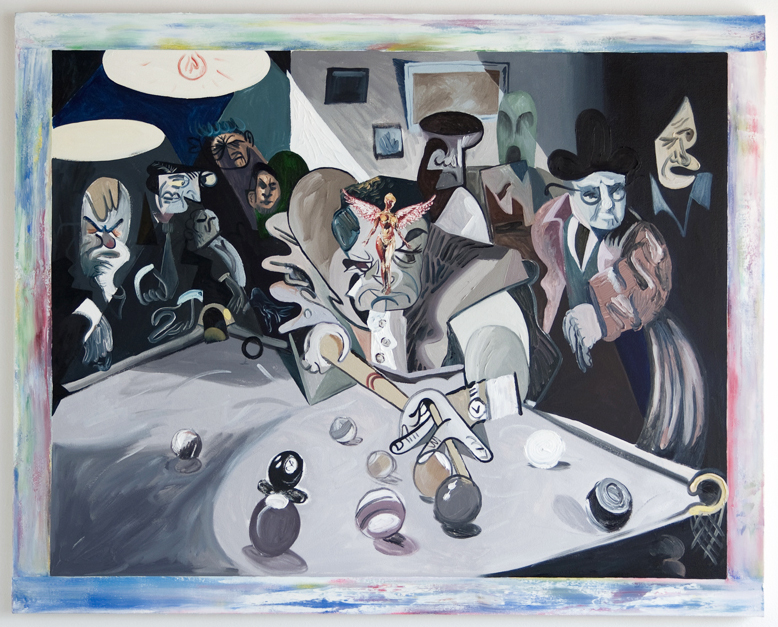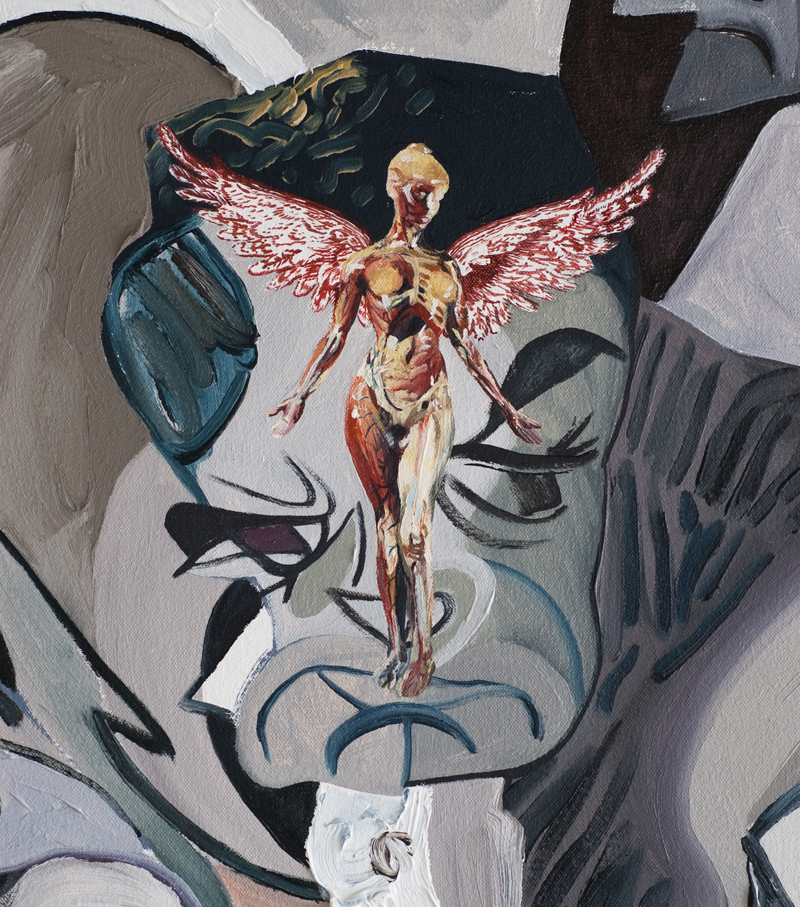Such Brilliant Service
- Such Brilliant Service, 2025, Oil on linen, 72 x 120 in, 182.9 x 304.8 cm
Particular Dish








Room for Sweets, 2025, Oil on linen, Unframed: 48 x 36 in, 121.9 x 91.4 cm, Framed: 49 3/4 x 37 1/2 in 126.4 x 95.3 cm

Productive Introductions, 2025, Oil on linen, Unframed: 48 x 72 in, 121.9 x 182.9 cm, Framed: 49 1/2 x 73 1/2 in, 125.7 x 186.7 cm

A Seat at the Table, 2025, Oil on linen, Unframed: 48 x 72 in, 121.9 x 182.9 cm, Framed: 49 1/2 x 73 1/2 in, 125.7 x 186.7 cm

Meeting a Celebrity, 2025, Oil on linen, Unframed: 60 x 38 in, 152.4 x 96.5 cm, Framed: 61 3/4 x 39 1/2 in, 156.8 x 100.3 cm

Waiter, 2024, Graphite and color pencil on paper, Unframed: 10 1/4 x 7 3/4 in, 26 x 19.7 cm, Framed: 15 1/4 x 13 in, 38.7 x 33 cm

Waiter, 2024, Ink and watercolor on paper, Unframed: 10 1/4 x 7 3/4 in, 26 x 19.7 cm, Framed: 15 1/4 x 13 in, 38.7 x 33 cm

Serviette (Katja), 2025, Oil on linen, Unframed: 48 x 36 in, 121.9 x 91.4 cm, Framed: 49 3/4 x 37 1/2 in, 126.4 x 95.3 cm

Dinner People (Study for: A Seat at the Table), 2024, Graphite and watercolor on paper

Such Brilliant Service, 2025, Oil on linen, 72 x 120 in, 182.9 x 304.8 cm

They are Making Reservations, 2025, Oil on linen, Unframed: 60 x 38 in, 152.4 x 96.5 cm, Framed: 61 3/4 x 39 1/2 in, 156.8 x 100.3 cm

Still Working, 2025, Oil on linen, Unframed: 48 x 72 in, 121.9 x 182.9 cm, Framed: 49 1/2 x 73 1/2 in, 125.7 x 186.7 cm

An Excellent Choice, 2025, Oil on linen, Unframed: 60 x 38 in, 152.4 x 96.5 cm, Framed: 61 3/4 x 39 1/2 in, 156.8 x 100.3 cm
https://www.matthewbrowngallery.com/exhibitions/justin-john-greene2?view=slider#5
Matthew Brown is pleased to present Particular Dish, an exhibition of new paintings and drawings by Los Angeles-based artist Justin John Greene. In this body of work, Greene transforms the restaurant table into a stage for labor and tension—using caricature and cultural reference to probe the social and psychological dynamics beneath scenes of shared indulgence.
Each painting in Particular Dish is grounded by a table that anchors the lower portion of the composition. On each spread, the remnants of a meal accumulate into a painterly debris field of lipsticked glasses, smudged plates, and half-eaten food. These cluttered surfaces recall Daniel Spoerri’s Snare Pictures, freezing the moment just after consumption. Like Spoerri, Greene is less concerned with the feast than with what’s left behind: the residue, the evidence, the psychic weight of a meal already over but not yet cleared.
Above the table line, diners are rendered in a cacophony of styles, shifting from observed portraiture to expressionistic caricature. Familiar faces appear at the table: old Hollywood stars, art world regulars, the artist himself, and members of his personal orbit. Their bodies twist and collide into one another in manic, euphoric configurations. Waitstaff weave through the compositions like unstable satellites, their features stretched and distorted into futurist machines. These distortions suggest not only the dehumanizing rhythms of service labor but also an unraveling beneath the surface choreography of hospitality.
The format evokes the tradition of the 20th-century restaurant mural, particularly the celebrity caricatures of Al Hirschfeld at Hollywood’s historic Frolic Room and Edward Sorel at the Monkey Bar in Manhattan—works that flattened nightlife into a social mythology. Greene references this lineage, pushing the format into portraits of pressure, excess, and emotional fray, charged with both manic celebration and psychological observation. His approach draws on the tradition of artists using restaurants, bars, and taverns as condensed stages for social commentary, settings where the dynamics of society are played out through the rituals of dining, drinking, and display. Through his varied approach to portraiture, exaggeration becomes both a visual strategy and a subject in its own right. What emerges is a layered image of the gallery dinner, imagined as a concentrated site of art-world and capitalist logic, where appetite, attention, transaction, and exhaustion collide.
Across Particular Dish, Greene leans into the instability of the scene. Styles shift mid-composition, producing a manic elasticity that reflects his ongoing exploration of figuration and distortion, structure and collapse. The paintings oscillate between indulgence and service while foregrounding the artist’s labor—the decisions, revisions, and psychic weight embedded in the act of making. Rather than offering a tidy critique of capitalism, Greene examines the systems of hunger that shape us: for intimacy, value, meaning, and attention. Ultimately, Particular Dish is not just a portrait of that system, but of the conditions that allow it to endure. The lingering question: what does it mean to show up hungry?
Sunset Boulevard intro
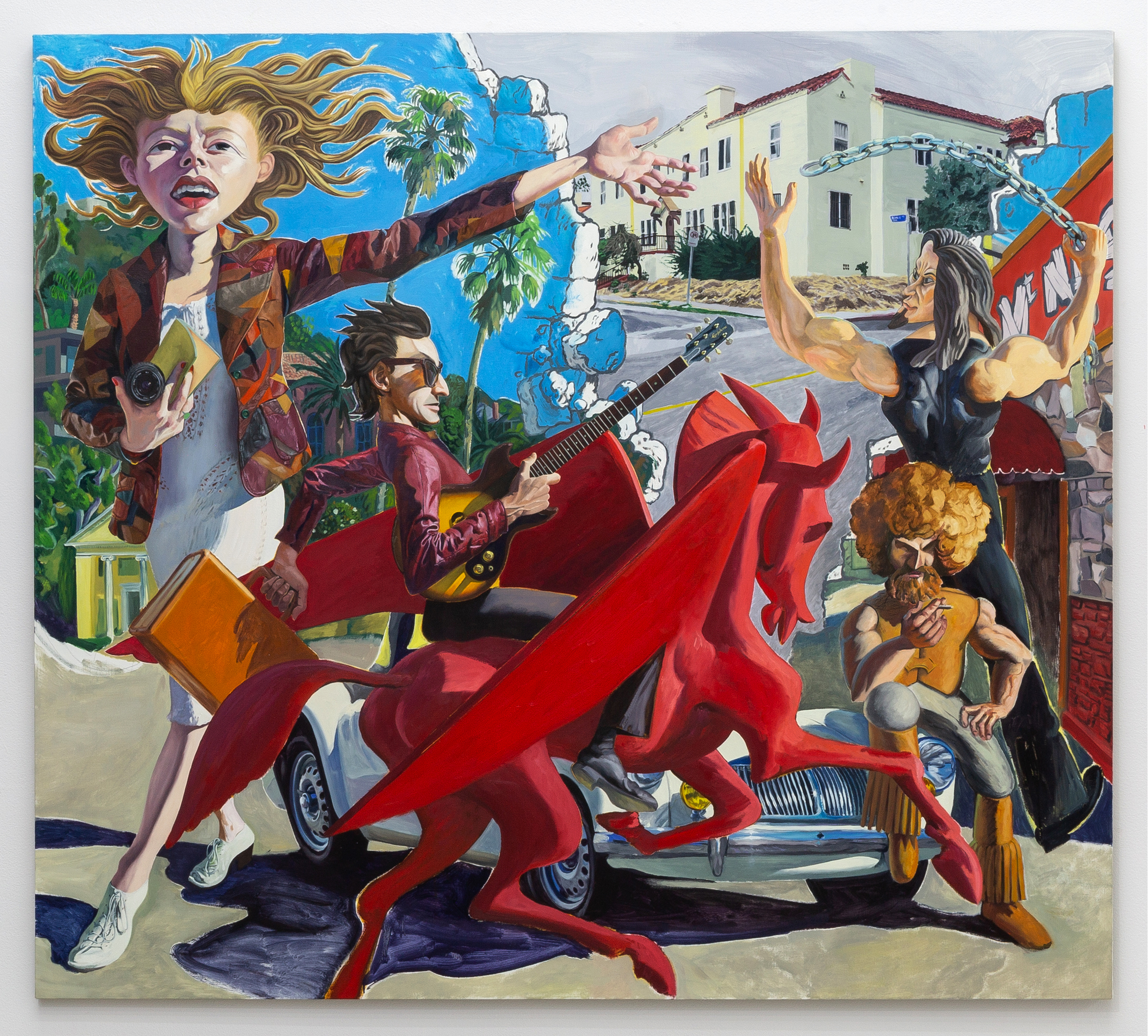
Sunset Boulevard, 2023, oil on linen, 65 x 72 inches
Dressed in Hollywood Tears
- Sunset Boulevard, 2023, oil on linen, 65 x 72 inches
- Driver seat, 2023, oil on linen, 30 x 42 inches
- Gas Station, 2023, oil on linen,30 x 18 inches
- Gas Station Pegasus, 2023, polymer clay and oil paint, 10 x 13 x 9 inches
- Gas Station Pegasus, 2023, polymer clay and oil paint, 10 x 13 x 9 inches
- Patchwork leather jacket archetype, 2023, gouache, watercolor and ink on paper, 13 x 20 inches
- Sessions, 2023, ink on paper, 17 x 14 inches
- Tricksters, 2023, ink on paper, 20 x 17 inches
- Hey? What’s the big idea?, 2023, watercolor and ink on paper 14 x 17 inches
- Gas Station Pegasus, 2023, gouache, watercolor and ink on paper, 11 x 15 inches
- Pepi, 2023, oil on linen, 32 x 24 inches
- Hey? What’s the big idea?, 2023, oil on linen, 44.5 x 33.5 inches
- Studio, 2023, oil on linen, 48 x 72.25 inches
Dressed in Hollywood Tears,
November 9, 2023–December 23, 2023
The Breeder, Athens
The Breeder is pleased to announce Dressed in Hollywood Tears, an exhibition of new works by LA based artist, Justin John Greene. This is the artist’s first solo show in Athens. Greene’s iconography consists of familiar yet uncanny characters who merge the illusionary with the realistic, presenting tragicomic narratives in a most ambiguous and intimate way.
For his show at The Breeder, the artist creates a new series of paintings along with drawings and a sculpture, all inspired by Greene’s personal experience of loss enmeshed with the scenography of his native Los Angeles surroundings. Dressed in Hollywood Tears, takes its title from a song lyric written by the artist’s late father, a rock musician and recording artist, whose death became the starting point of the unravelling of a personal as well as communal narrative.
In many of the works on view, Greene uses the motif of a broken wall. Symbolizing a rupture between the world colored by his father’s presence, depicted as an almost mythical realm populated with archetypes and figures from his life, contrasted, on the other side of the wall, against a drabber and soberer view of his own daily surroundings, such as his apartment building or a freeway exit.
Greene’s approach towards oil painting makes use of the medium’s pictorial and emotional malleability, skillfully shifting from fast expressive brush strokes to illustrative details. His works are rich in stylistic diversity, evoking various emotions and cultural references through the different elements that compose his intricate compositions.
Influenced by Max Beckmann’s post expressionistic imagery and Jörg Immendorff’s large scale syntheses, Greene creates a surreal, sometimes dystopic ambience, filled with cartoon-like characters, aggressive colors, grotesque forms, muses and demons, enigmatic personas and an imposing executive. The music industry and in particular the former art design group Hipgnosis, that specialized in creating album cover artwork for rock bands, such as the Pink Floyd, Led Zeppelin, and many more is also a major influence enriching this exhibition with dashes of ironic, humorous and bizarre representations.
A red Pegasus, based on a graphic used by the Mobil gas station company, appears in many forms throughout the show. Its use attempts to compound the mythical creatures’ majestic attributes with both the compelling allure of classic car culture and the pitfalls of nostalgically romanticizing the late 20th century. Along with his father’s passing, Greene revisits his memoirs of a rather romantic, idealistic era that is dramatically crumbling away, like the loss of a nation with all of its culture and infrastructure. The artworks in Dressed in Hollywood Tears, express a desire to use mythology as a way of narrating a personal experience of loss with a dramatic and tragic tone that feels more truthful than the reality.
The Castle
- Crude Mockery, 2022, Oil on linen, 60 x 72 inches
- Klamm, 2022, Oil on linen, 24 x 32 inches
- The Tap Room, 2022, Oil on linen, 72 x 120 inches
- Castle, 2022, Oil on linen, 20 x 16 inches
- We’ve certainly accomplished a great deal, 2022, Oil on linen, 72 x 60 inches
- Trouble, 2022, Oil on linen, 54 x 38 inches
- Dream, 2022, Oil on linen, 54 x 38 inches
- Distant and invisible causes on behalf of remote and invisible gentleman, 2022, Oil on linen, 72 x 60 inches
- Untitled Drawing 2022, Ink on paper, Unframed: 17 x 14 in
- Untitled Drawing 2022, Ink on paper, Unframed: 14 x 17 in
- Untitled Drawing 2022, Ink on paper, Unframed: 14 x 17 in
- Untitled (Sketchbook Drawing) 2022, Graphite and watercolor on paper, Unframed: 8.5 x 11 in
- Untitled (Sketchbook Drawing) 2022, Graphite and watercolor on paper, Unframed: 8.5 x 11 in
- Untitled (Sketchbook Drawing) 2022, Graphite and watercolor on paper, Unframed: 8.5 x 11 in
- Untitled (Sketchbook Drawing) 2022, Graphite and watercolor on paper, Unframed: 8.5 x 11 in
- Untitled Drawing 2022, Graphite on paper, Unframed: 24 x 18 in
https://www.matthewbrowngallery.com/exhibitions/justin-john-greene
Matthew Brown is pleased to present The Castle, a solo exhibition of recent works by Justin John Greene. Taking Franz Kafka’s novel of the same name as a point of departure, Greene re-envisions his native Los Angeles as an uncanny terrain that is at once familiar, farcical, and unnerving.
In the suite of drawings and paintings on view— the artist’s most boldly narrative works to date— Greene loosely casts friends and family as characters from the novel, which follows a man’s efforts to gain access to an enigmatic governmental authority in order to perform his job. Set high above the village in a castle, this authority is shrouded in mystery and bulwarked by a complex bureaucracy that the villagers implicitly embrace. For reasons beyond his understanding or control, the protagonist’s efforts are repeatedly thwarted, yet he remains steadfast in futile pursuit of his unattainable goal. In each tableaux, Greene adeptly merges this subject matter with figures and sceneries from his own personal surroundings to produce wry, tragicomic reflections on the frustrations of contemporary life.
Filtered through Greene’s dexterous brush, familiar L.A. nightlife locales like the Red Lion Tavern and Edendale become surreal, abstruse, and even perilous. Ordinary social situations are suffused with both humor and an underlying class anxiety as Greene’s characters attempt to negotiate the nebulous boundaries between labor and recreation. Comprised of multiple actual and fictional identities, they rarely appear to be fully at home as they perform their prescribed roles within increasingly elaborate and contrived social contexts.
This restless multiplicity echoes Greene’s singular painterly approach, in which multiple distinct art historical styles are deployed to create a fractured postmodern pastiche. Cubism, Northern Renaissance painting, 20th century caricature, and the German Neue sachlichkeit are a few among the myriad influences that commingle on the canvas, rendering the familiar strange and surreal.
Most notable is Greene’s transformation of the Griffith Observatory in Distant and invisible causes on behalf of remote and invisible gentlemen (2022), where the addition of an animated face renders an innocuous landmark ghastly and foreboding. Perched atop the Hollywood Hills, the observatory doubles as a comic book villain and a watchful eye of divine judgment.
Well-situated within the Western tradition of religious painting, the work recalls Adam and Eve’s expulsion from the Garden of Eden. Serpentine lanes of traffic, exposed roots, and lines of text from Kafka’s novel wind throughout the composition; in the center, a couple scales a barren bluff. As in Titian’s The Fall of Man, the female figure appears resolved with a clenched fist and determined stance, while the male figure appears vulnerable and uncertain.
The Tap Room (2022) depicts three bartenders’ struggle to attend to the slew of bawdy, monstrous patrons and mythological beasts that demand their attention and affections.They reach, lunge, pour, and caress. One cracks a whip in an attempt to keep the goblins at bay. But these noble attempts fail to quell or bring order to the chaotic, disorganized spectacle, and a spirit of futility and endless repetition lurks beneath the humorous mise-en-scène. We might imagine that the garish patrons will never be sated, that each martini poured begets yet another ordered.
Both paintings call to mind another canonical text: French existentialist Albert Camus’s essay The Myth of Sisyphus, which considers the absurdities of modern life through a retelling of the Greek allegory of Sisyphus, a man sentenced to spend each day pushing a boulder up a mountain, only to see it roll back down again.
And yet, the predominant gesture throughout the exhibition is reaching. From canvas to canvas, Greene’s characters face their surroundings with arms eagerly outstretched, always striving towards something just outside the picture plane. Are we meant to mourn for Greene’s figures, forever frozen in futile pursuit and condemned to a Sisyphean state? Or are we perhaps meant to find hope, and even redemption, in their unyielding gestures of pursuit? Might scaling the mountain be an end in and of itself? Los Angeles, after all, has always been a city that loves to hike.
What Can Smoke Do To Iron?
- Youth Climate Strike, 2020, Oil on linen, 40 x 70 inches
- Youth Climate Strike (detail 3), 2020, Oil on linen, 40 x 70 inches
- Youth Climate Strike (detail 2), 2020, Oil on linen, 40 x 70 inches
- Youth Climate Strike (detail 1), 2020, Oil on linen, 40 x 70 inches
- Youth Climate Strike (CEO Puppet), 2020, Oil on linen, 30 x 40 inches
- There Fly The Crows, 2020, Oil on linen, 50 x 42 inches
- What Can Smoke Do To Iron?, 2020 Oil on linen 41 x 27 inches
- Canyon Wedding, 2020, Oil on linen, 50 x 42 inches
- Youth Climate Strike (Angel), 2020, Oil on linen, 30 x 18 inches
Collaborations by T. Asbæk and DM Office are pleased to present, What Can Smoke Do To Iron?, a solo exhibition by Los Angeles-based artist, Justin John Greene, his first in Denmark.
In this new suite of paintings, Greene continues his ongoing exploration of pictorial space and the social. It is an impulse that has yielded a keen interest in crowds, tracing the many unseen dynamics that define communal gatherings, from the anxious exchanges of nightlife to the socio-political undercurrents that converge in the all-American BBQ. Here, his public scenes emphasize their reach beyond the picture plane, basking in an expansive, carnivalesque mood that mixes the familiar with the fantastical. Drawing from imagery sourced from his personal surroundings (such as snaps from his recent wedding and the 2019 L.A. climate marches) as well as more allegorical imaginings (including references to heavy metal album cover art and fantasy illustration), Greene creates a sense of a world upended, drunk on its many histories while searching for a sense of futurity.
This tension is underscored by Greene’s approach to painting itself, which encompasses a wide array of stylistic approaches. To date, these have included elements parsed from film noir, muralism, postwar advertising and early 20th century American cartooning as well as New Objectivity painting of the 1920s and 1970s underground comix, including the subversive works of R. Crumb. Many of these diverging traditions share an element of social critique enacted through humor and the figure. Alongside this mix are also compositional nods to the Dutch and Flemish renaissance, particularly its interest in everyday peasant life and the inherent conflicts between earthly and heavenly existence.
The latter proves particularly resonant to our contemporary moment fraught by unease and uncertainty. For Greene, this only underscores painting’s ability to reenvision our world by depicting radical new possibilities – it is an almost ethical position that stresses the medium’s ongoing relevance to our present context. As art historian, T.J. Clark, writes of Bruegel’s “Land of Cockaigne” (1567) in his book, Heaven On Earth: Painting and the Life to Come: “its controlled un-seriousness is what allows it to think so deeply and humanely about what the material world consists of.”
Justin John Greene was born in 1984 in Los Angeles, CA where he currently lives and works. He received his BFA from the School of the Art Institute of Chicago, Chicago, IL in 2007 and studied art history at Lorenzo de’Medici Institute, Florence, Italy in 2005. Recent solo exhibitions include A Warmer World Carl Kostyál, London, UK (2019); Welcome To Our Mess, Simon Lee, London, UK (2018); Life Hack, Smart Objects, Los Angeles, CA (2018); 94 Rue du Bac, presented by DM Office, Paris, France (2017); O Buona Ventura!, Jessica Silverman Gallery, San Francisco, CA (2017); Secret Slob, Andrew Rafacz Gallery, Chicago, IL (2016); Moonlighting, Loudhailer Gallery, Los Angeles, CA (2016) and Raw Deal, DIANA, Los Angeles, CA (2015). His work has been included in numerous group exhibitions, among them Simon Lee, New York, NY (2017), König Galerie, Berlin, Germany (2016), The Torrance Art Museum, Torrance, CA (2016), Gayle and Ed Roski MFA Gallery, University of Southern California, Los Angeles, CA (2015), and The Urban Institute of Contemporary Art, Grand Rapids, MI (2015). Institutional group showings include Noise! at Frans Hals Museum, Haarlem, NL and On Anxiety at College of DuPage, Addison, IL.
Marnie Weber & Justin John Greene
- Insomnia, 2019 Oil on linen, 50 x 42 inches
- Spirits and Libations, 2019 Oil on linen, 50 x 42 inches
- The Righteous, 2019 Oil on linen, 50 x 42 inches
- Toxic,2019 Oil on linen, 41 x 27 inches
- Chivalry is Undead, 2019 Oil on linen, 41 x 27 inches
Simon Lee Gallery, New York, NY, 6 September – 2 November 2019
https://www.simonleegallery.com/exhibitions/169/
Simon Lee Gallery, New York, is pleased to present a two-person exhibition featuring the work of Los Angeles-based artists Marnie Weber and Justin John Greene. This occasion marks the first time Weber has exhibited at the gallery’s New York location, as well as the second time for Greene, whose work was previously included in the 2017 group exhibition An Uncanny Likeness.
The exhibition opens a dialogue between two artists of differing backgrounds and generational affiliations, who similarly interrogate latent aspects of the cultural imagination. Both deal in densely populated tableaus depicting archetypal figures engaged in surreal narratives, synthesizezing divergent aesthetic tropes into coherent, unified compositions. Weber draws her point of departure from Depression-era farm country, whereas the setting for Greene, is hyperactive, present-day Los Angeles. Both artists bring the gothic undercurrent resting just beneath the surface of American life to the fore.
Weber’s collages are culled from the same conceptual foundation as her sculptures, films, videos, and performances; they portray a folkloric realm overflowing with young maidens, witches, spirits, and anthropomorphized forms. Representative of these works on view is ‘The Corn Ritual,’ 2019, a scene in which young girls donning witch masks pose before a cackling corn-headed scarecrow, inducting us into their ceremony.
Meanwhile, Greene extends an ongoing thread running through his practice, concerned with the unrelenting demands of post-Fordist labor. In the nocturnal paintings on view, subjects stay up all night, carousing in the street or fretting over the dining room table. Here, Greene’s insomniacs are haunted by specters of the old order, evoking a sort of ambivalence on the part of the viewer. Could the curmudgeonly neighbor also be the sensitive caretaker of stray cats? Is Jacob Marley’s ghost a welcome house guest? Are we hallucinating?
A Warmer World
- The mystery of energy work is confounding, 2019, oil on canvas, 38 x 55 inches
- Lost Angels, 2019, oil on canvas, 72 x 60 inches
- Woolsey Fire, 2019, oil on canvas, 60 x 48 inches
- Too Many Cooks, 2019, oil on canvas, 26 x 38 inches
- No Deal, 2019, oil on canvas, 20 x 16 inches
- Sharing is Caring, 2019, oil on canvas, 20 x 16 inches
- Table Setting, 2019, oil on canvas, 40 x 60 inches
A Warmer World at Carl Kostyál, London England, March 1 – 31, 2019 www.kostyal.com
In Justin John Greene’s latest body of work, visions of heaven and hell are brought down to earth, in a manner that feels contemporary yet timeless. Focusing on his home of California, this new collection of paintings blends fantasy with reality, defying popular representations of the state as a modern-day utopia. While commonly associated with the promise of glamour, wealth, and sunshine, the lived experience for most Californians is much more precarious and complex. Greene explores this tension and collapses the corporeal and celestial realms to depict a new space where these elements interface.
The artist’s distinctive painting style combines aspects from social realism, German expressionism, Dadaism, religious iconography, and American animation, among a diverse range of sources. His reference points are equally vast, leaving room for the viewer to create their own connections between subject matter. In preparing a composition, Greene pulls photographs of friends, family, and his surroundings for inspiration, as well as found and popular imagery. He adds his own invented characters and landscapes, resulting in a visually rich tableau with nuanced details.
In Lost Angels (2019), Greene portrays a group of people—both real and fictional—seated among a table in a backyard gathering. A young man donning a robe, wings, backpack, and sneakers walks among the party, taking central charge of the scene. If he’s an angel and this is heaven, then it sure does feel familiar. Greene leaves this open to interpretation, creating a vision of paradise that appears convivial but curiously commonplace. Woolsey Fire (2019), by contrast, addresses a recent local tragedy, reflecting on the dystopian dimension of the Golden State. Using documentation from the 2018 wildfires as source material, the work is another record of this major event. While current news and social issues have always informed Greene’s process, such an explicit reference marks a turn in his practice.
In the aftermath of the wildfires, California Governor Jerry Brown declared that we are living in “the new abnormal”—where horrendous natural disasters spurred by climate change are increasingly prevalent. Although it is difficult to have faith in such turbulent times, we remarkably continue forward and prevail. Greene’s works display an anxious tension, with disparate figures shown in various states of action. Whether engaged in the day-to-day, a celebration, or modes of crisis, we relate with these characters and the environments in which they are placed—neither heaven or hell, but A Warmer World they must navigate.
– Paulina Samborska
Welcome to Our Mess

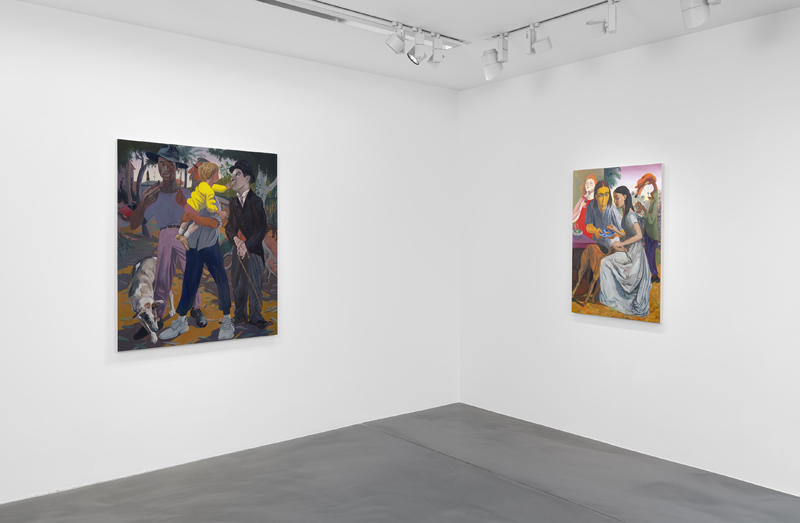

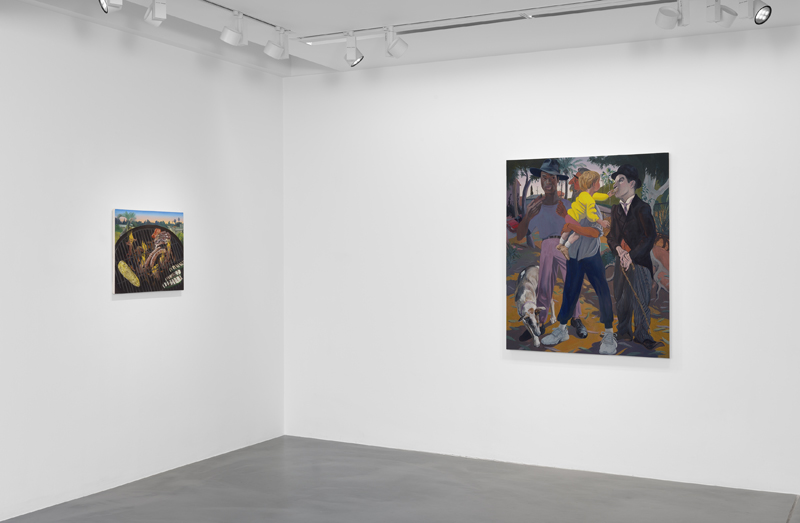
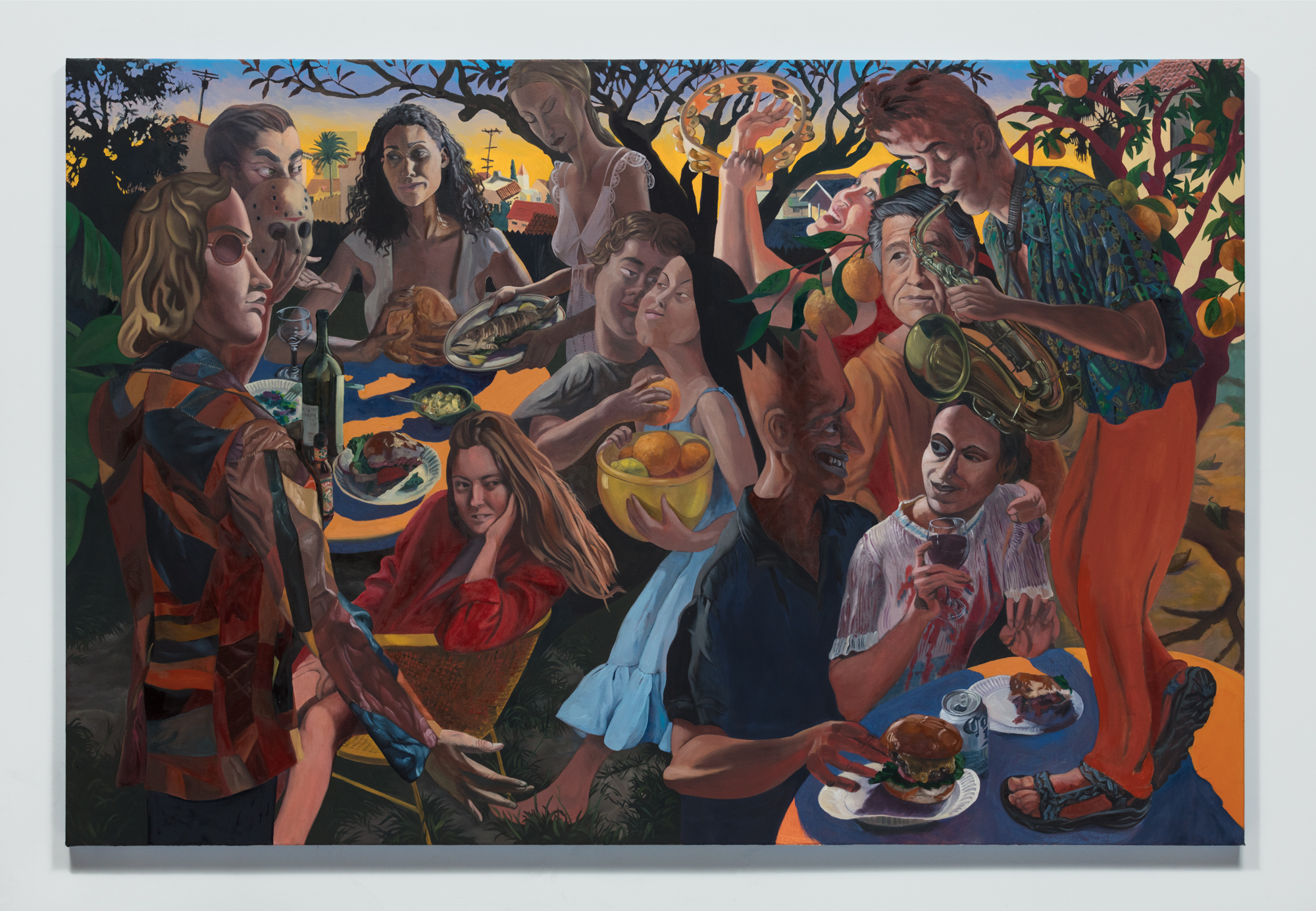
Welcome to Our Mess, 2017 oil on canvas, 48 x 72 inches
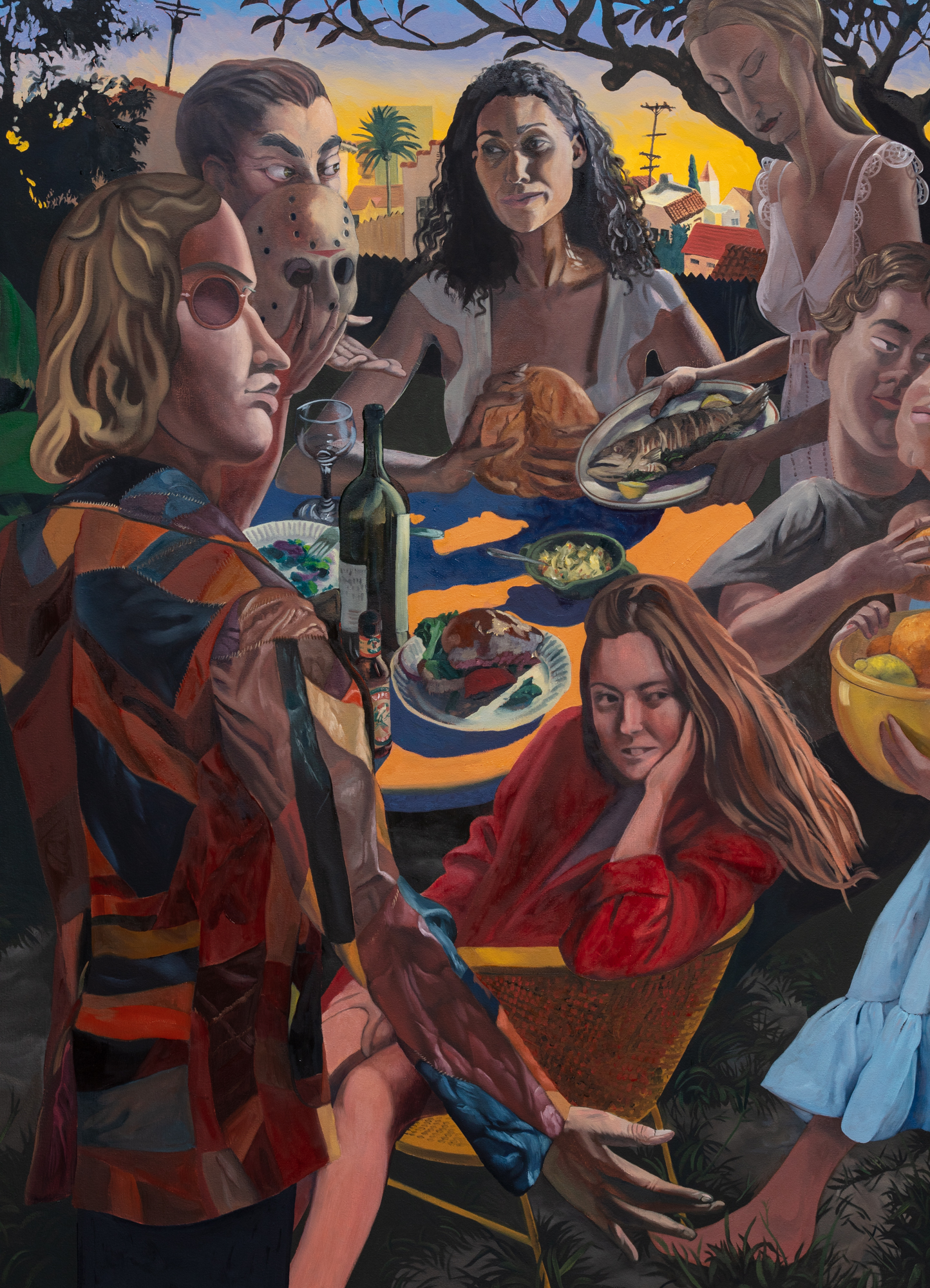
Welcome to Our Mess, 2017 (detail)

Welcome to Our Mess, 2017 (detail)

Welcome to Our Mess, 2017 (detail)
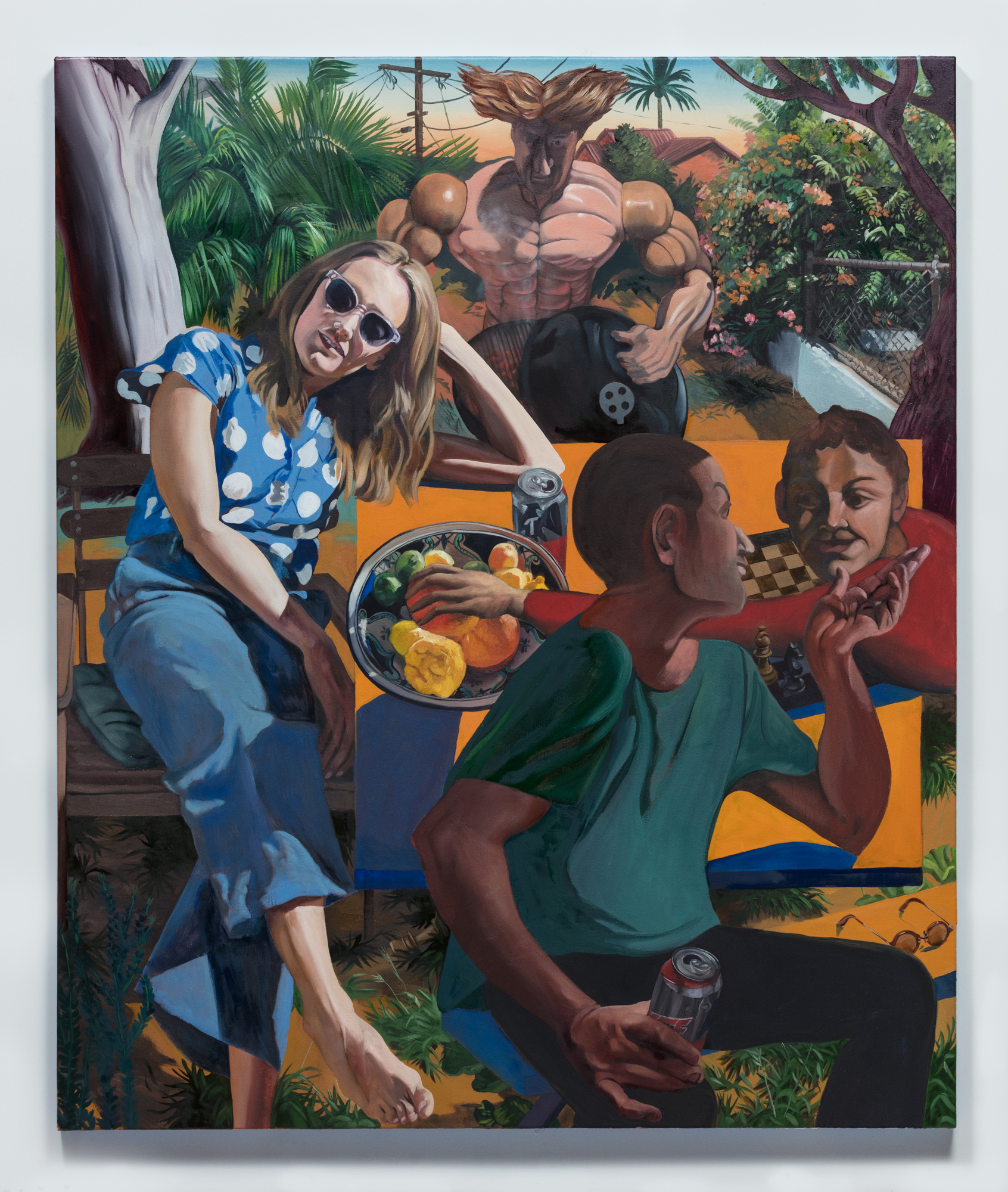
Yard Sale Hero, 2018 oil on canvas, 50 x 42 inches
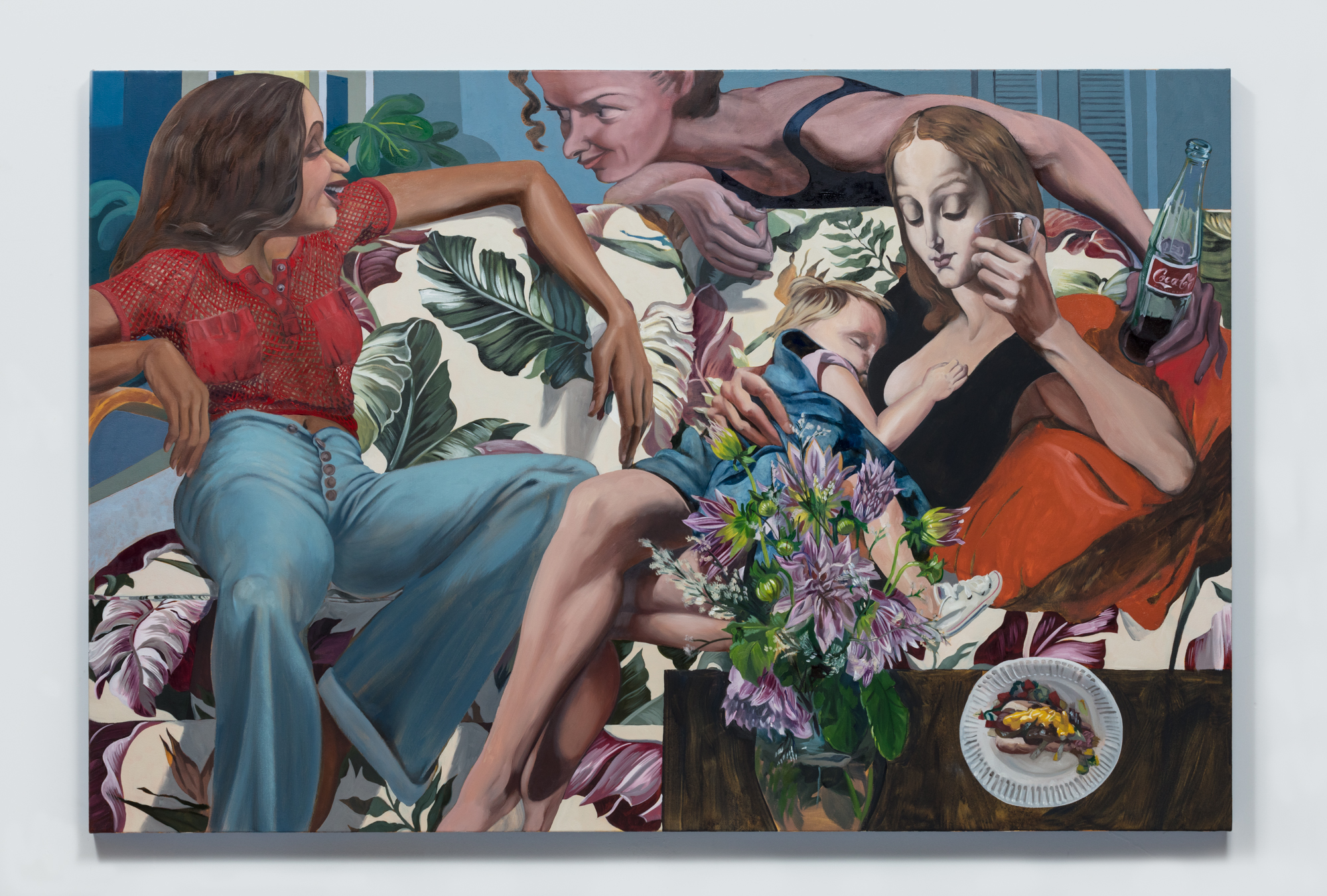
After party, 2018 oil on canvas, 40 x 60 inches
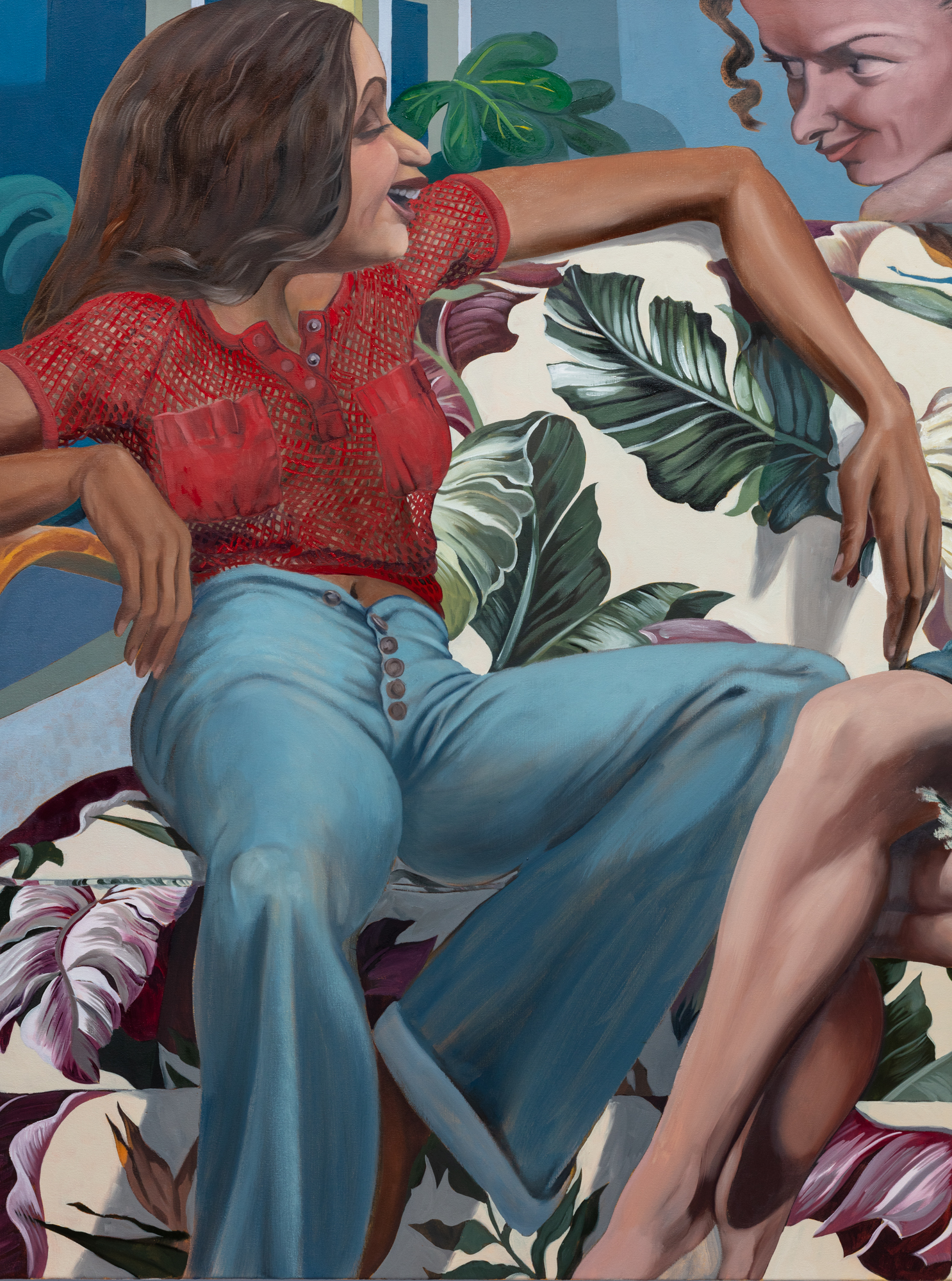
After party, 2018 (detail)
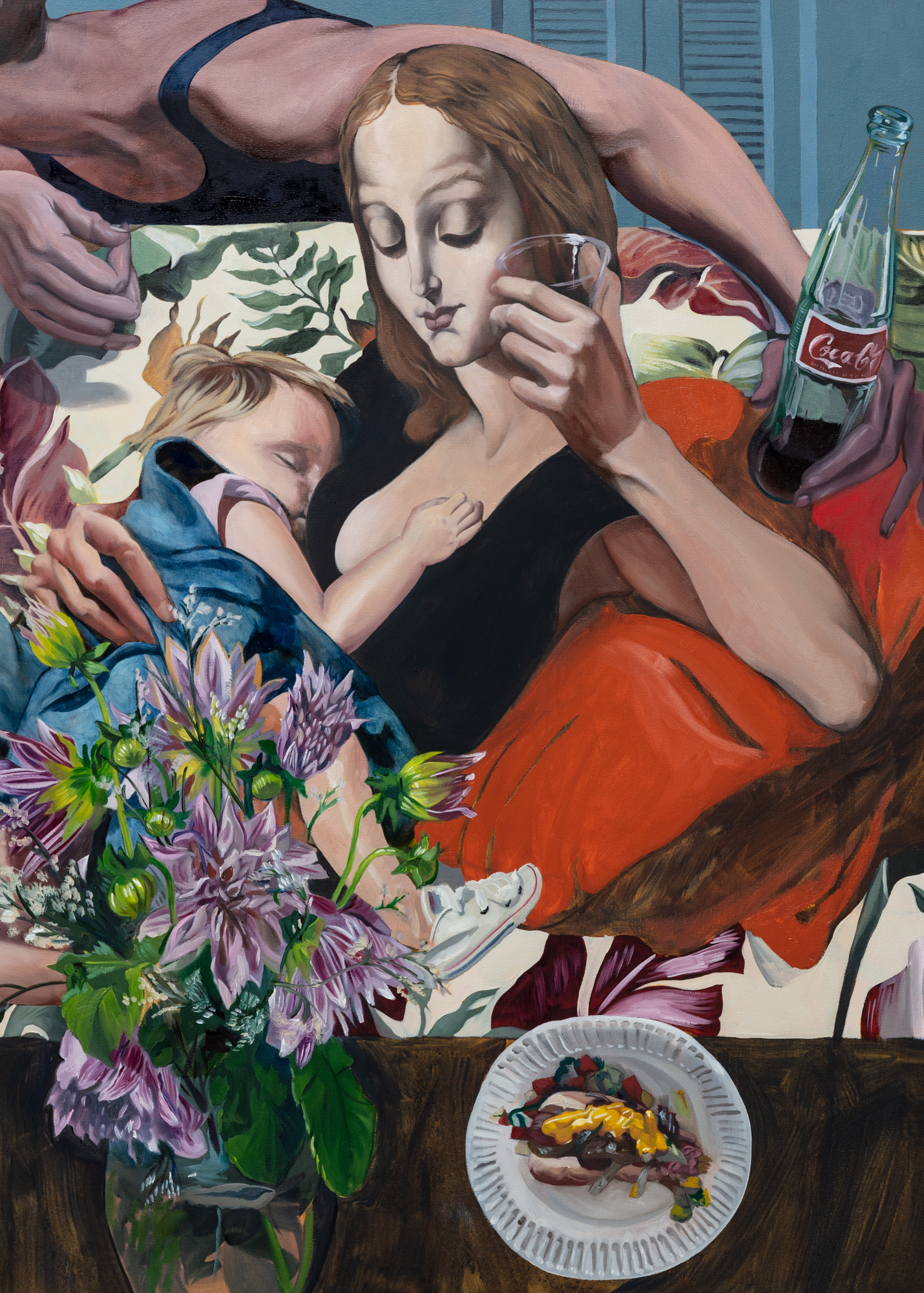
After party, 2018 (detail)

Isabella, 2018 oil on canvas, 41 x 27 inches
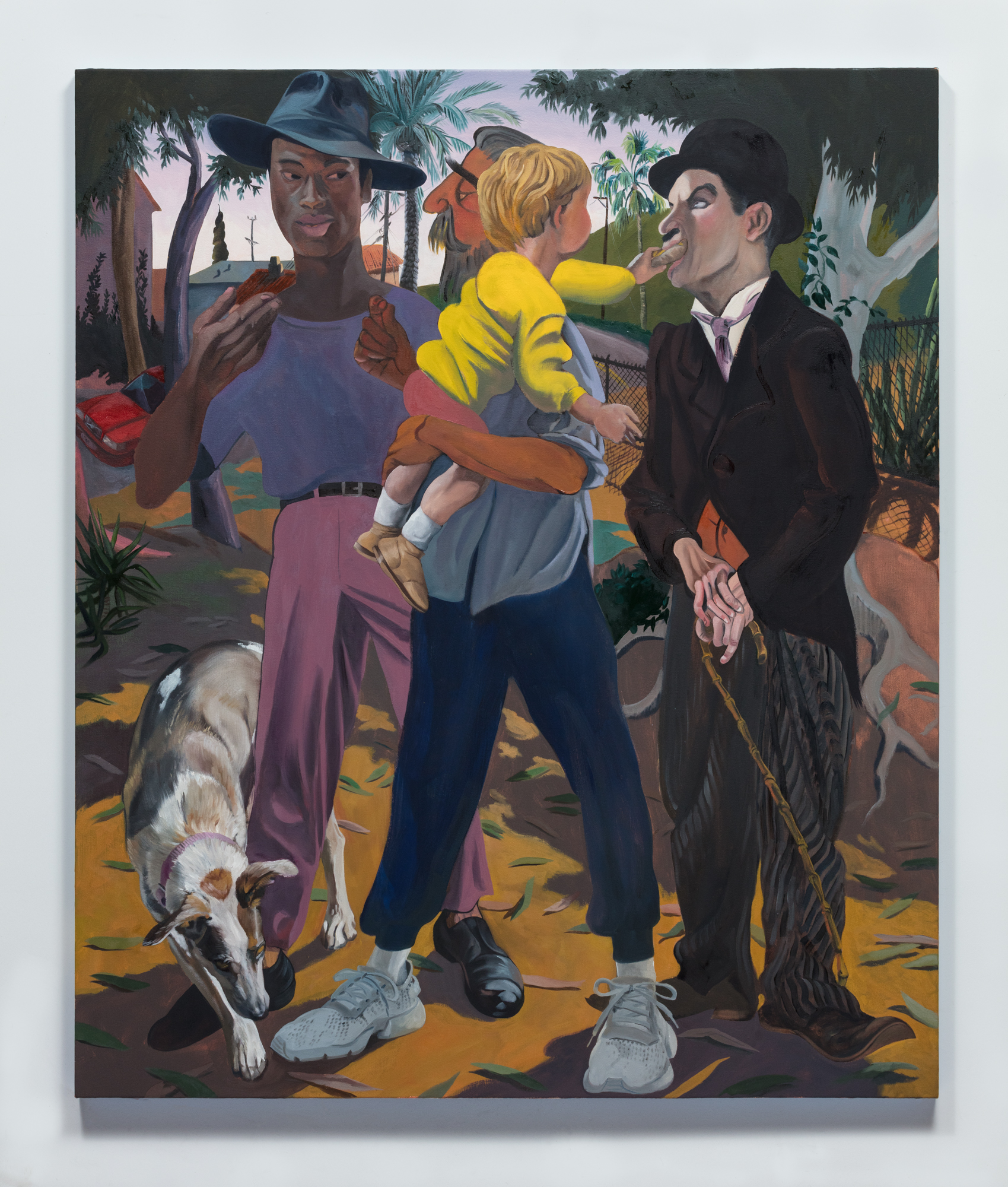
A tramp, a gentleman, a poet, a dreamer, a lonely fellow, always hopeful of romance and adventure, 2018 oil on canvas, 50 x 42 inches
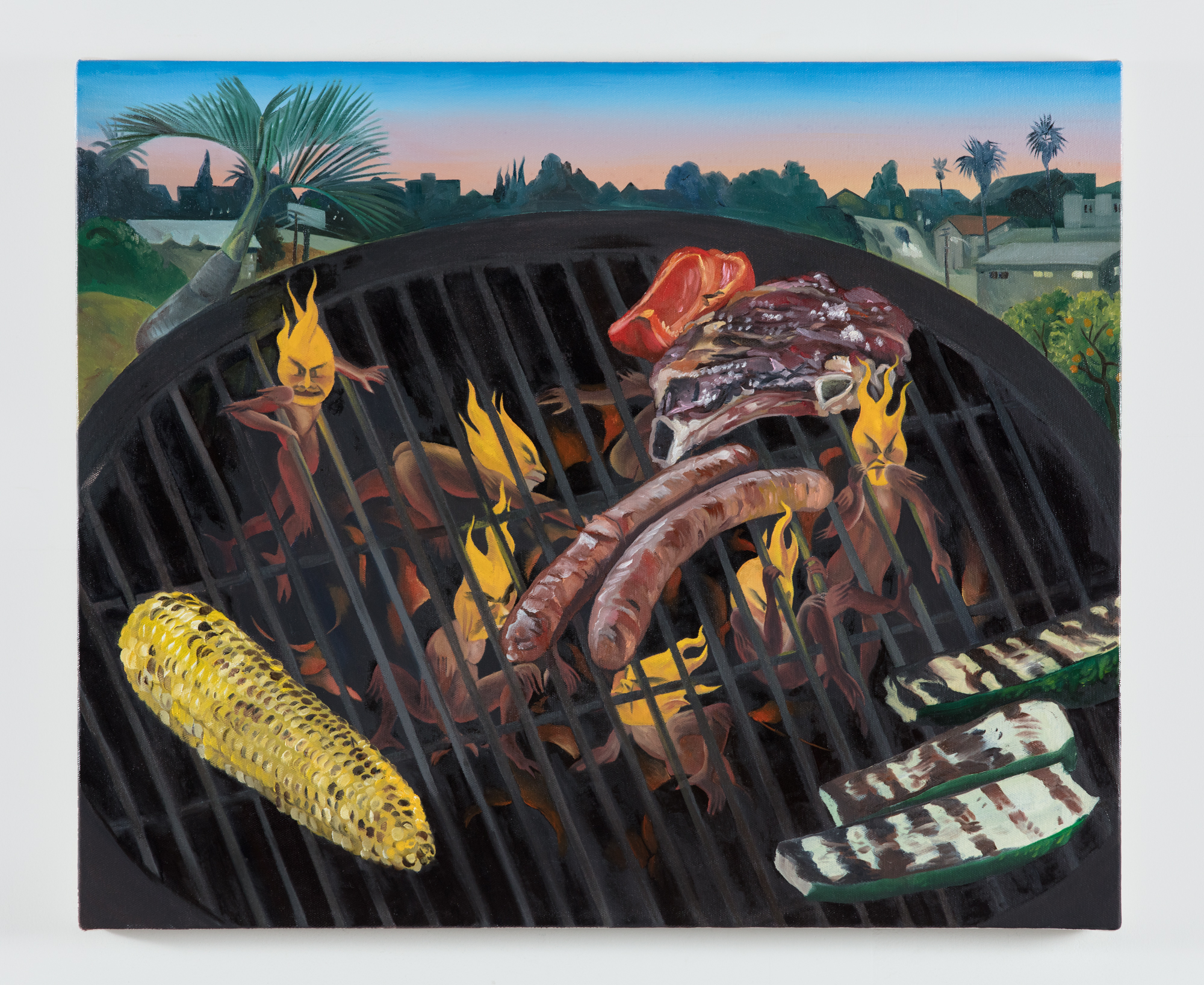
Gates of Eden, 2018 oil on canvas, 20 x 24 inches
As part of its Viewing Room programme, Simon Lee Gallery is pleased to present Welcome to Our Mess a solo exhibition by Los Angeles-based artist Justin John Greene, his first in the UK. This new suite of paintings offers a panorama of a sun-washed, tragicomic barbeque with scenes set against the background of an oddly utopic neighbourhood, in which themes of conflict and romance are paramount.
In these works, subject matter drawn from Greene’s personal surroundings – portraits of friends and family, plant-life and scenery from his life in Southern California – are juxtaposed with fictional elements that recall stylistic approaches and imagery drawn from other paintings, murals, films, and advertisements. His paintings present a collision of art-historical styles, referencing a diverse group of influences, including Baroque genre painting, social realism, Diego Rivera’s murals, Stanley Spencer’s religious paintings and R. Crumb’s satirical and scathing cartoons of American life. In these paintings, the artist brings together these numerous and seemingly disparate allusions in a series of tableaux. Greene stages the idea of the backyard barbeque as a mythical vision and reveals a tension between the imaginary and the real, the spiritual and the mundane, propaganda and truth. While his style evokes a sense of realism, his subject matter propels the viewer into another realm, at once strangely familiar and completely alien.
Beneath the surface of these seemingly utopian scenes Greene’s paintings have an undeniably dark quality and can be read as social allegories that transform the all-American idea of the “backyard barbeque” into a coded means by which to interrogate prevalent socio-political issues. While the notion of a barbeque conjures up sensibilities of freedom and pleasure, it is also typically a site of macho posturing; its cultural positioning is therefore controversial. Greene seizes on both concepts, and in his hands the barbecue scene is at once relaxed and debauched. Similarly, the term ‘backyard’ has become a metonym for anxieties regarding the quality of life – for example, the phrase “Not In My Back Yard” is a characterisation of opposition by residents to a proposed development in their local area. On the other hand, a backyard can be a meeting place, a space for games and outdoor gatherings, and a place to nurture positive neighbourly relations. However, it is only a space of supposed freedom and openness as most backyards are bordered by fences. In one small painting Greene depicts a scene of a barbeque grill that doubles up as a gate – a simple scene that exudes an air of disquiet, setting the tone for the other works in the exhibition.
A Dusk That Never Settles
- ThrowBack Thursday, 2014, oil on canvas, 18 x 24 inches
- The Breeze and I, 2014, oil and airbrush media on canvas, 60 x 84 inches
- A Dusk That Never Settles, 2014, oil on canvas, 48 x 60 inches
A Dusk That Never Settles at Actual Size, Los Angeles, CA, June 23 – July 19, 2014
https://www.actualsizela.com
With sunset over Glendale, two fair maidens peered downward
caught foul and unaware o’ how they’d crashed so violently east
wondering if the embattled waves smashing every bit of coastal aspiration and personal dignity
could, in truth, possess the unbridled force necessary to beat and bury them in this occident
the smell of an hour lined with dirt, not evidenced by hands or lines crossed their brows
curious and desperate, they asked Orleans, “Will it never be morning?”
The white cirrus overhead taunted the heroines like an inch of snow on December fourth
—life was a cold bitch with a runny nose
movement was all around them and yet they stood implacably still
until
a grizzled veteran with a psyche full of foes
let his damaged and feverish rod out of its clothes
Ursula looked at him and she laughed and she cried
Violette saw nothing, said nothing, jumped onto Glendale and died
Ursula wept for a thousand and one days
and when her eyes dried and her blouse wrung out,
she exited the haze
for a blinding white light
a voice like her mother’s assured her all would be right
as the John from Arcadia plunged his prick into the night
penetrating her maidenhood like only a first love could
She thought of Lawrence, Kansas and how she wished she was from there
and all of the emotional groups she loved from there
and how she cried to their music with her short pixie fair hair
thirteen years old, bleached, stoplight on the corner of Moorpark and Victory
At that moment, life was a loss but her overall record was over five hundred and one day she saw herself living
in Verona or Florence maybe Rome or at the very least Venice
where the surf was cheap and everyone was inked up and orange and pounding all their flesh
till the drops came raining violently down to clear out the concrete pastures and make way for a peerless Silence.
–Eugene Kotlyarenko, 2014–
